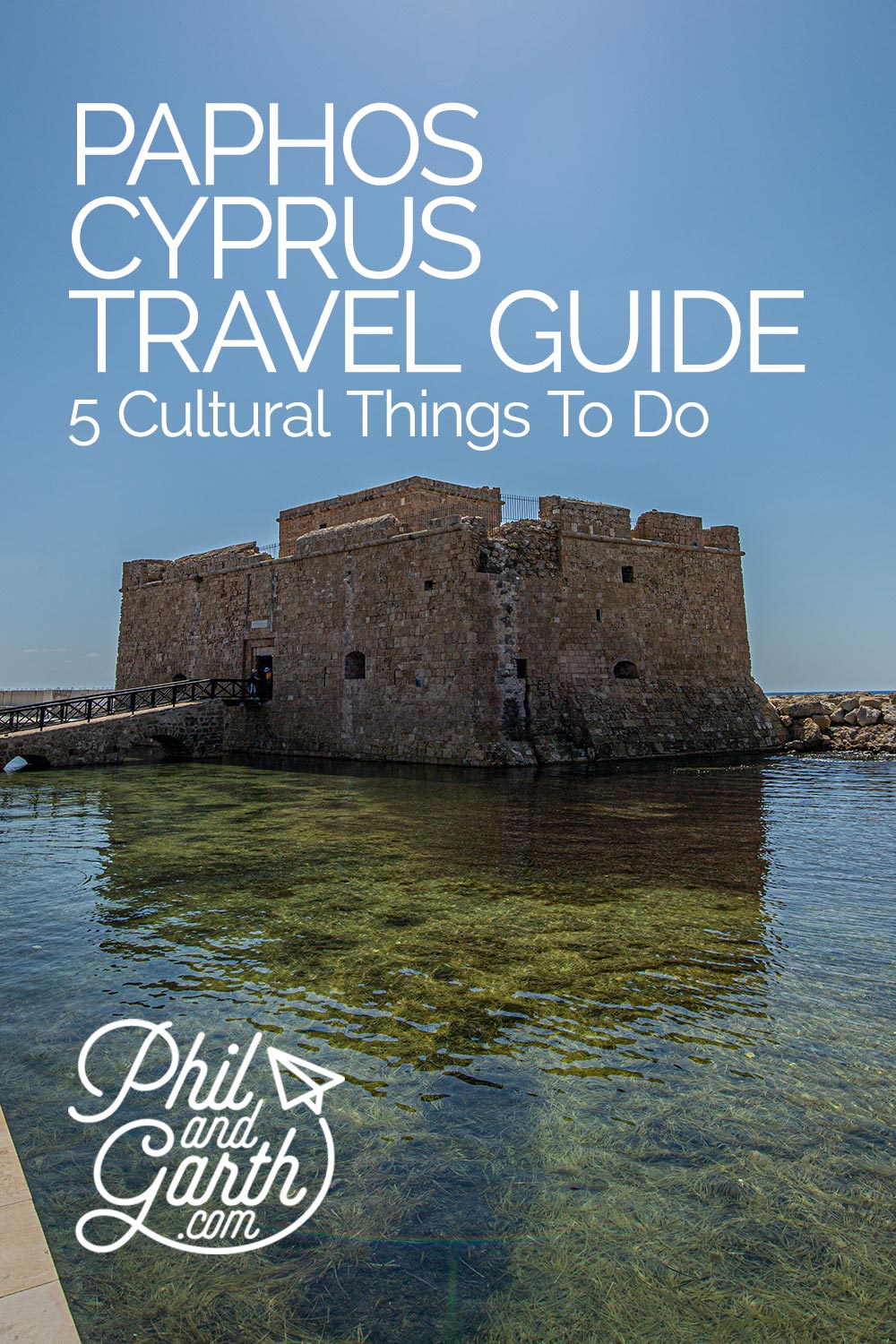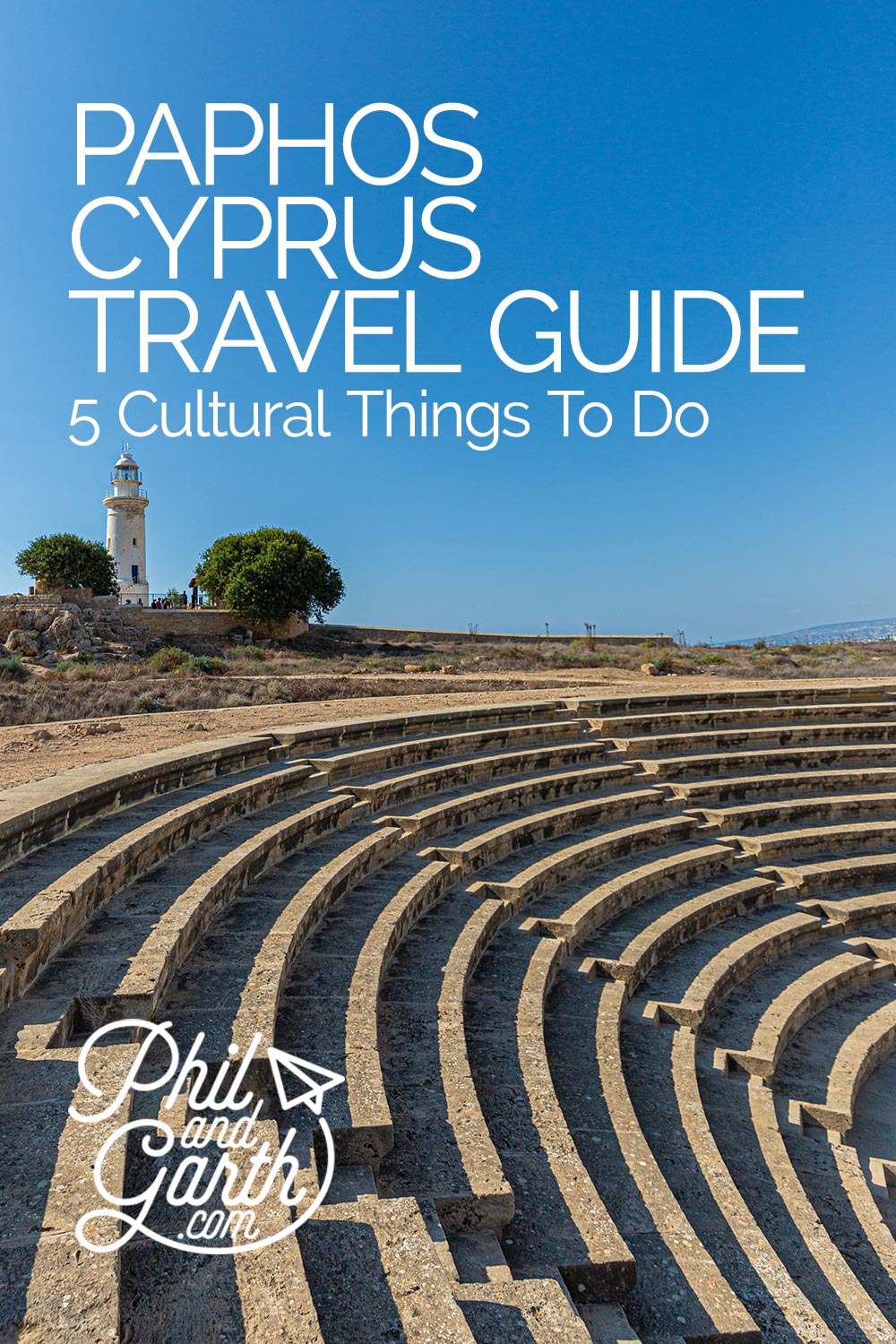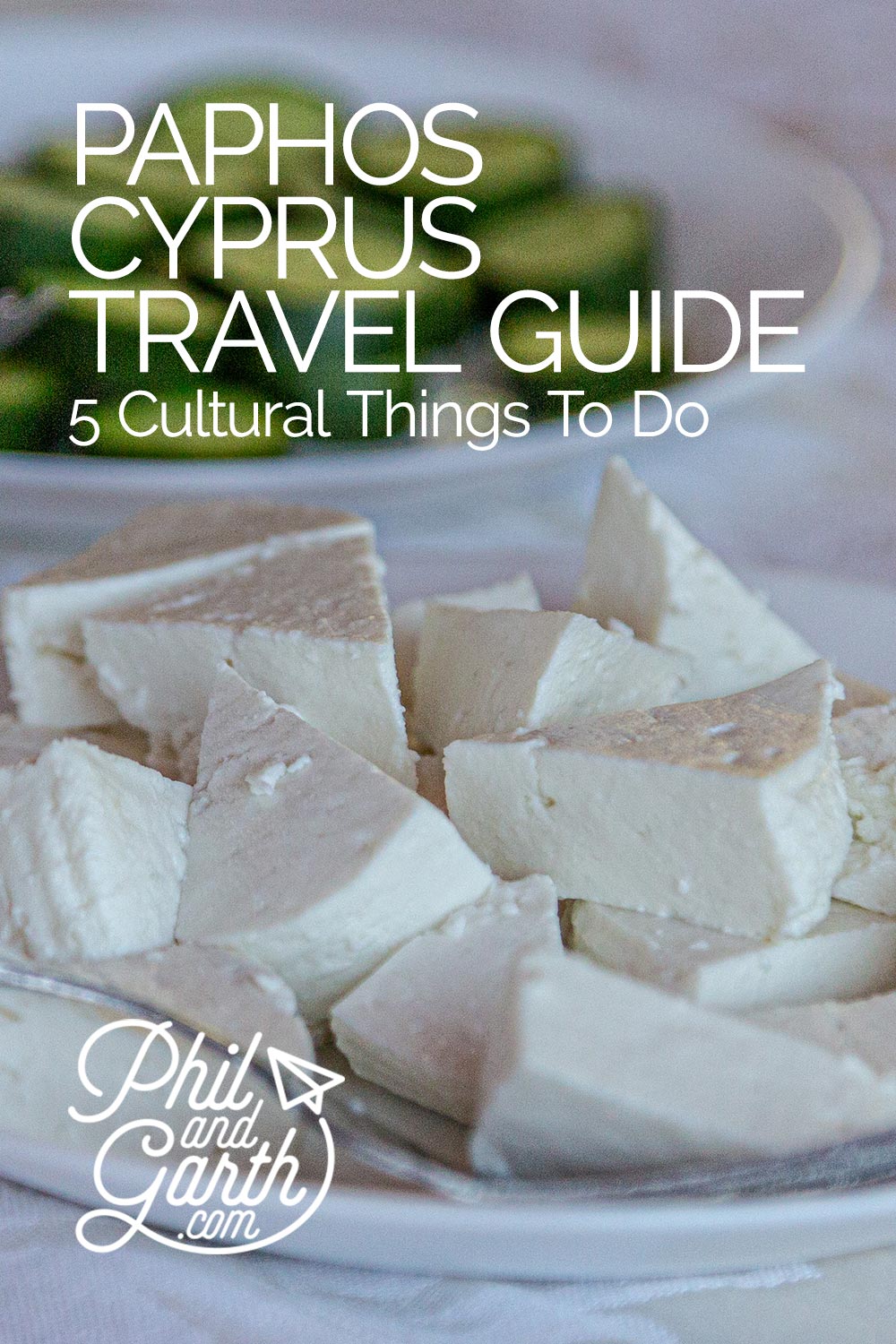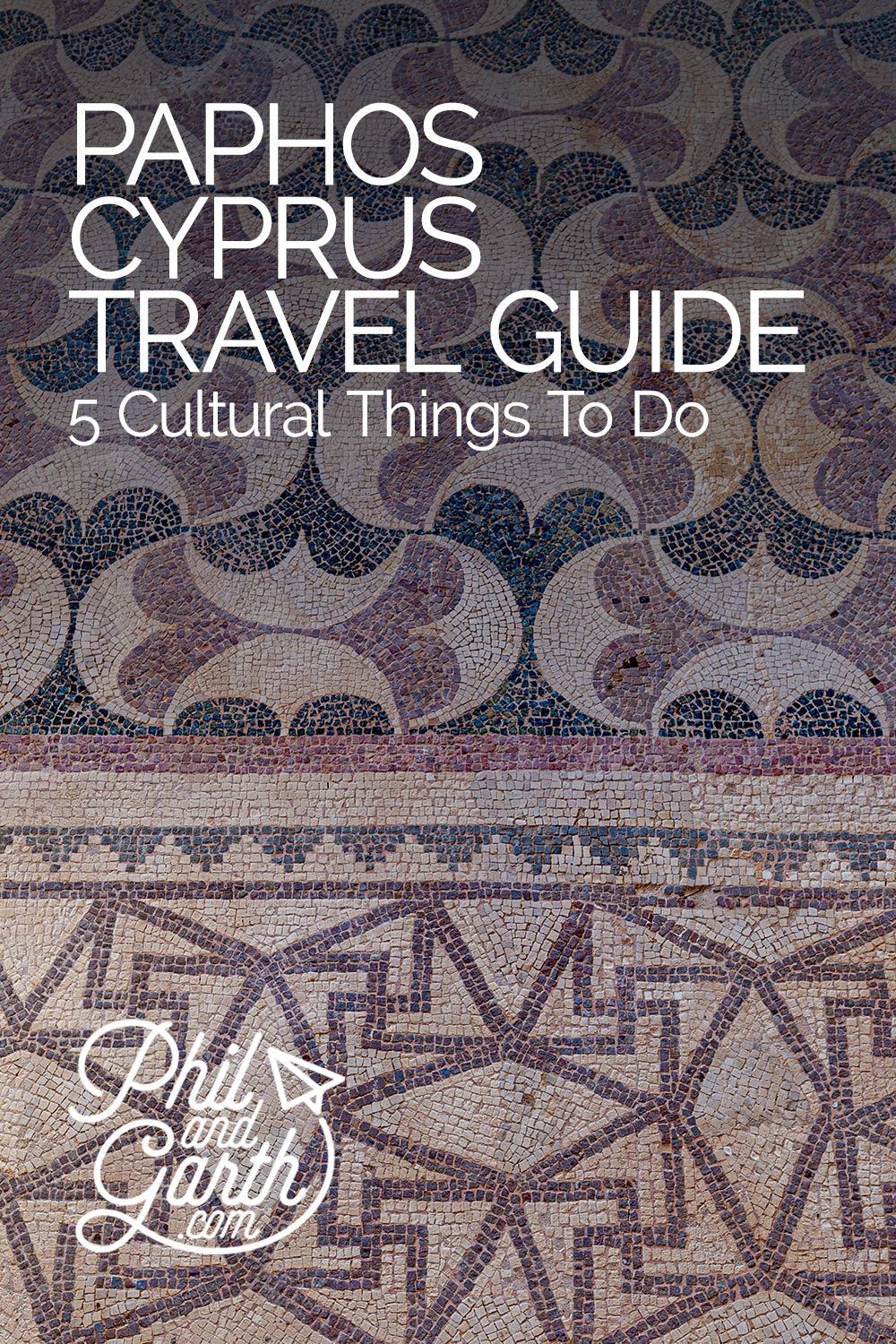Last updated: 3rd February 2024
Cyprus is the original ‘Love Island’ said to be the birthplace of the Greek goddess of love, Aphrodite. So where better for us to head for a romantic autumn holiday! Cyprus is famous for long summer days, ancient ruins and perfect beaches. In this travel guide to Cyprus we’ll show you our top 5 cultural things to do in Paphos on the Greek speaking south side of the island.
Table of Contents
About Cyprus
40 miles south of Turkey lies Cyprus, the 3rd biggest island in Mediterranean. Cyprus bears the marks of the many empires that once ruled including the Romans, Ottomans and the British Empire until 1960 when Cyprus gained its independence and became an island nation. However Cyprus has been politically divided since 1974 when Turkey invaded the north of the island. Ever since its been divided into 2 parts, including through the capital Nicosia. Greek Cypriots live in the south whilst Turkish Cypriots live in the north. There’s a buffer zone between the 2 sides controlled by the United Nations.
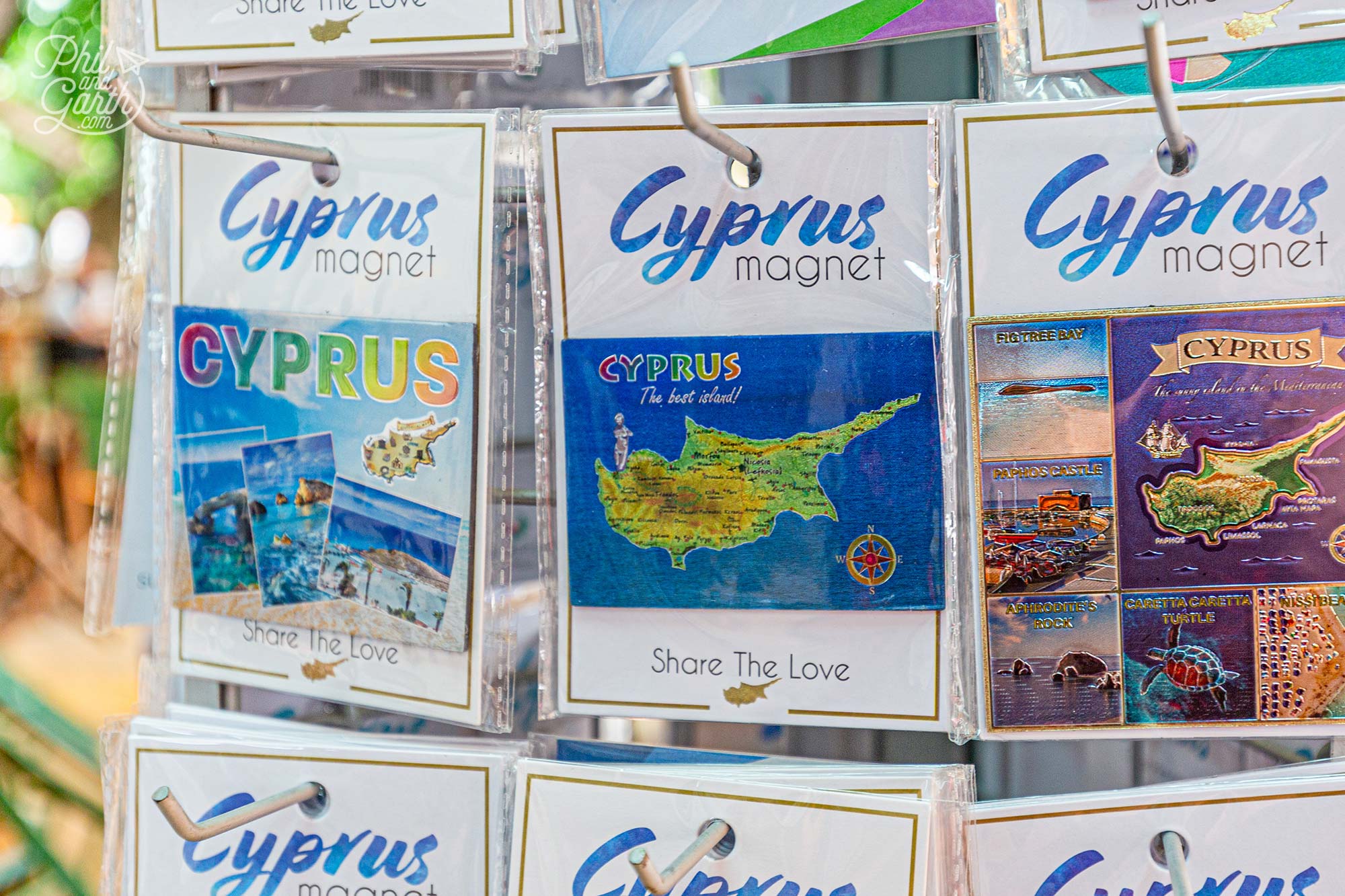
Cyprus fridge magnets – our must have souvenir!
Brits love Cyprus and many retirees have made it their home. Cyprus has a sub-tropical climate which means it enjoys around 320 days of sunshine every year. Winter in Cyprus offers some of the warmest temperatures you’ll find in the Mediterranean. The north has pine clad mountains, whilst the south is flat with a rocky coastline and glorious Blue Flag awarded beaches boasting some of the cleanest waters in Europe. The Mediterranean sea is idyllic and beautifully turquoise and surprisingly warm for swimming.
5 Cultural Things To Do In Paphos, Cyprus
1. See the mosaics at Kato Paphos Archaeological Park
Paphos must see attraction is the Kato Paphos Archaeological Park located next to the harbour. It’s pretty huge! so be prepared for lots of walking. It’s kinda like a mini Rome bursting with ancient ruins. It’s also a UNESCO world heritage site with remains from the Roman and Middle Ages. The park is where New Pafos (New Paphos) – the ancient capital city was built in the 4th century BC. The site was discovered by a farmer in 1965 whilst he was working on his property, which reminded us of a similar tale of a farmer who discovered the Terracotta Army in Xian, China. Today the Paphos archaeological site is still being excavated, so no doubt more treasures will be found.
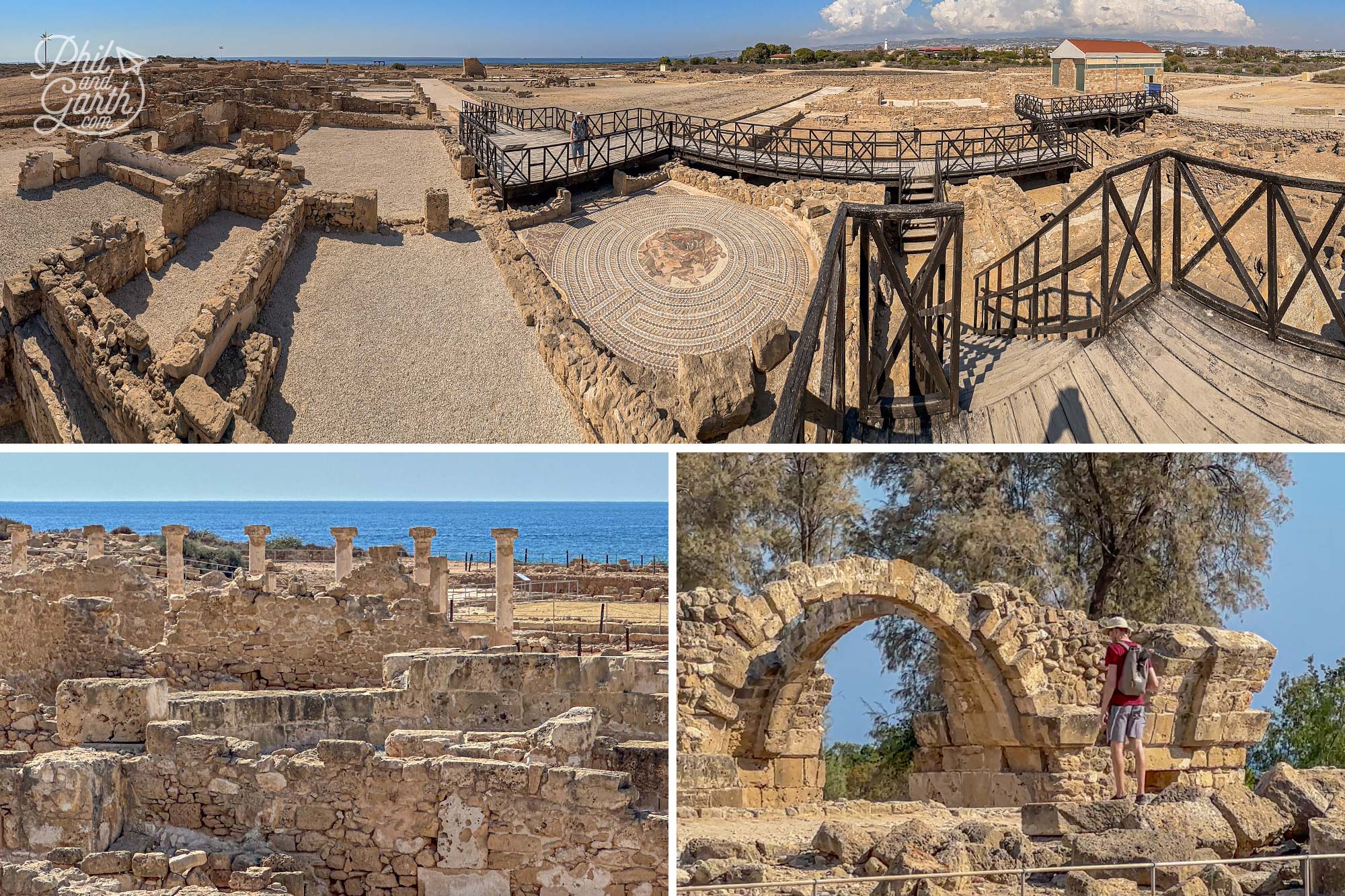
Kato Paphos Archaeological Park
The star attraction are the well preserved Roman mosaic floors, some of the best remaining examples in the world. These beautiful floors once lined 4 separate Roman villas – Theseus, Aion, Dionysos and Orpheus. The House of Dionysos have the best mosaics depicting tales of Greek mythology and scenes of hunting. Named after the god Dionysos who features on the mosaics. It’s really mind blowing looking at these beautiful mosaics to think they are over 2,000 years old! We could only imagine the grandeur these richly decorated villas must have been.
House of Dionysos
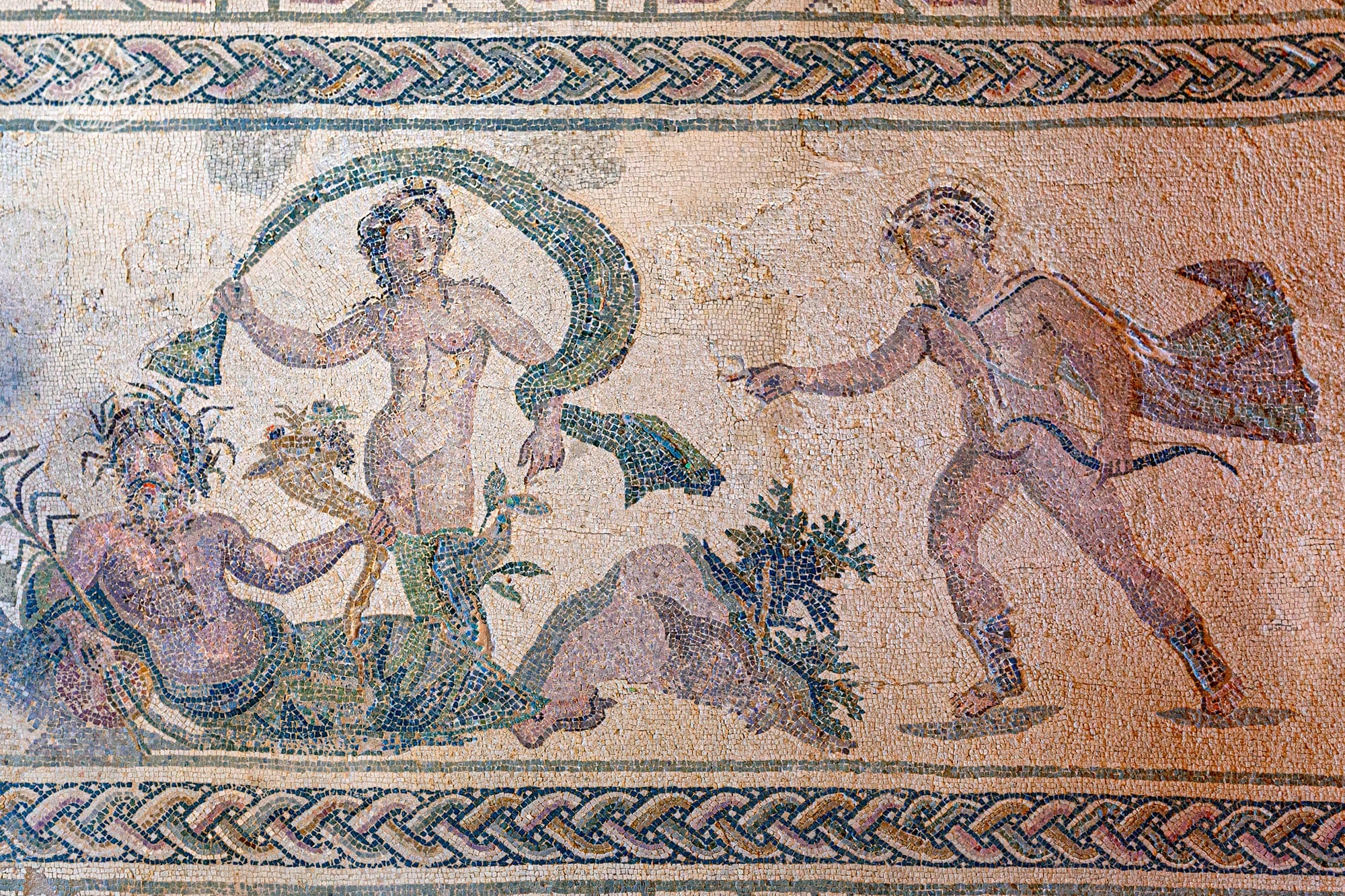
Mosaic of Apollo and Daphne in the House of Dionysos
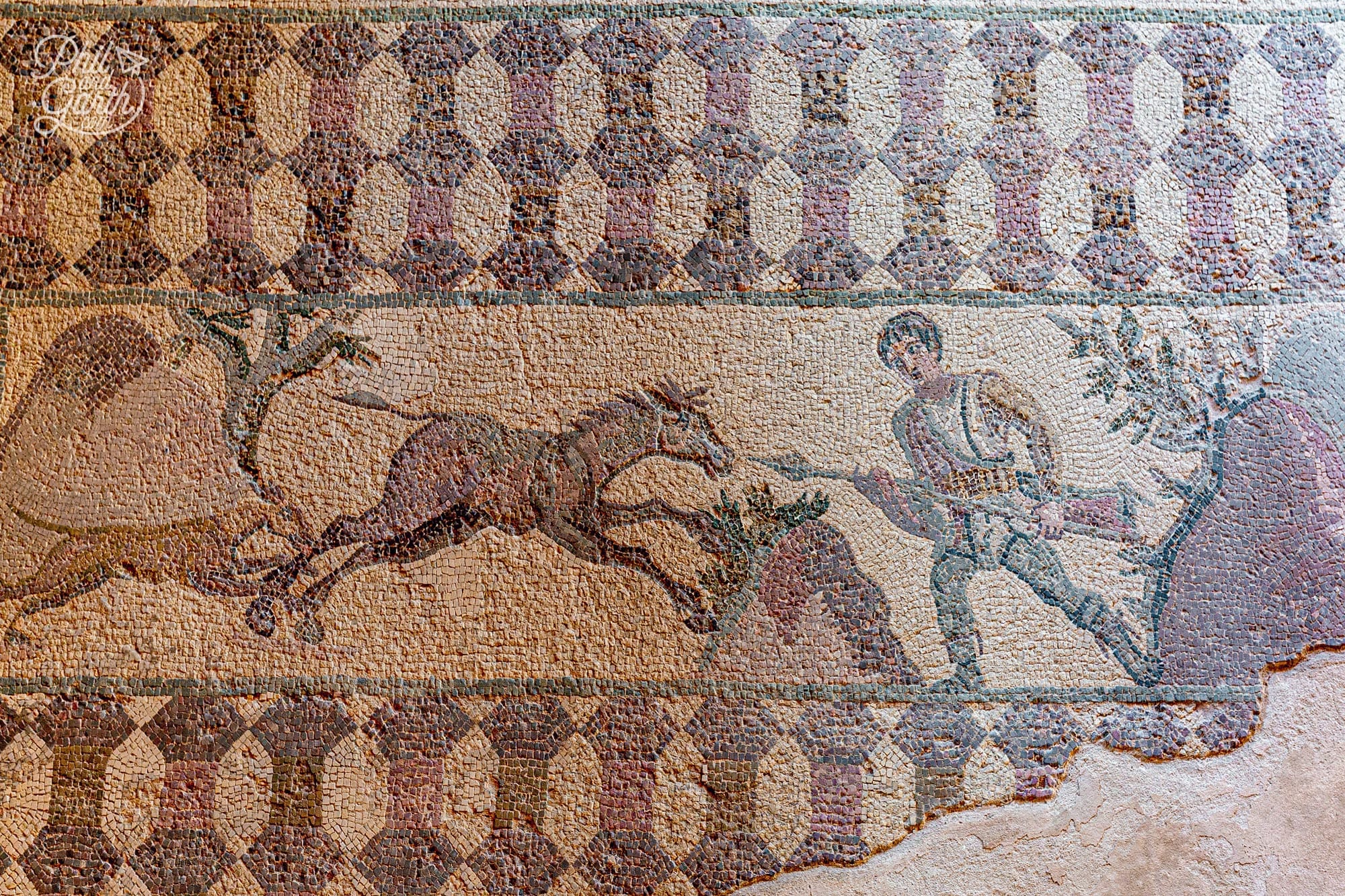
A hunting scene in the House of Dionysos
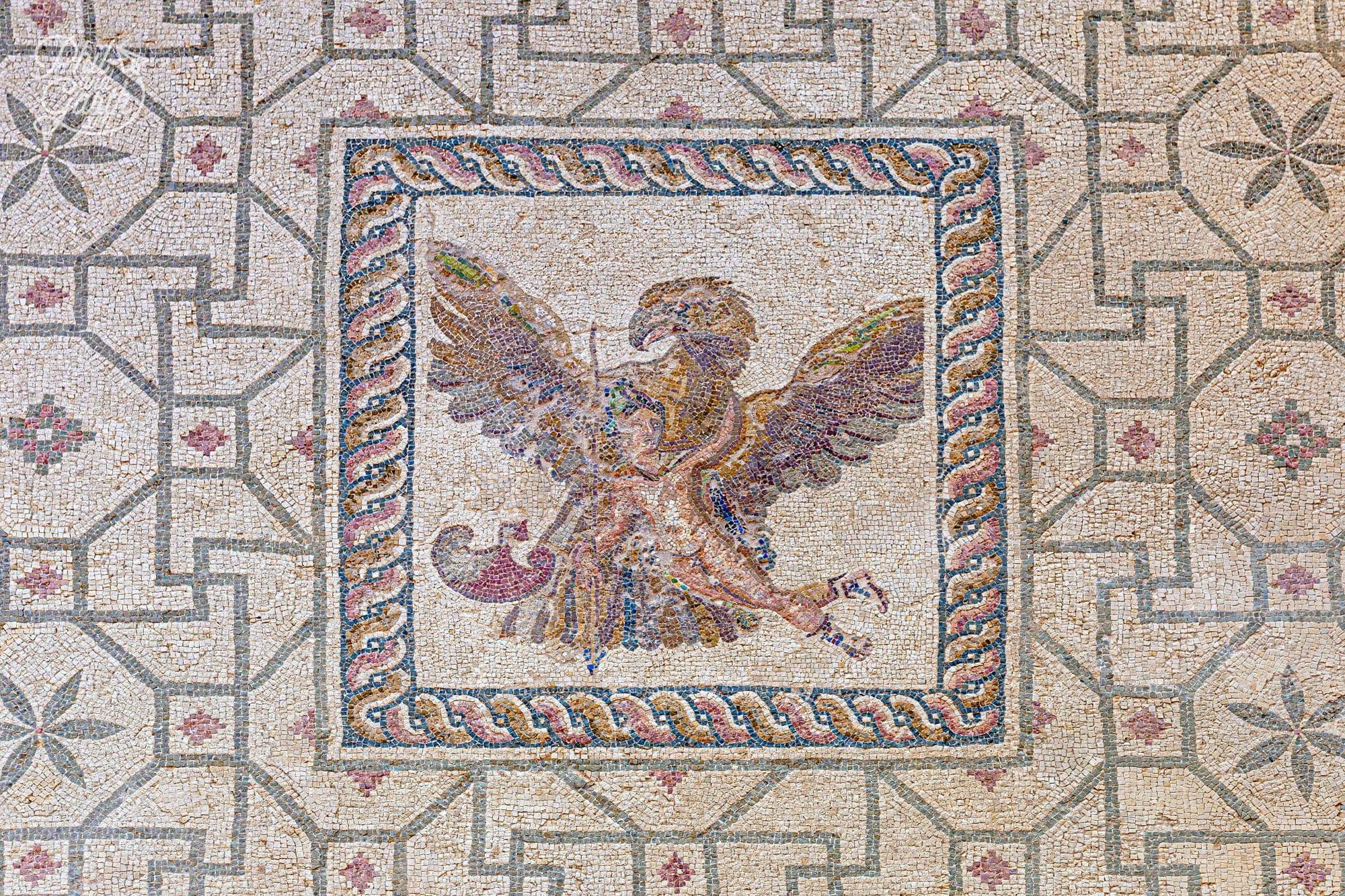
Mosaic of Zeus abducting Ganymede in the House of Dionysos
House of Aion
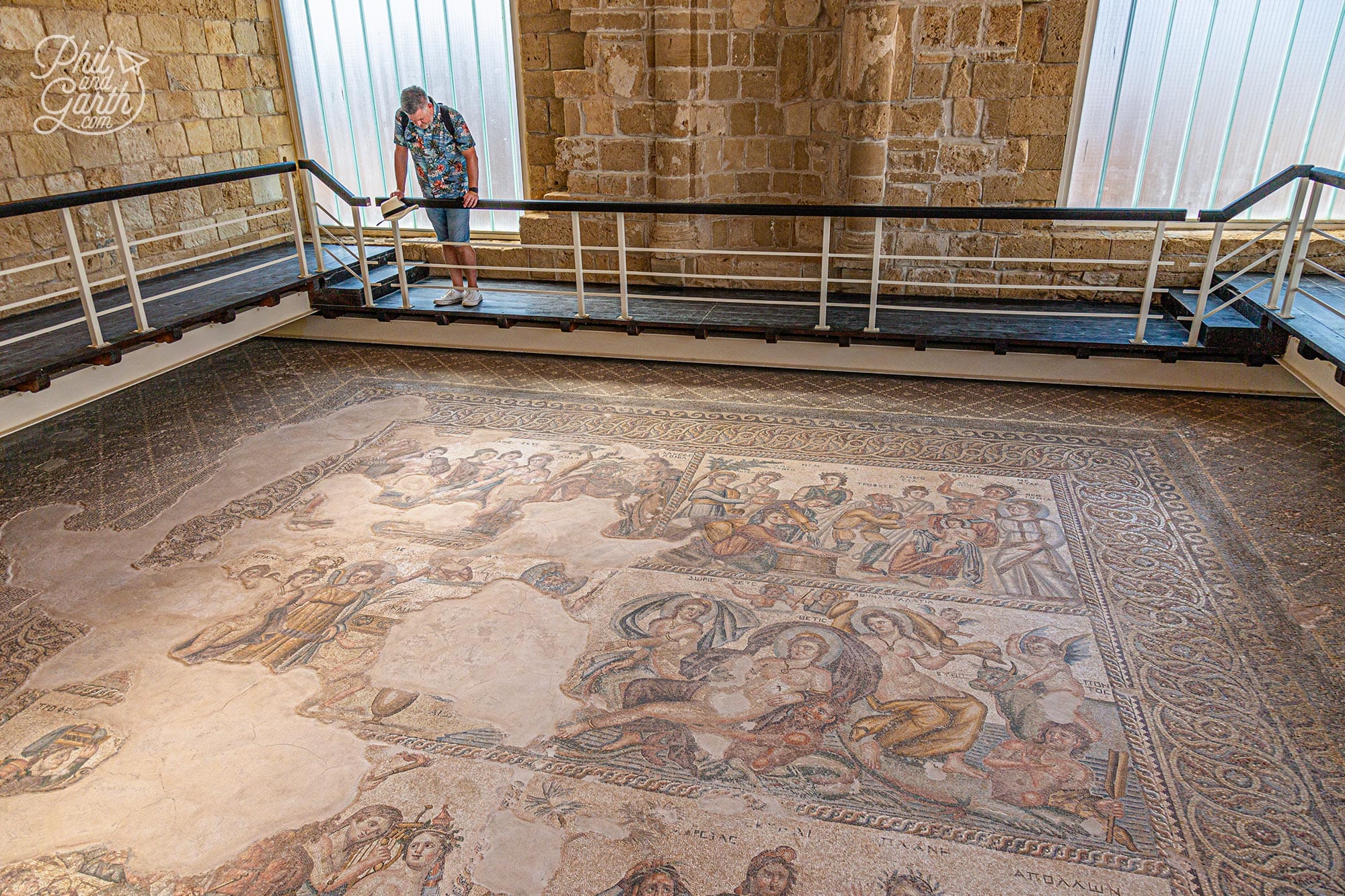
Phil checking out the mosaic floors in the House of Aion
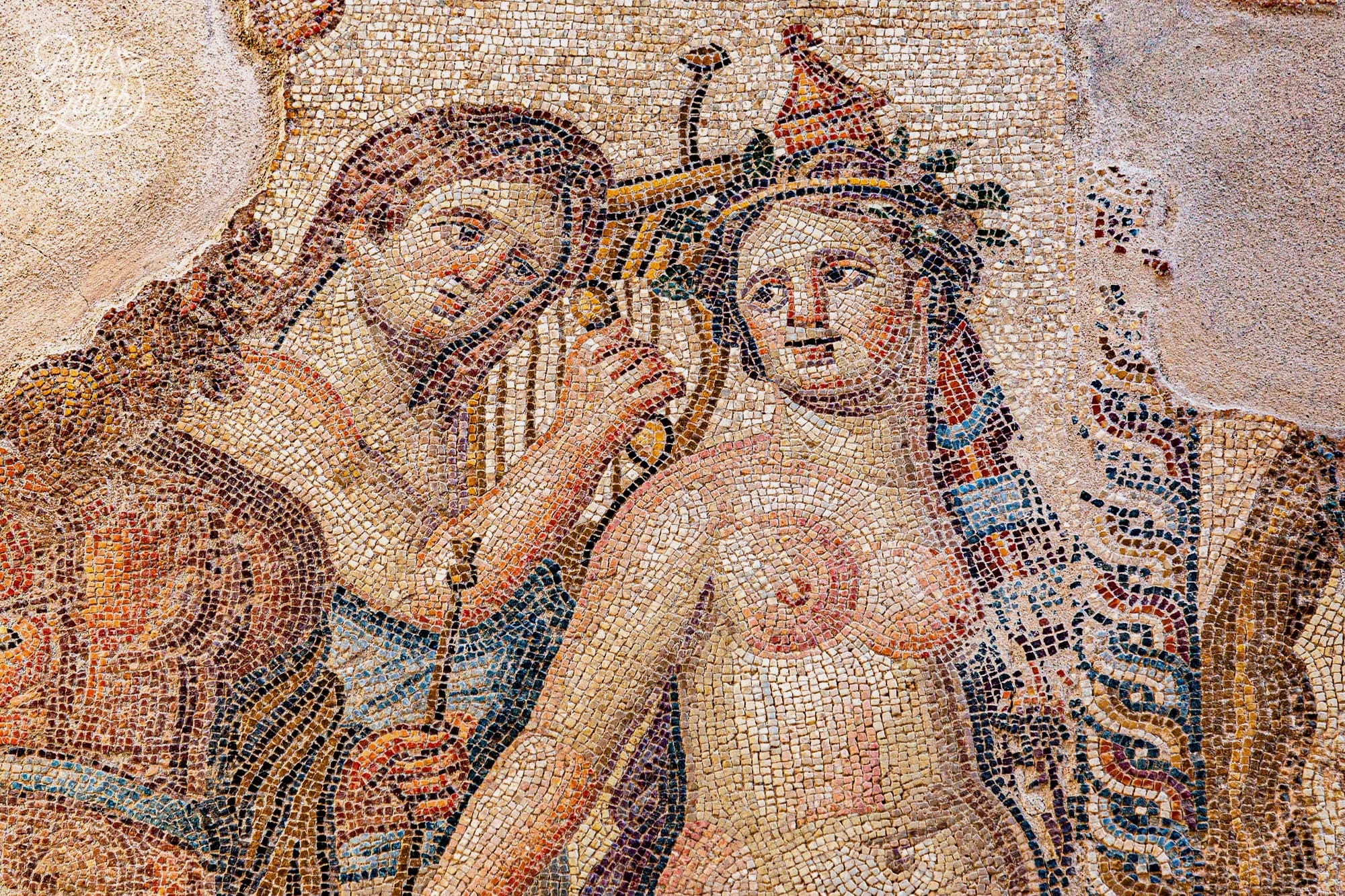
The mosaic of Triumph of Dionysos – Centaur and Maenad inside the House of Aion
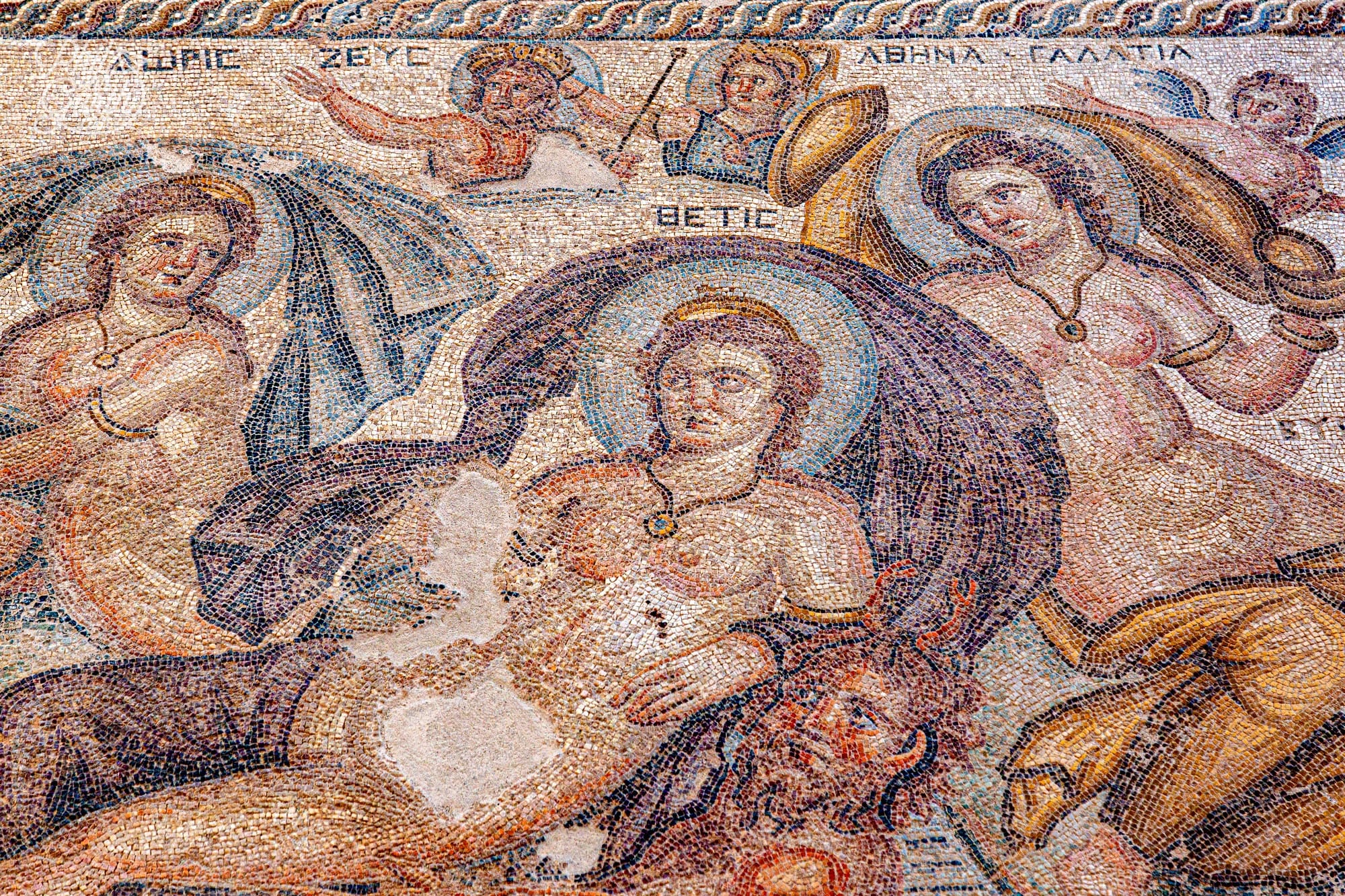
Mosaic of Nereides and Bythos, House of Aion
House of Theseus
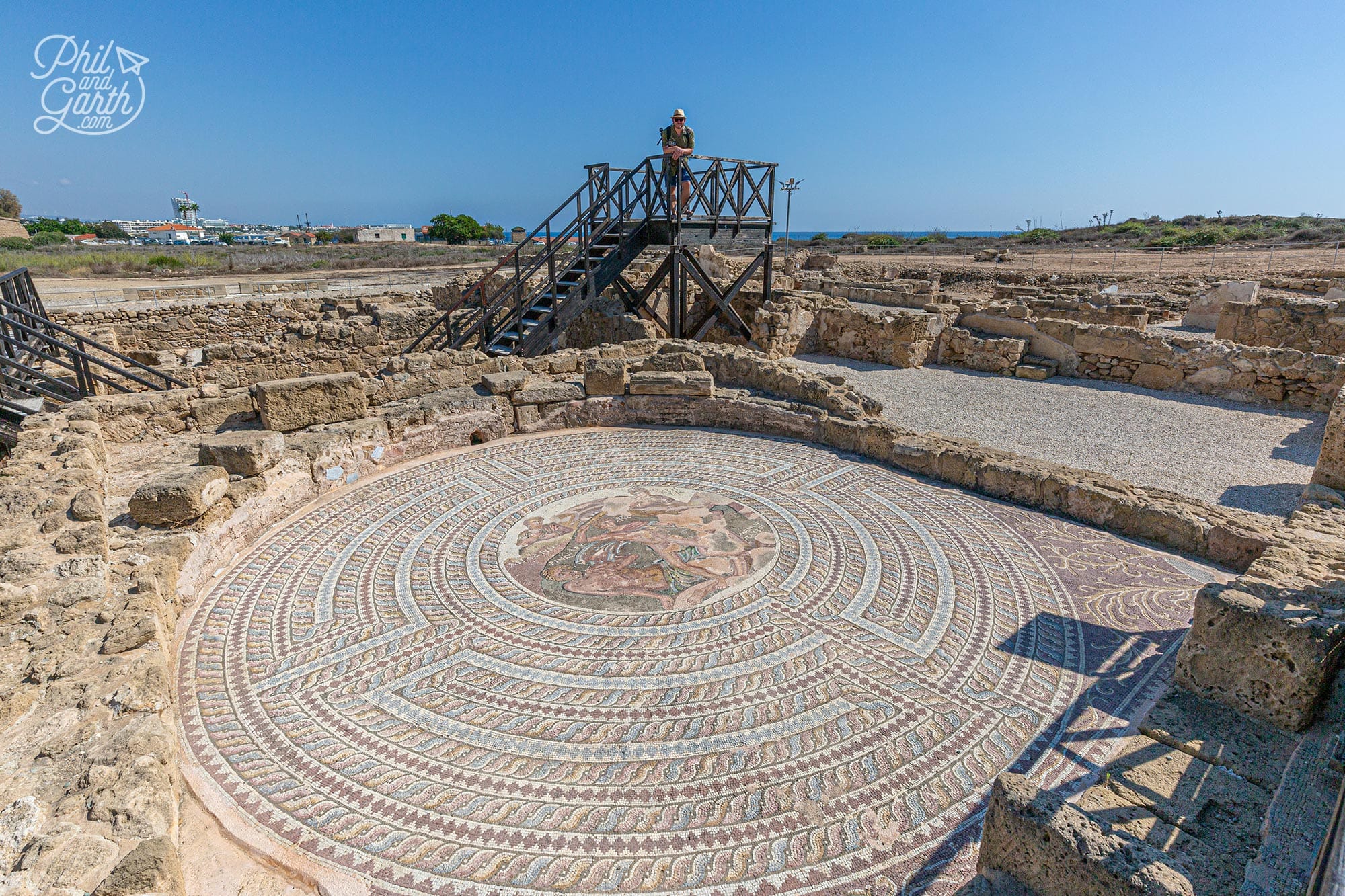
Garth looking down on the House of Theseus
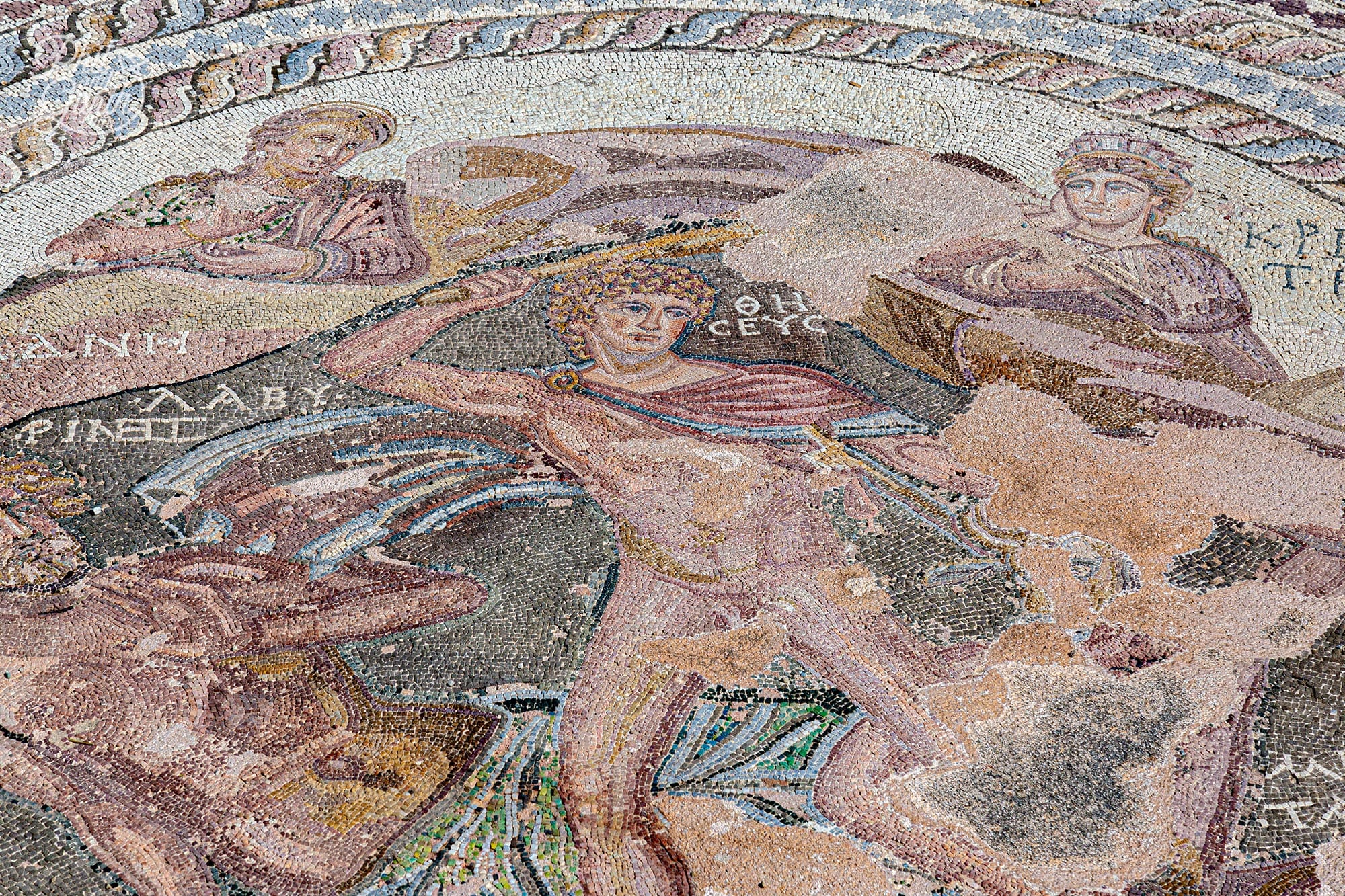
Close up of the Theseus Mosaic
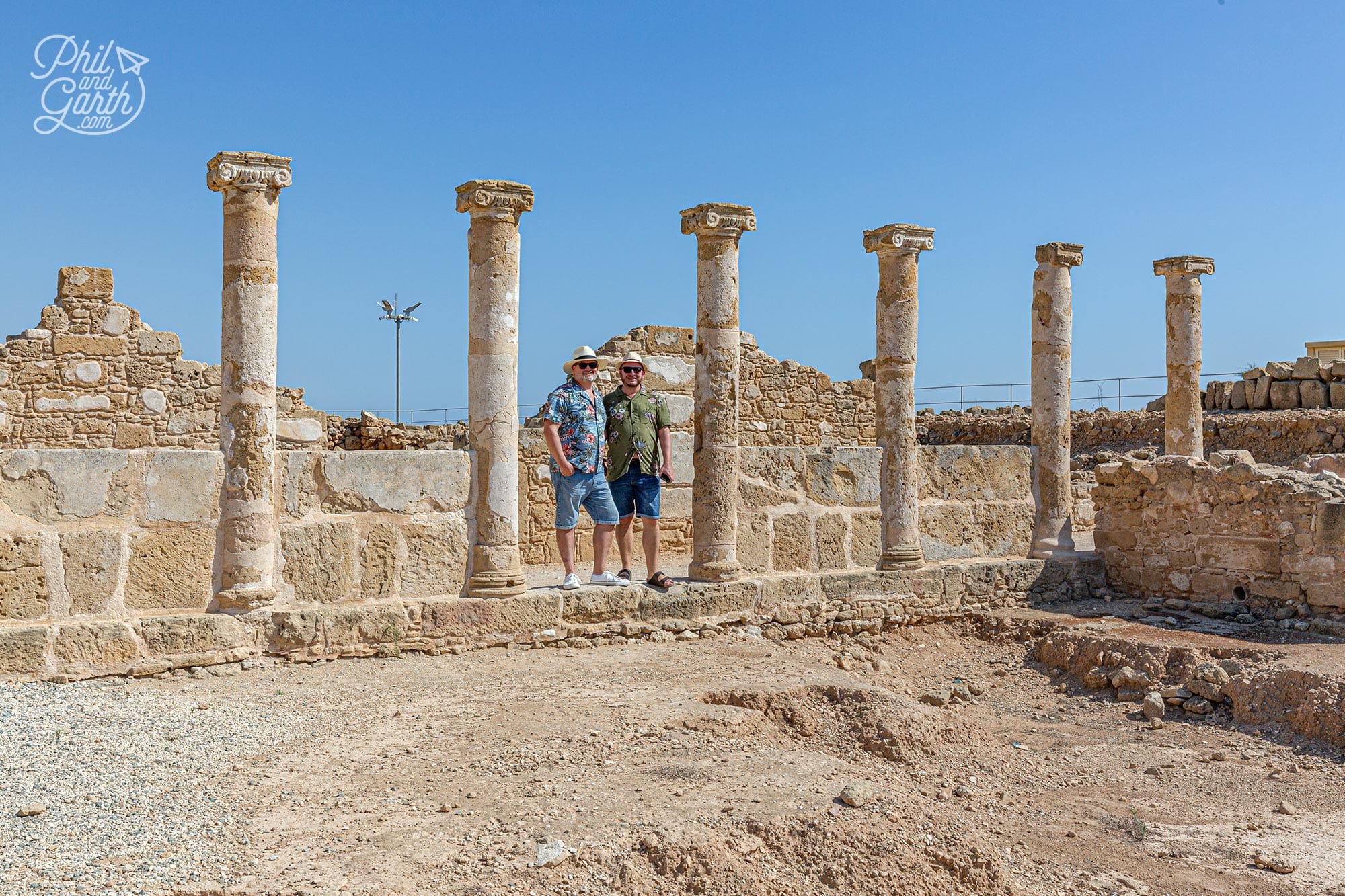
Phil and Garth in the House of Theseus
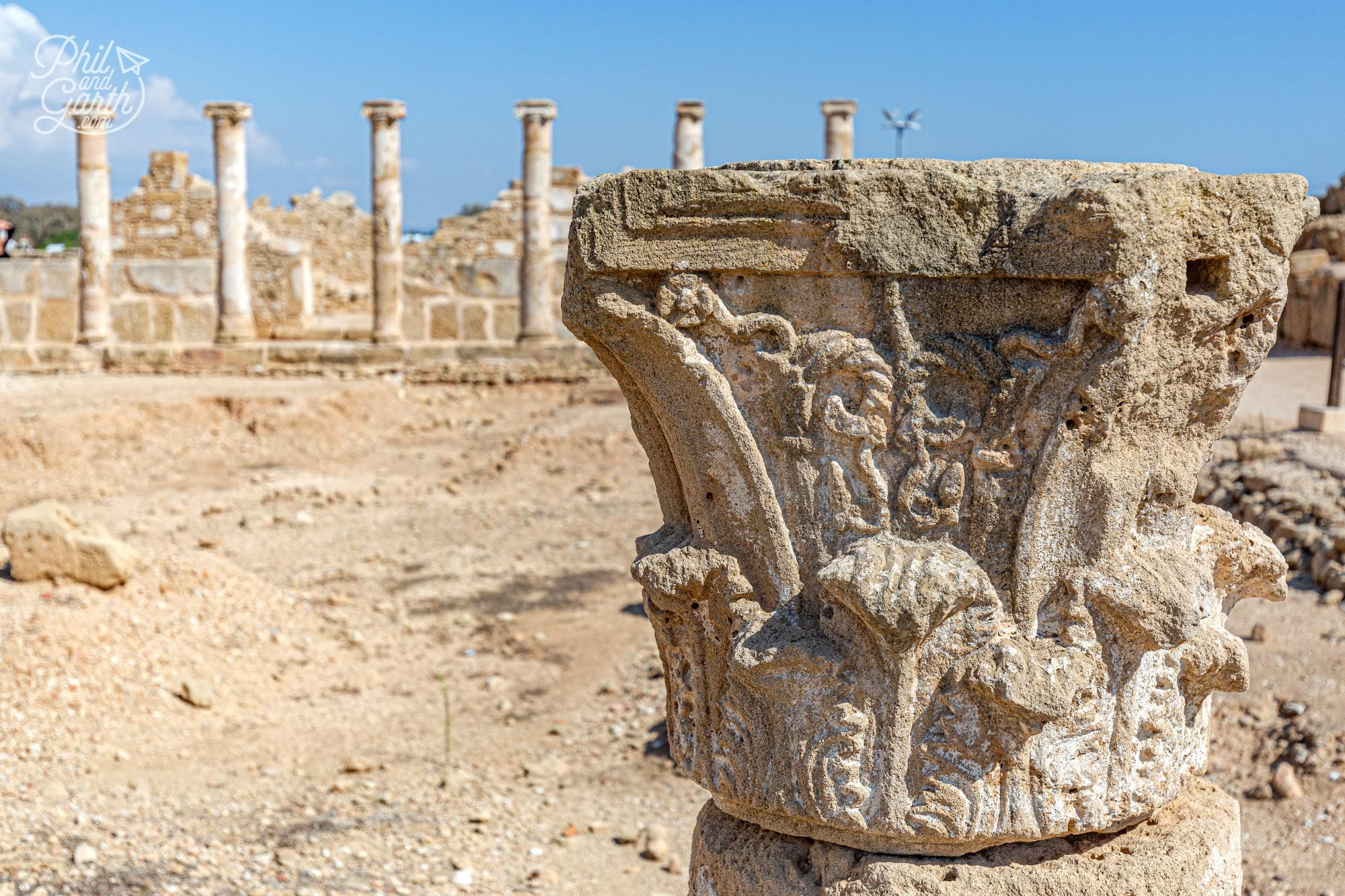
Detail of a column in the House of Theseus
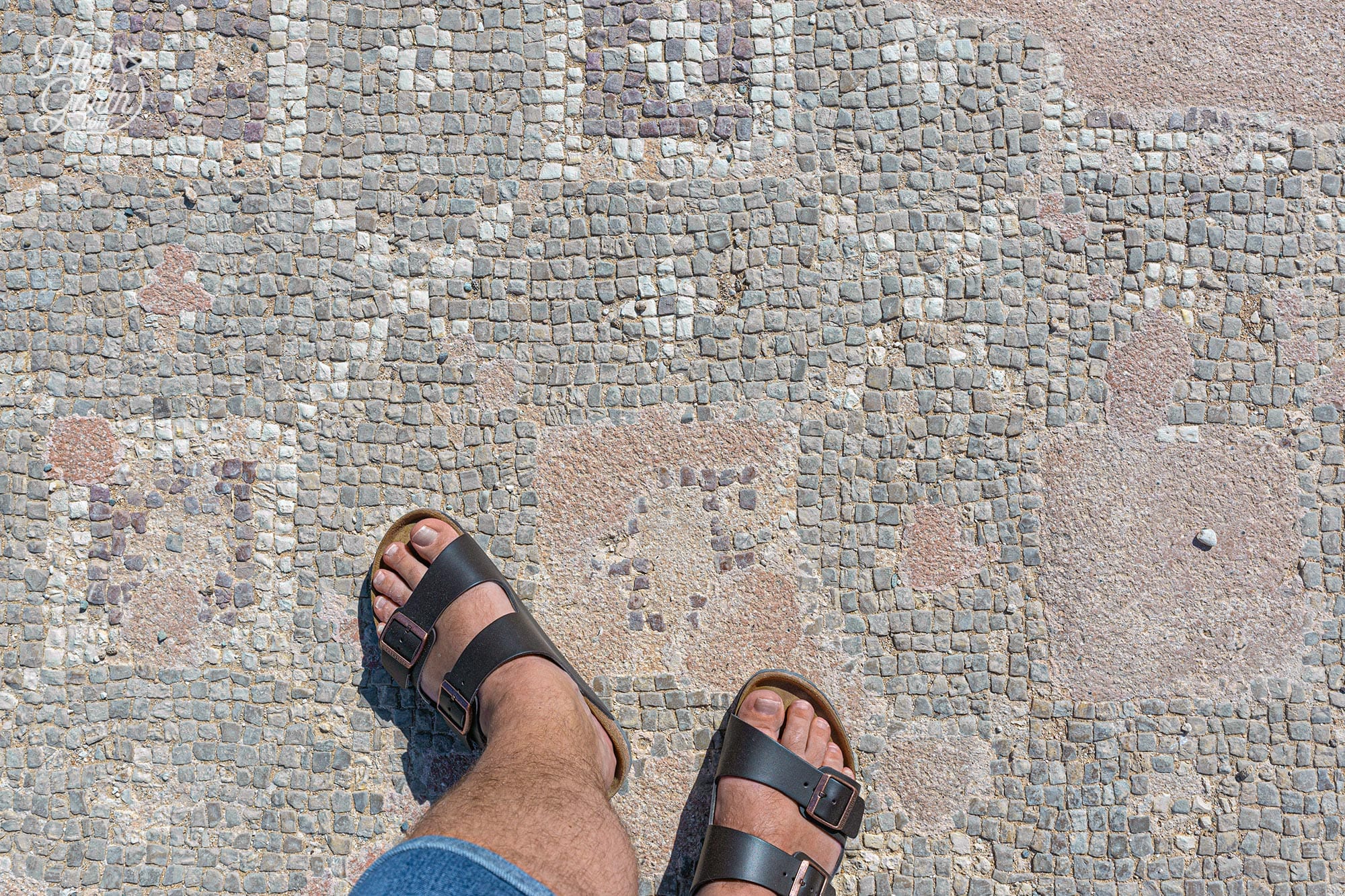
You can even walk on the mosaics on the footpaths outside the House of Theseus
The Odeon
Beyond the mosaics and within the park you’ll find The Odeon – an old Roman amphitheatre just beneath the lighthouse which is carved out of the limestone in the side of the hill. As we walked through this space we imagined what musical and theatrical performances played out here.
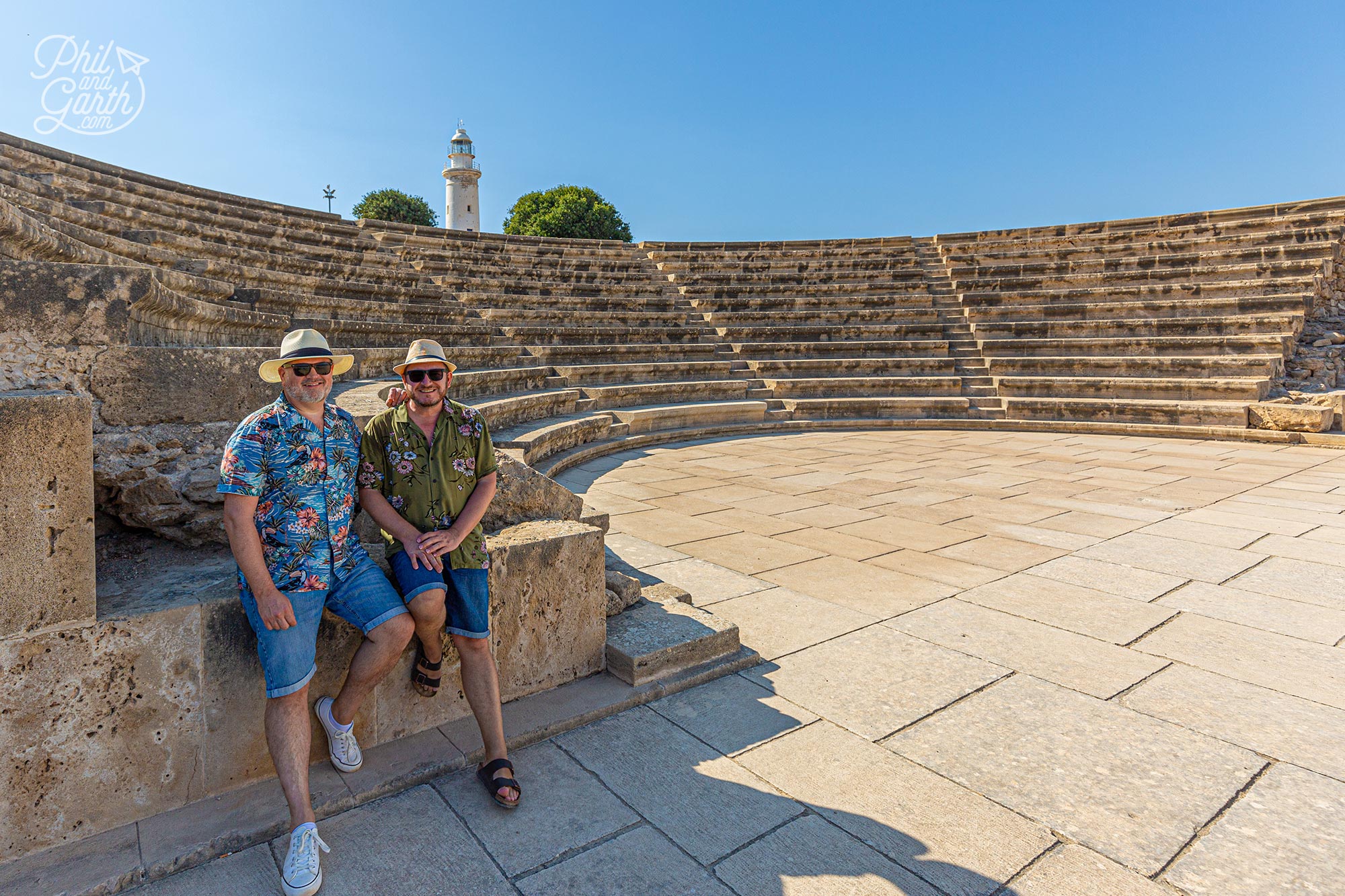
Phil and Garth sat in the Odeon
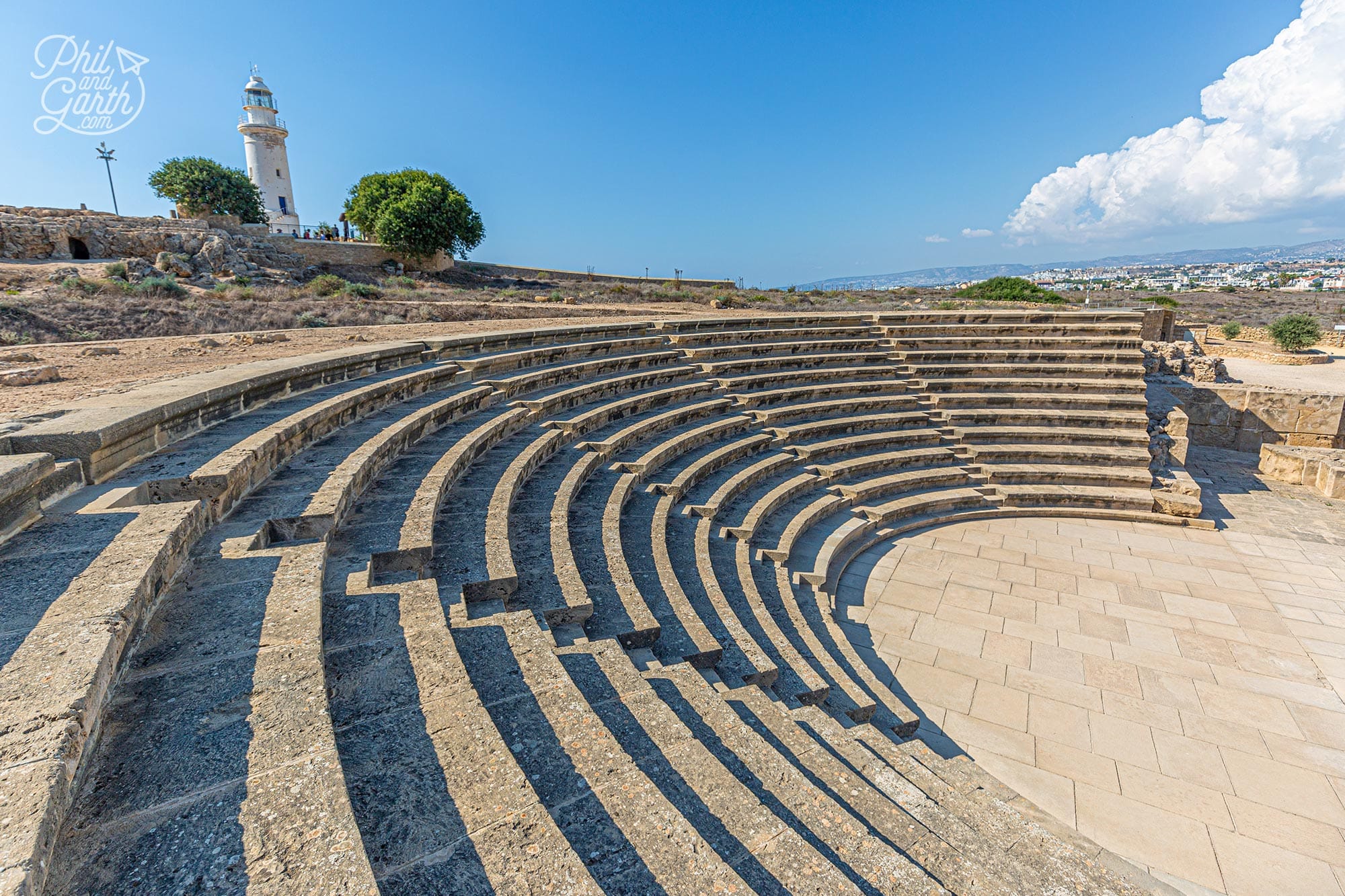
The Odeon theatre from the 2nd century AD seated about 1,200 people
2. Tomb of the Kings
Tomb of the Kings are within the same Archaeological Park, but you need to drive 10 minutes north to the Tombs of the Kings roundabout where there’s a large car park. It costs an additional 2.5 Euros to enter.
The Tombs of the Kings are a maze of 8 underground burial chambers – 3,4 and 8 are the best. They are carved out of solid rock and are 2,000 years old dating back to the Hellenistic and Roman periods. Despite the name, the burial tombs were not actually reserved for royalty but rather for wealthy individuals and important members of society. Look at the holes on the ceilings where grave robbers looted the gold. In fact the robbers took so much they are just ruins now. The chambers walls would have been covered in decorative frescoes.
Tomb Number 3
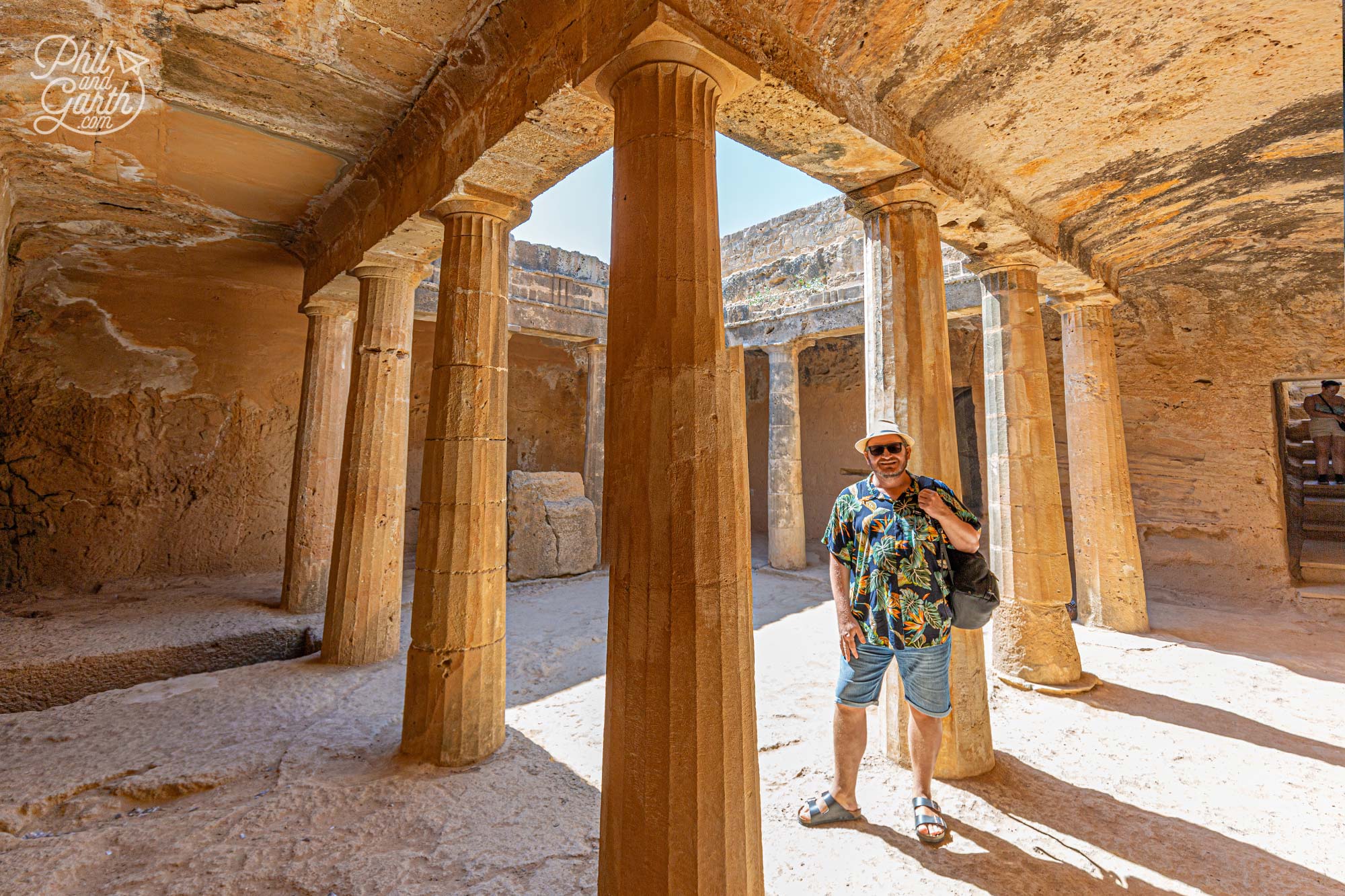
Garth in the impressive Tomb Number 3
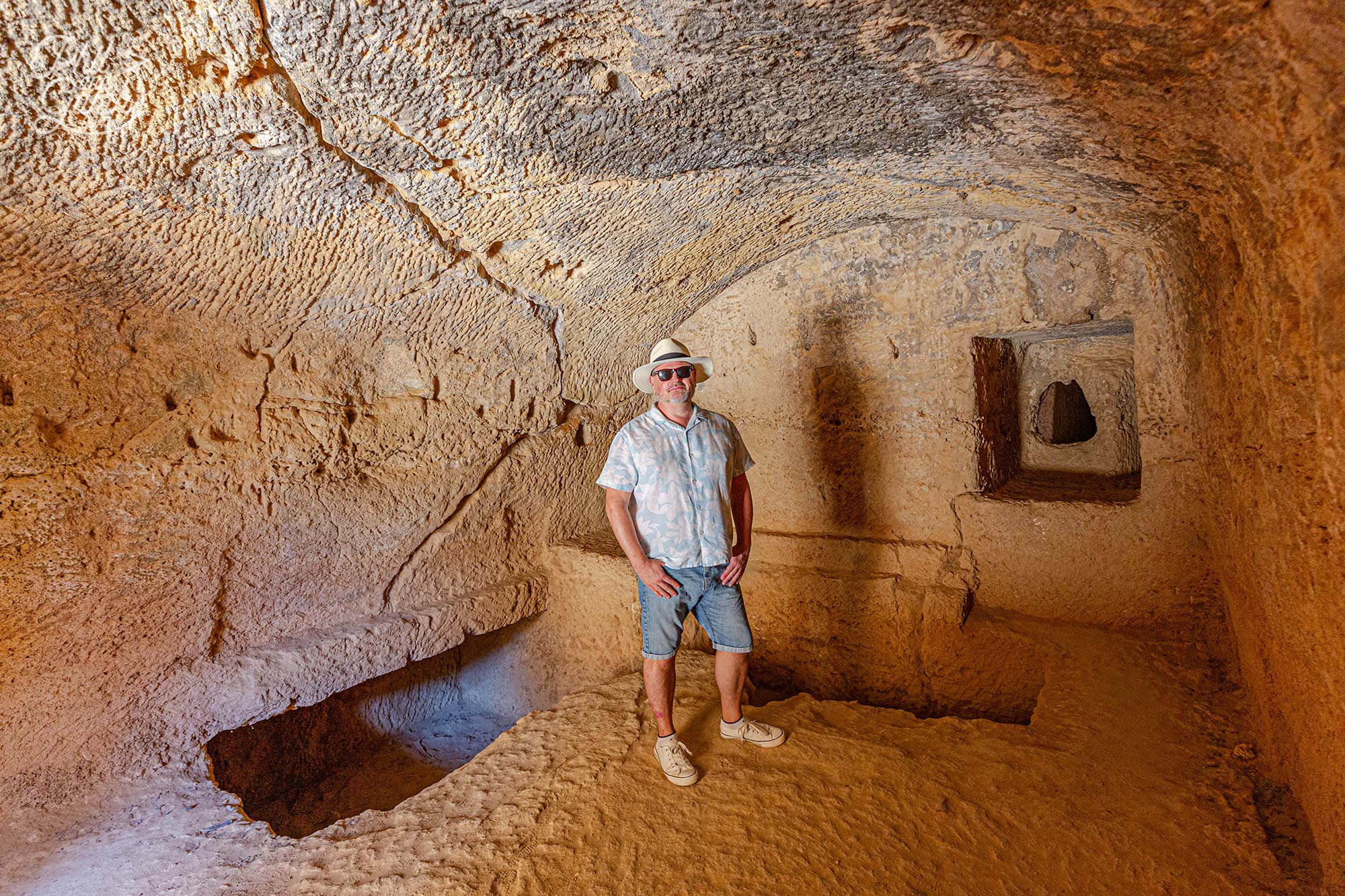
Phil in one of the chamber rooms of Tomb Number 3
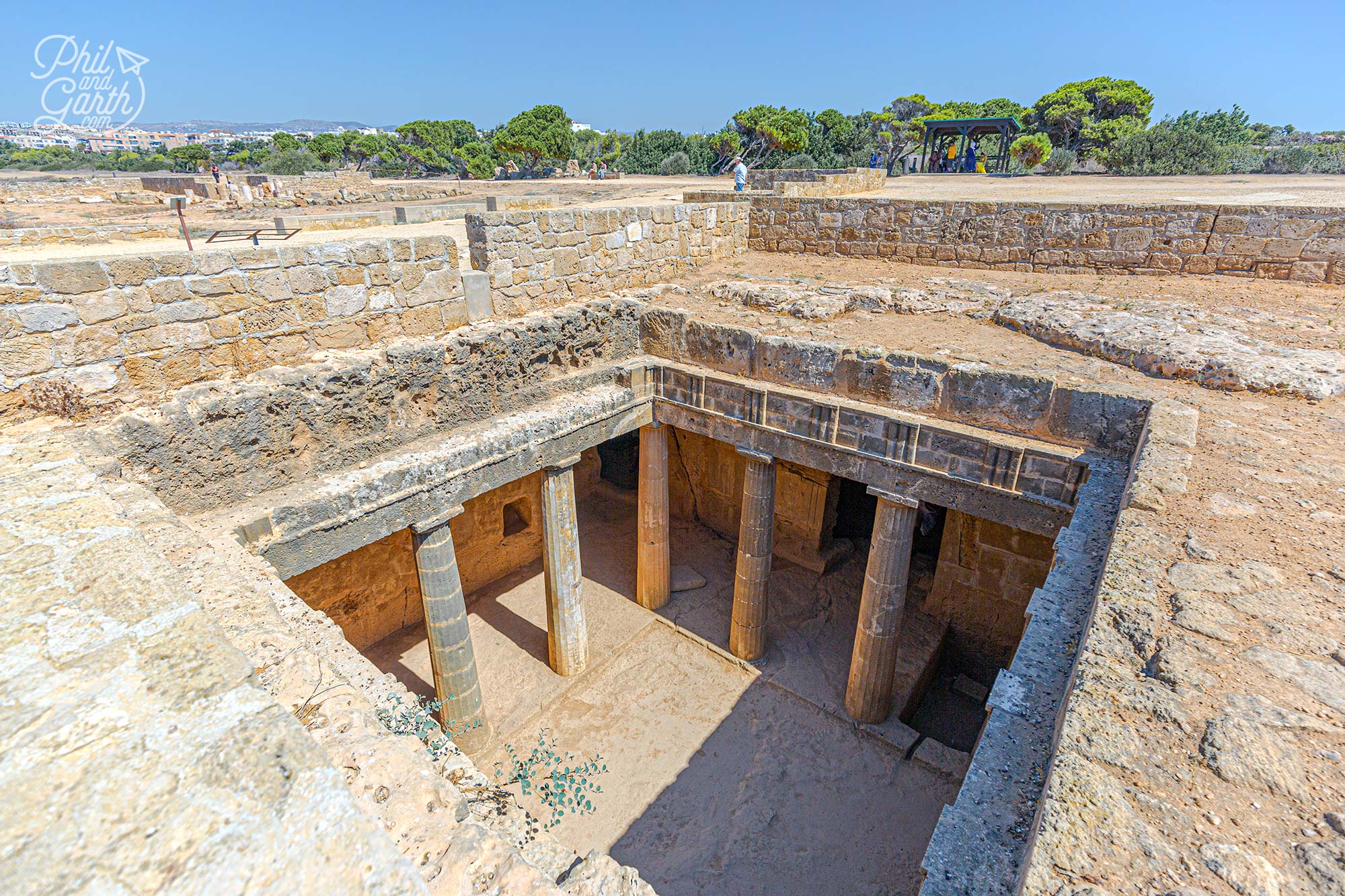
Top view looking down on Tomb Number 3
Tomb Number 8
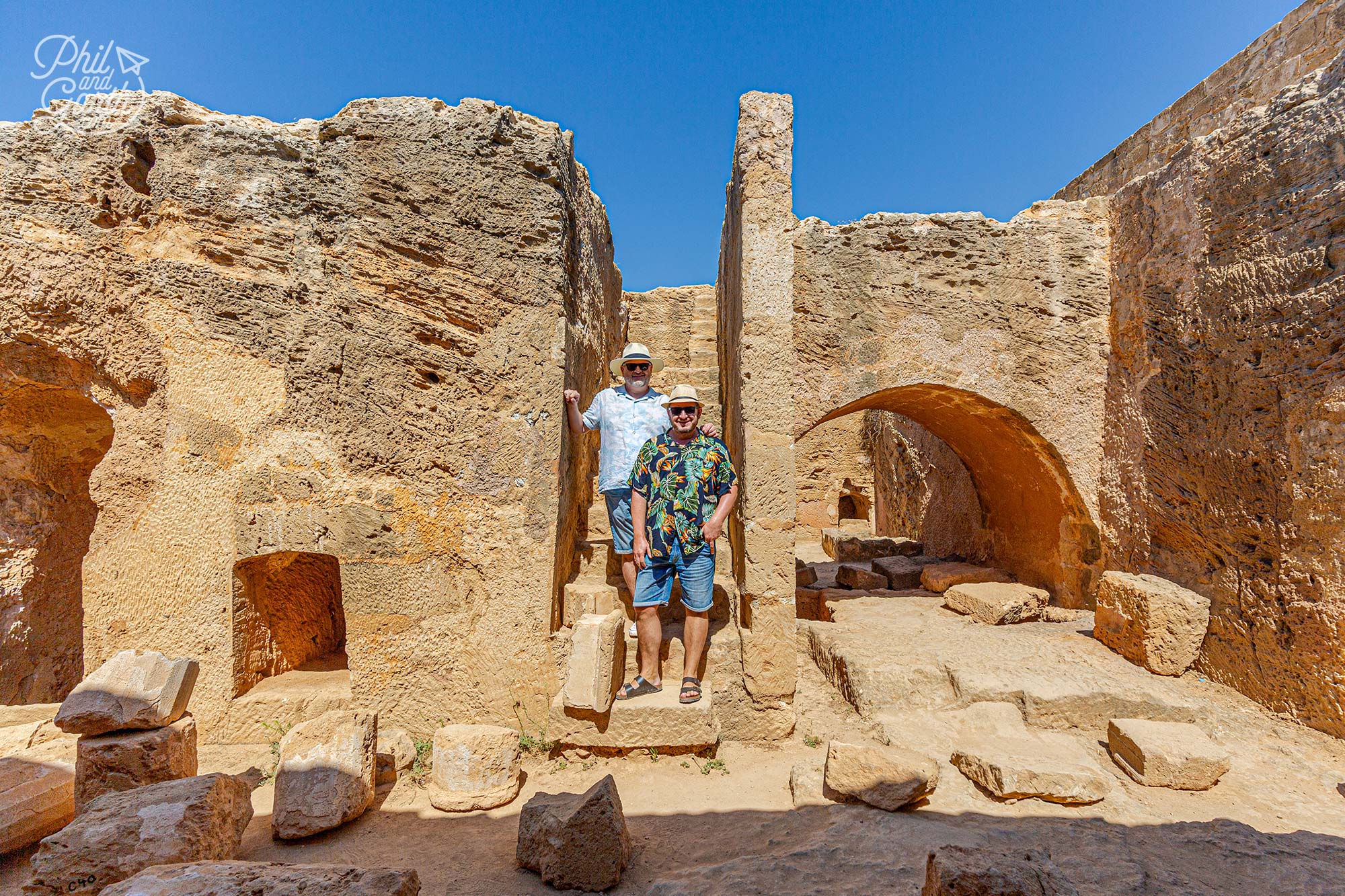
Phil and Garth Tomb Number 8
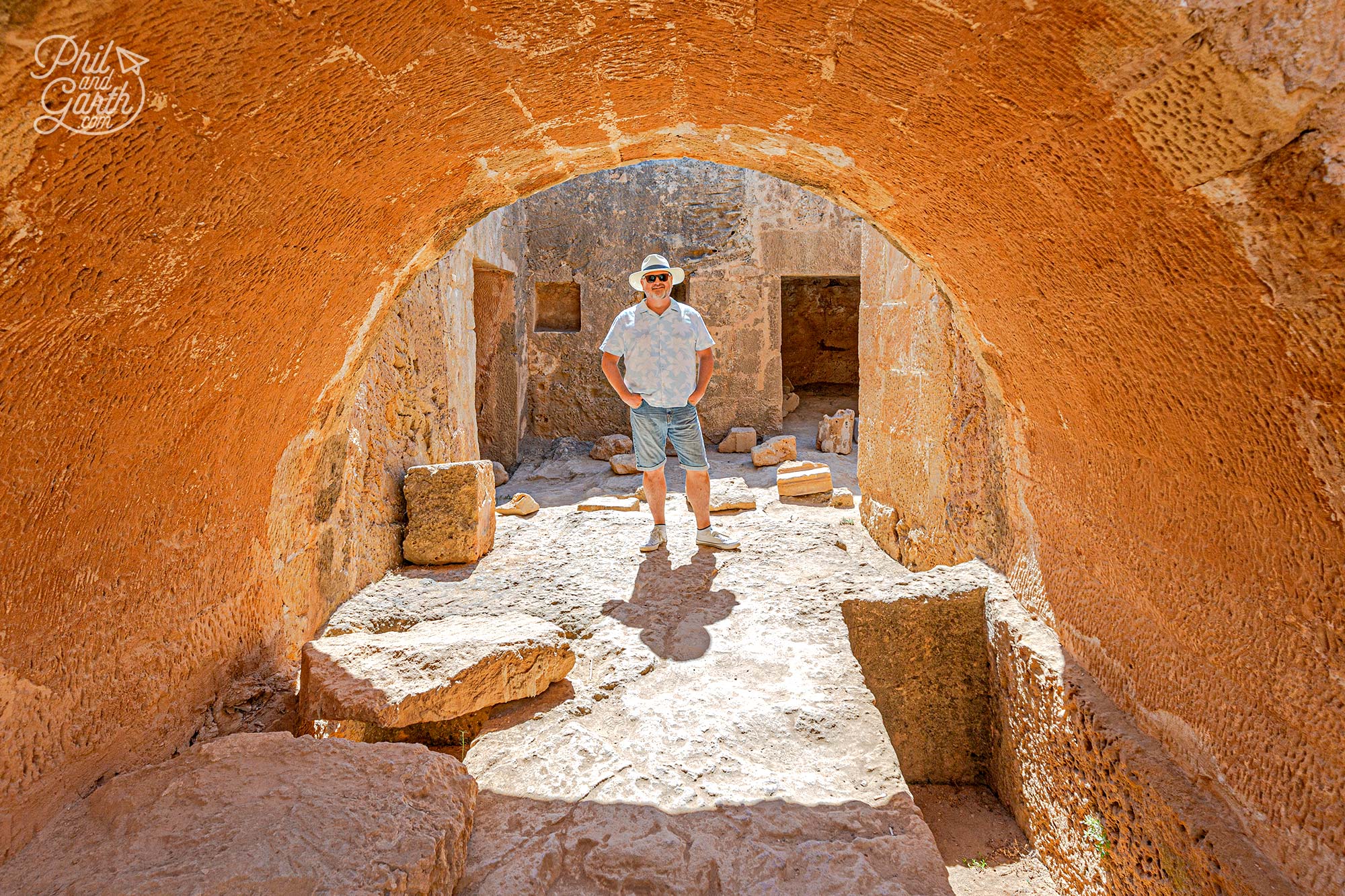
Phil in Tomb Number 8
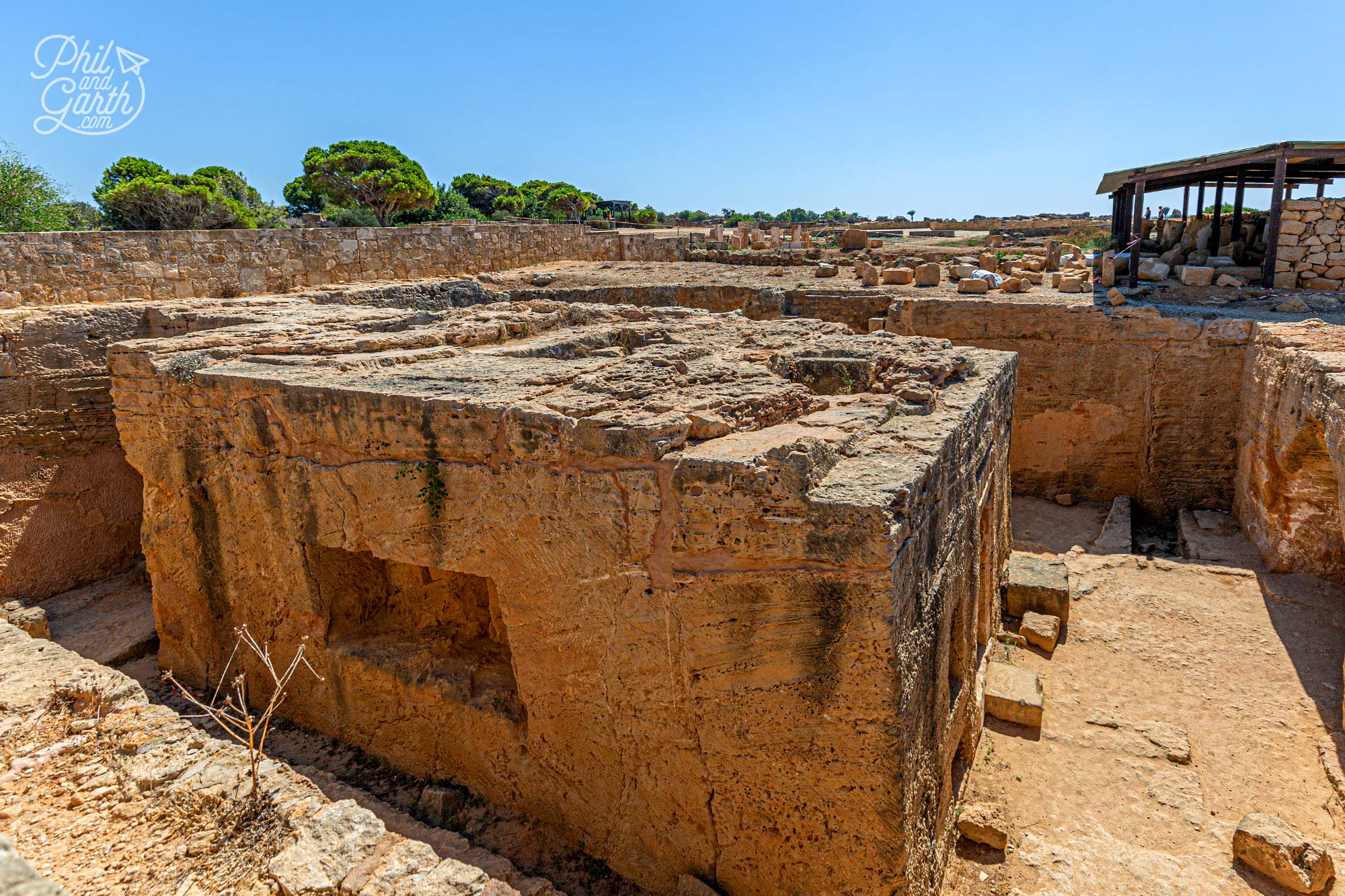
Tomb Number 8 from above
We thought the desert like surroundings looked like a scene from Star Wars, especially the impressive Tomb No.3 with its below ground atrium, surrounded by columns. Watch your step on the stairs lead down from ground level, some are narrow and dark. Take lots of water if you are visiting during the heat of the day, we were melting in September at 33ºC.
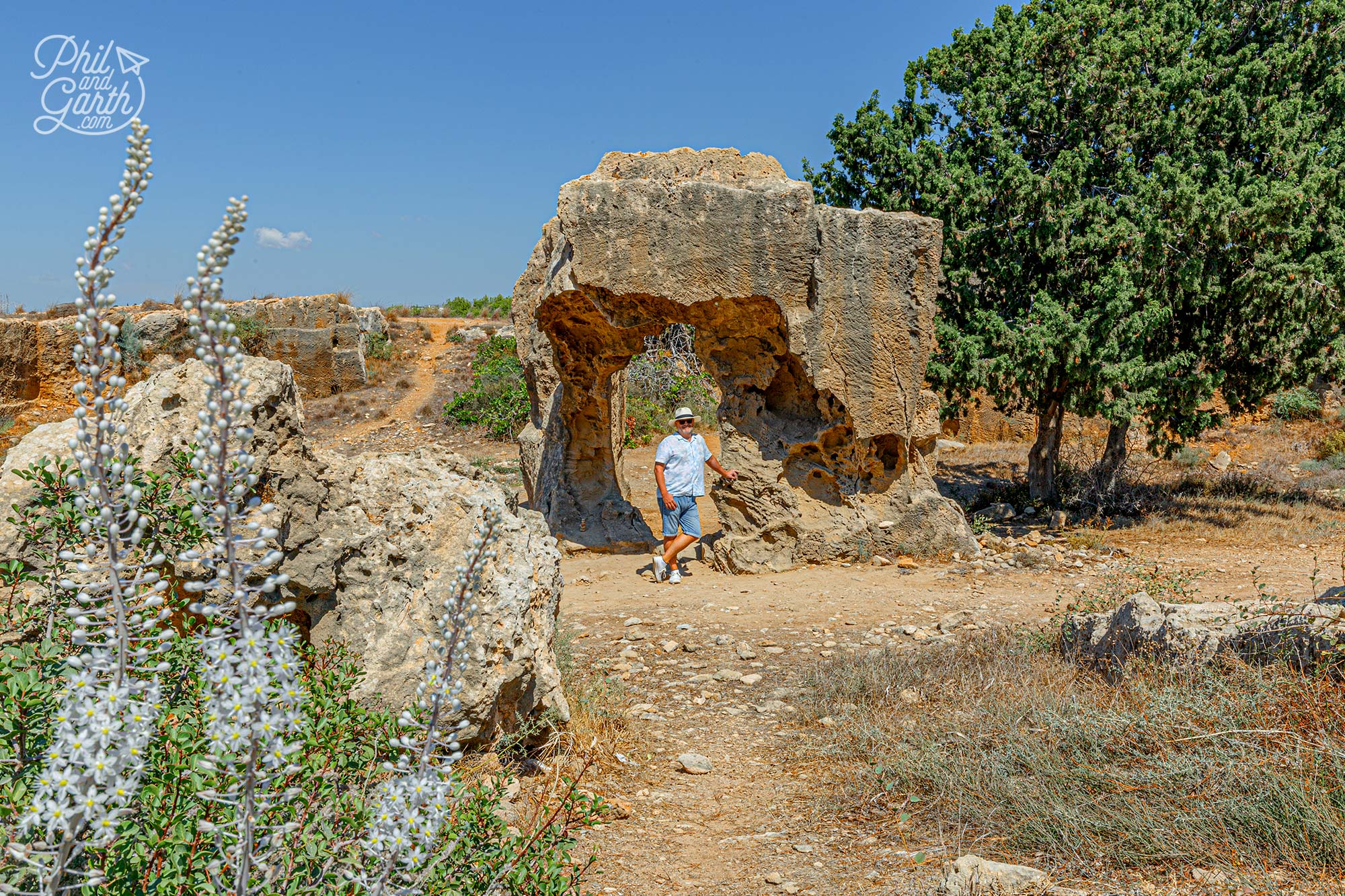
So many photo opportunities at Tomb of the Kings
3. Paphos Harbour & Castle
Paphos Castle is one of Cyprus’ most iconic landmarks. It’s a medieval fortress dating back to the Byzantine Empire, built to protect the city’s port. It also served as a prison under the the Ottoman Empire and as a salt warehouse under the British. However it was rebuilt several times over the centuries and what you see today is from 1592 rebuilt by the Ottomans. Set against the sparkling Mediterranean Sea it’s imposing and picturesque. We went inside to the explore the cool interior courtyard. For a few euros you can enjoy the panoramic views from the roof. If you’re visiting in September the castle serves as the backdrop to opera performances during the Paphos Aphrodite Festival.
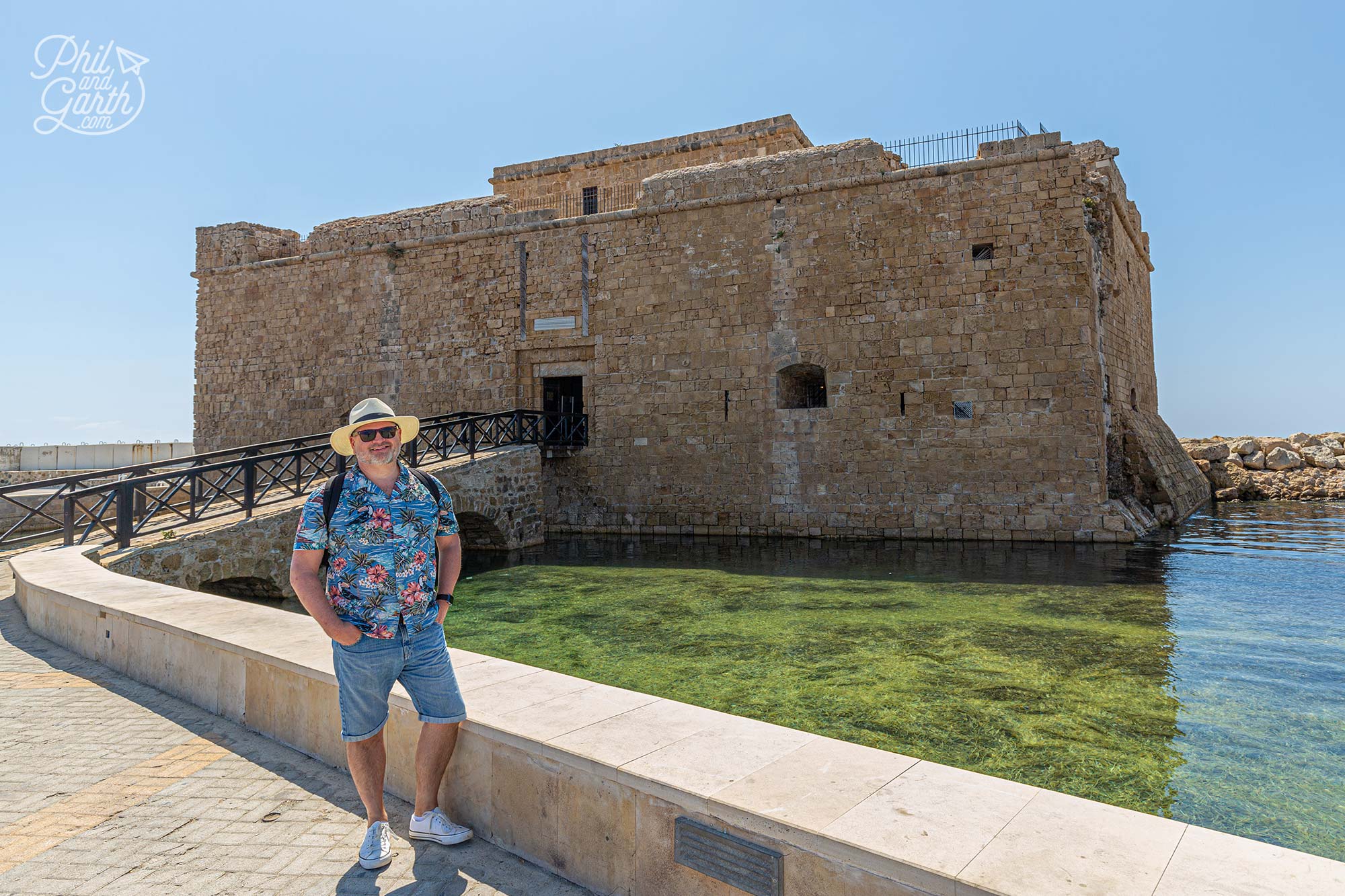
Phil outside Paphos Castle
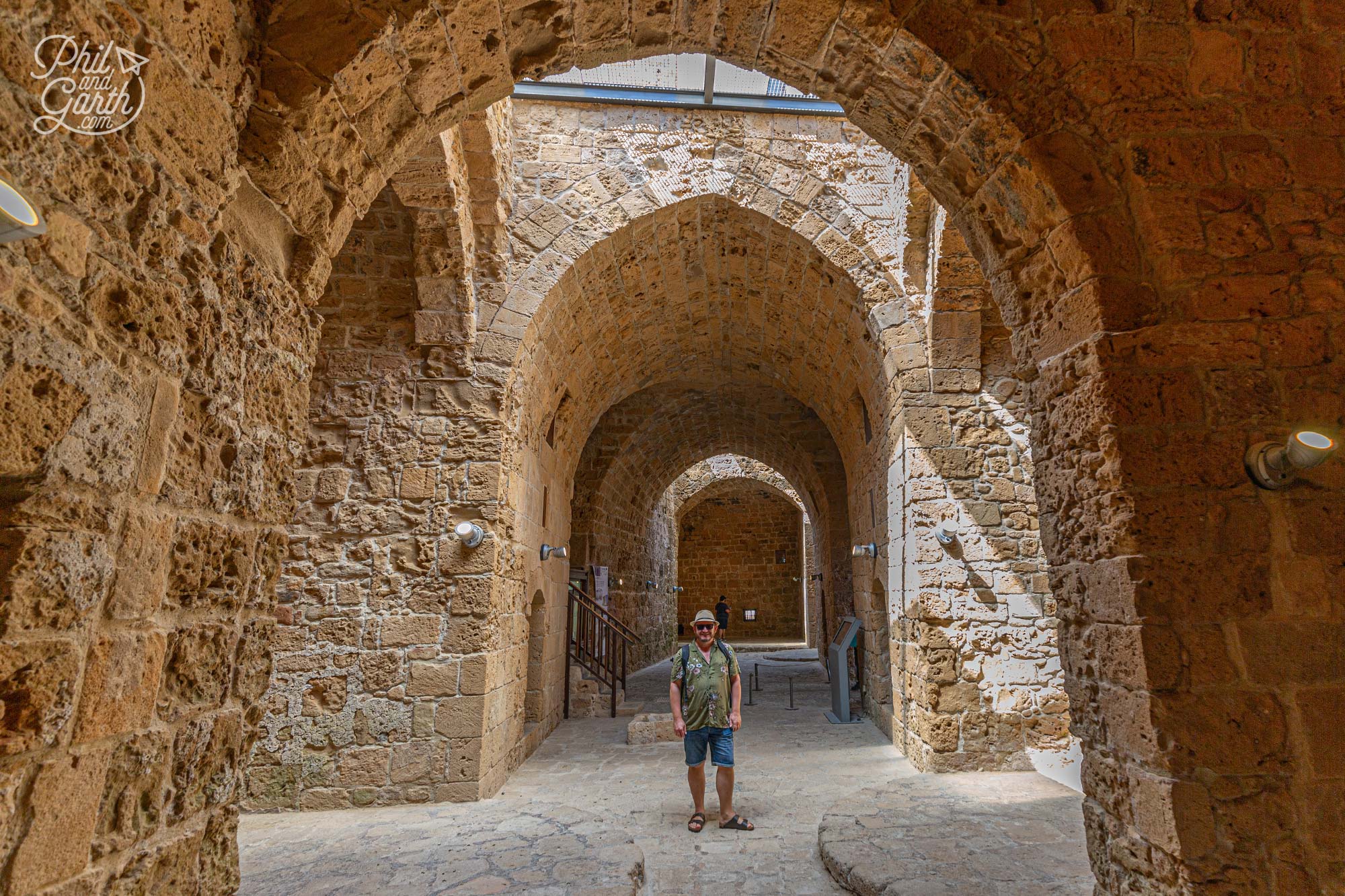
Garth iniside the cool interior courtyard of Paphos Castle
After you’re done at the castle, then check out the picturesque Paphos Harbour which is a great place for a leisurely walk or stopping for a drink and some food and watching the local fishermen go about their business. The evenings are much livelier as people come for the live DJs and clubs. We stopped for lunch and had a delicious moussaka served with a greek salad.
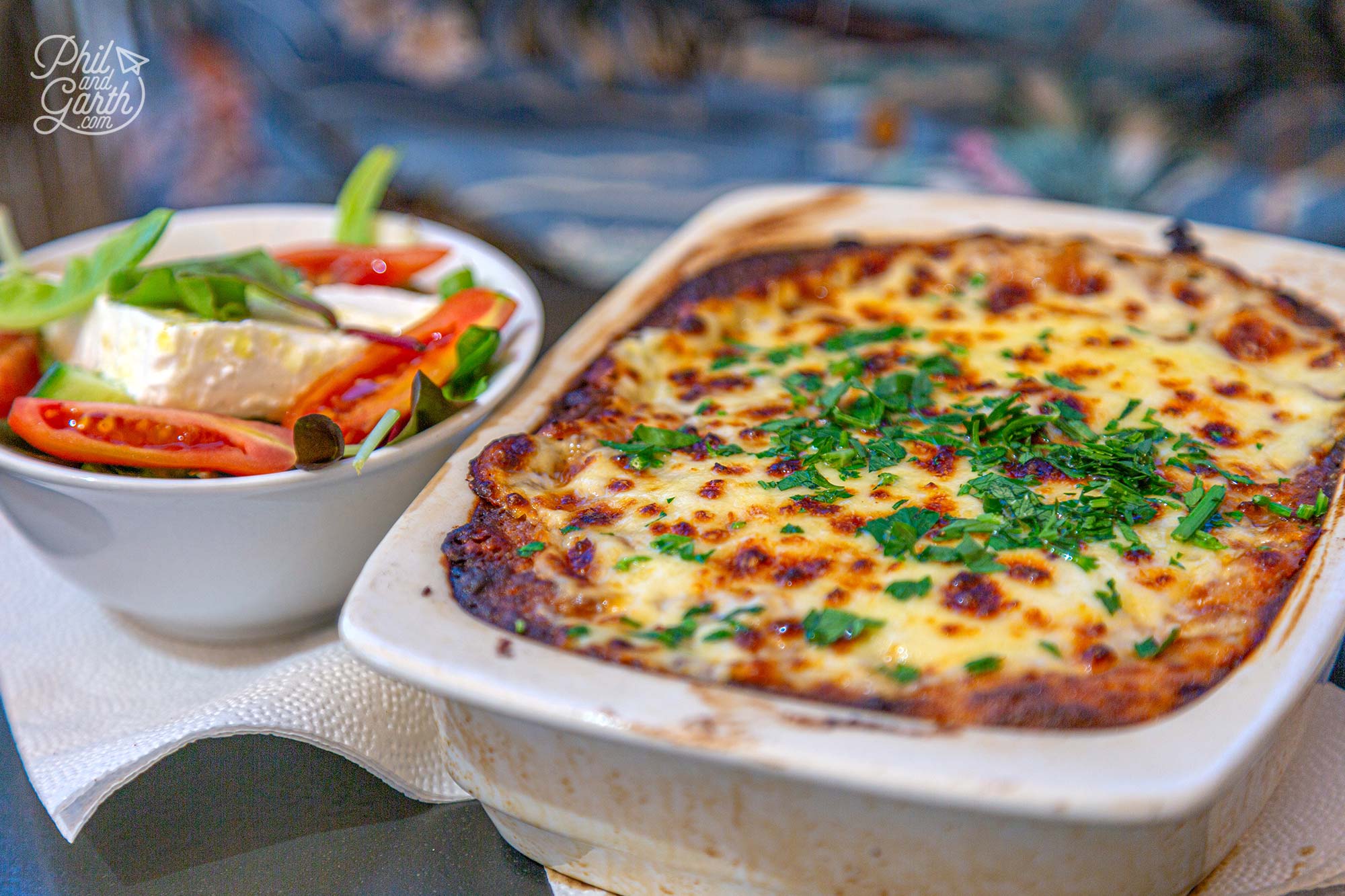
Greek salad and moussaka
4. Aphrodite’s Rock (Petra tou Romiou)
We drove for a swim at Aphrodite’s Rock to see the legendary birthplace of Aphrodite, the Greek goddess of love. She is said to have risen from the foam of the sea here to the sound of thunder claps. Now what we didn’t realise its a pebble beach and you need jellie shoes to enter the water. doh! According to legend if you can swim around the rock 3 times she will reward you with eternal youth and beauty. Petra tou Romiou is certainly one of the most photographic beaches in Paphos.
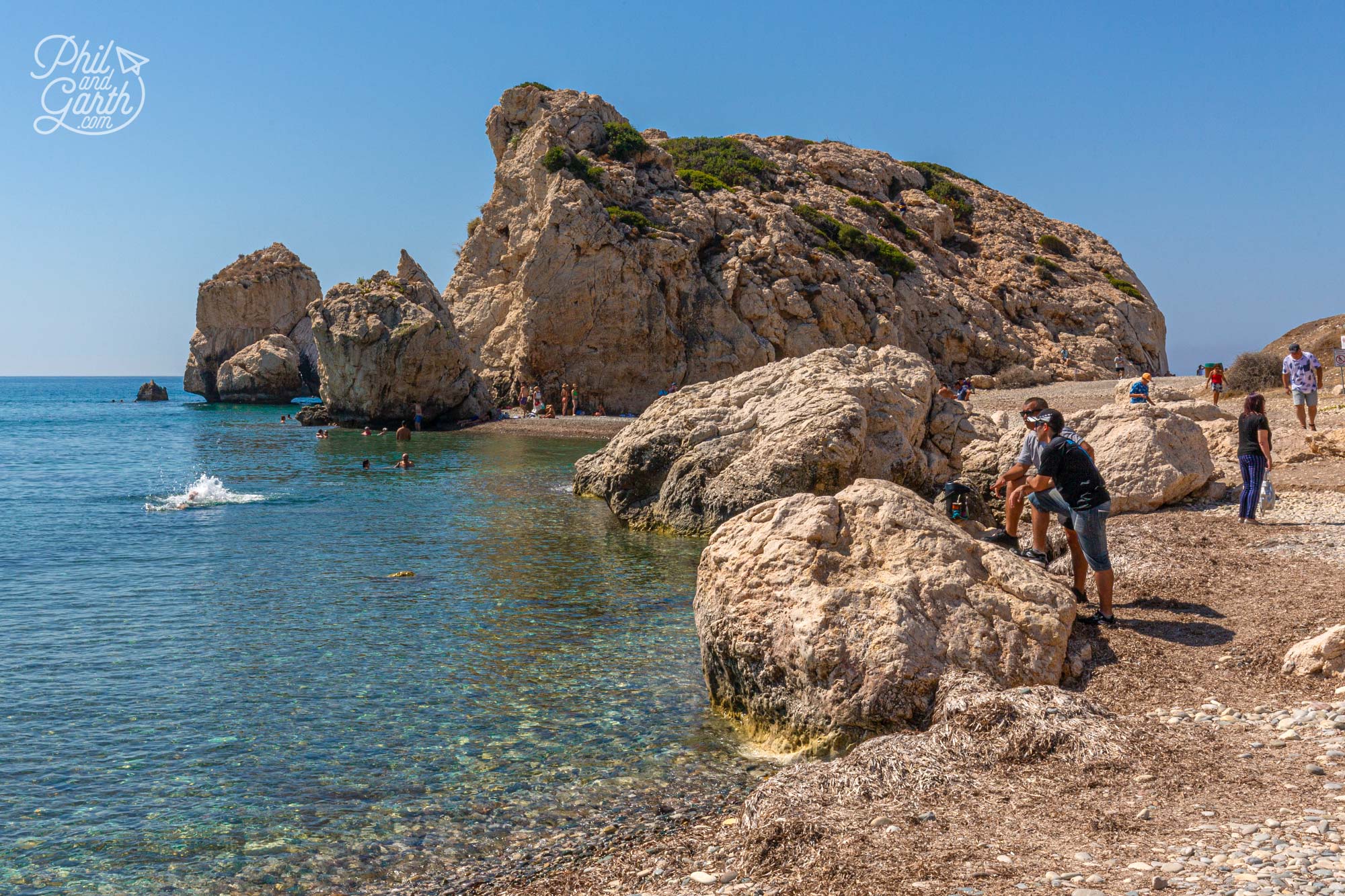
Aphrodite’s Rock
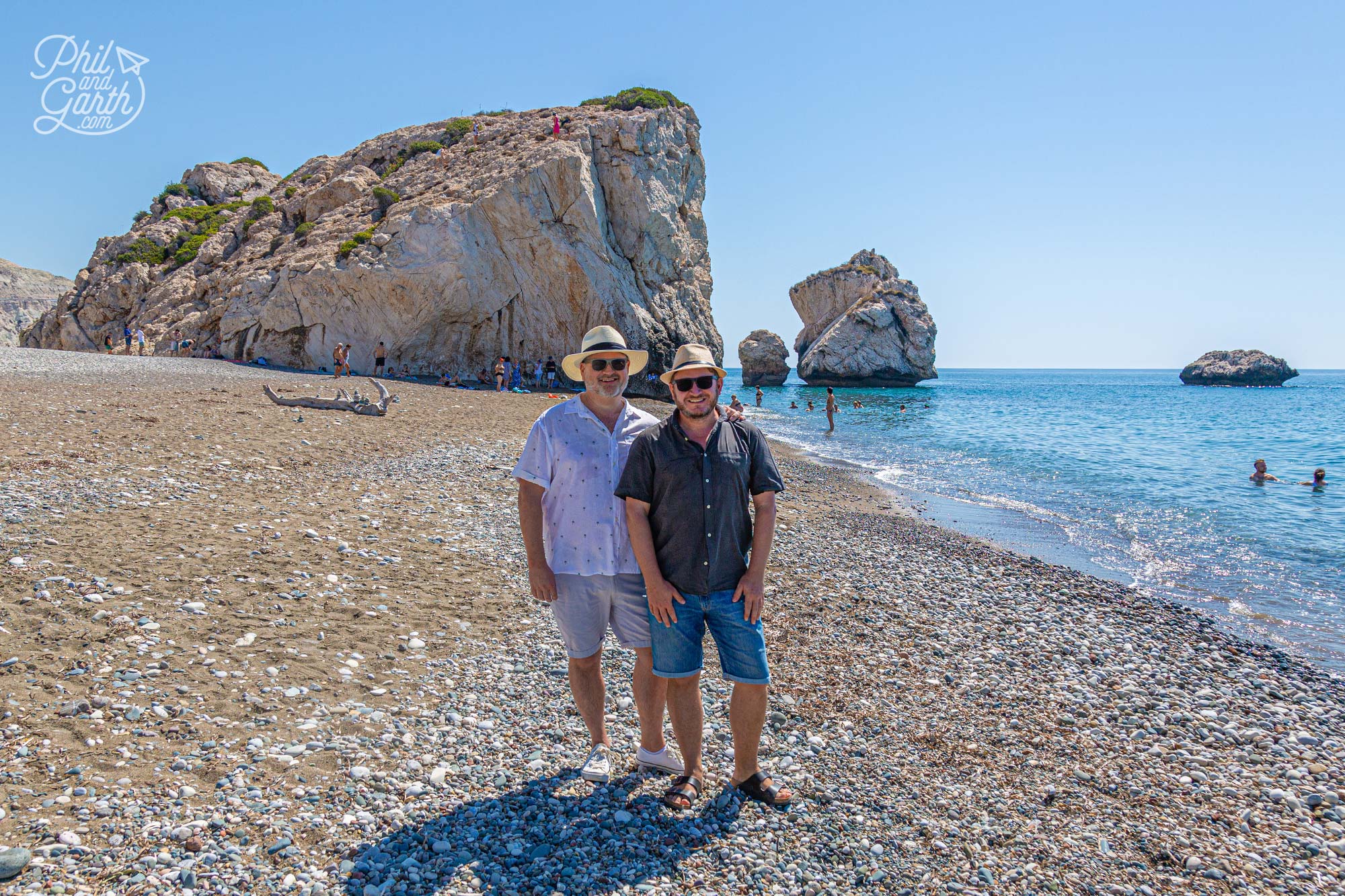
Phil and Garth at Aphrodite’s Rock – Petra tou Romiou
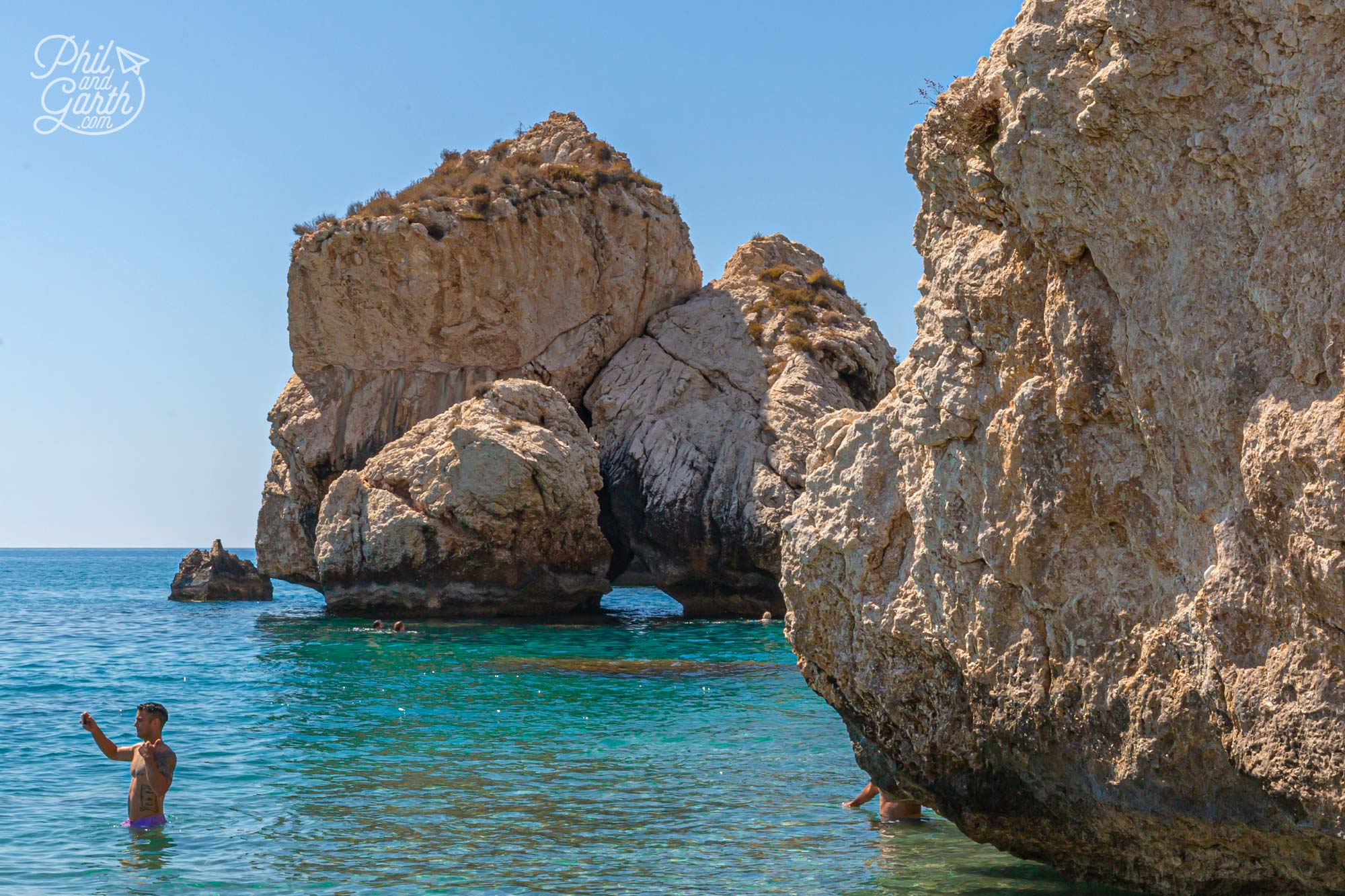
Swim around the rock 3 times and Aphrodite will reward you with eternal youth
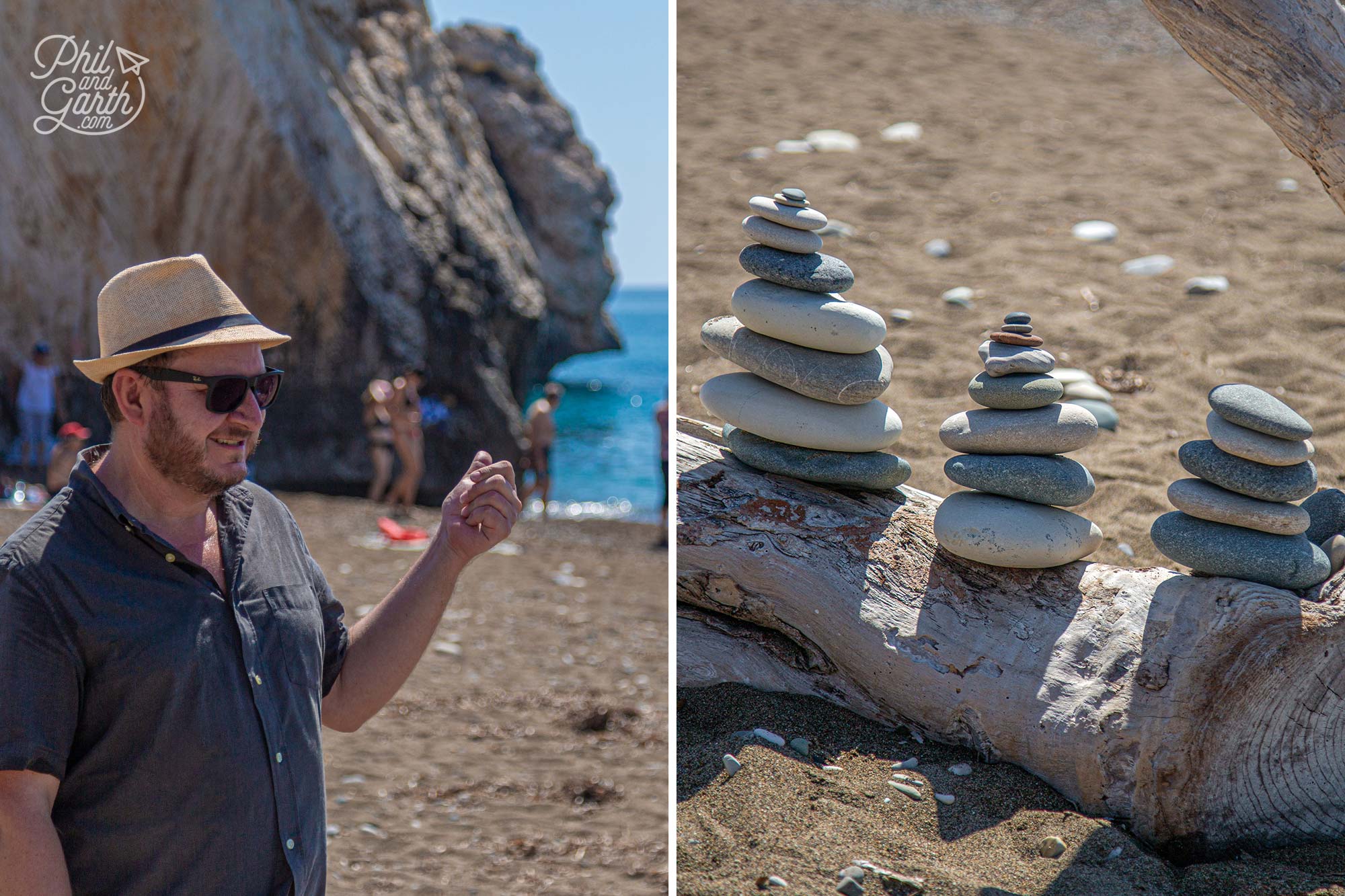
Love some standing stone sculptures
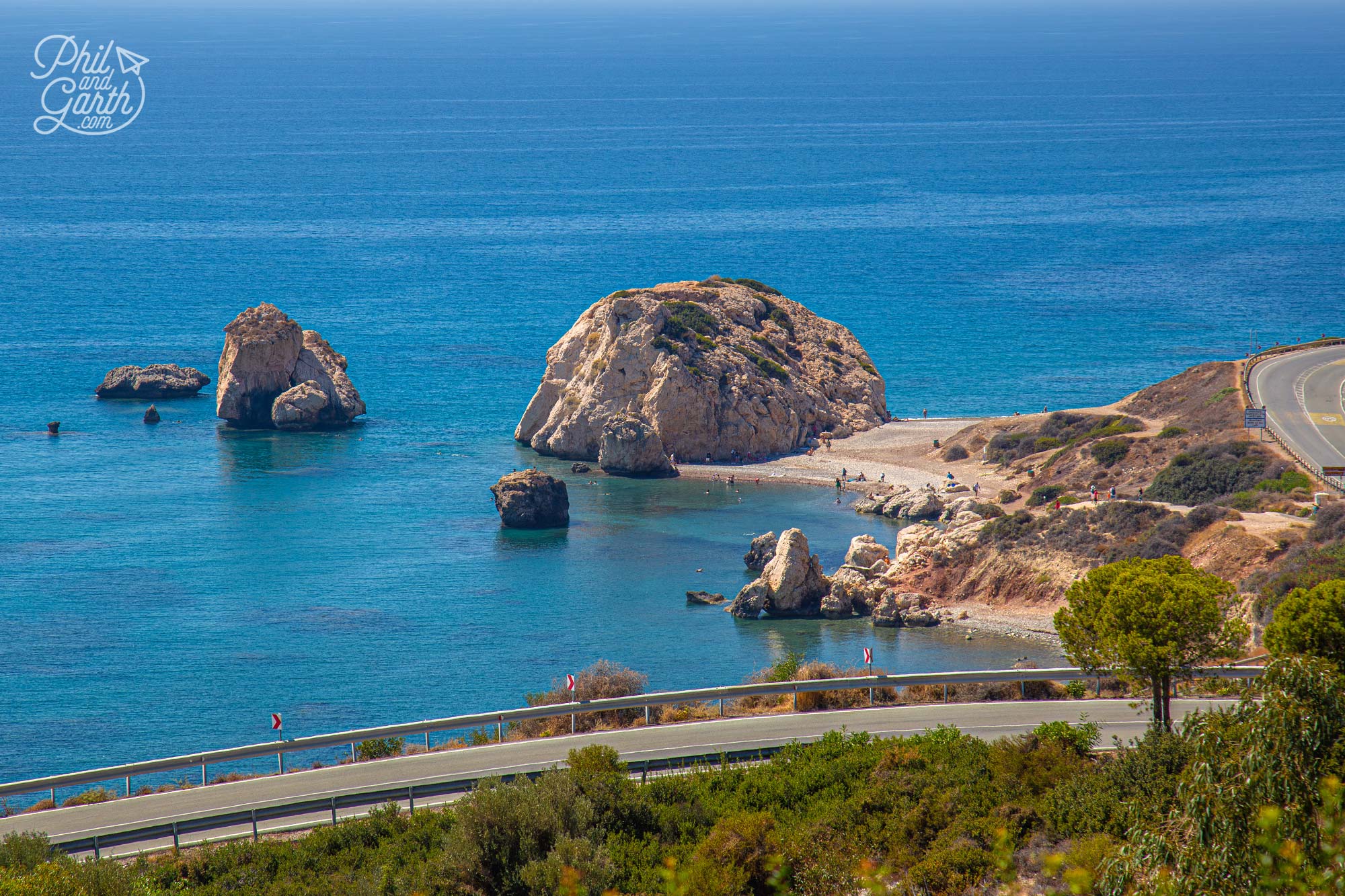
VIew of Aphrodite’s Rock from the Petra Tou Romiou Restaurant
We then stopped for a fresh fish lunch at Petra Tou Romiou restaurant just a couple of minutes drive up the road from the beach. It has a great viewpoint with an unspoilt view of Aphrodite’s Rock. The restaurant is basic, but the service was friendly and the fresh fish Garth ordered was tasty as was Phil’s prawn dish.
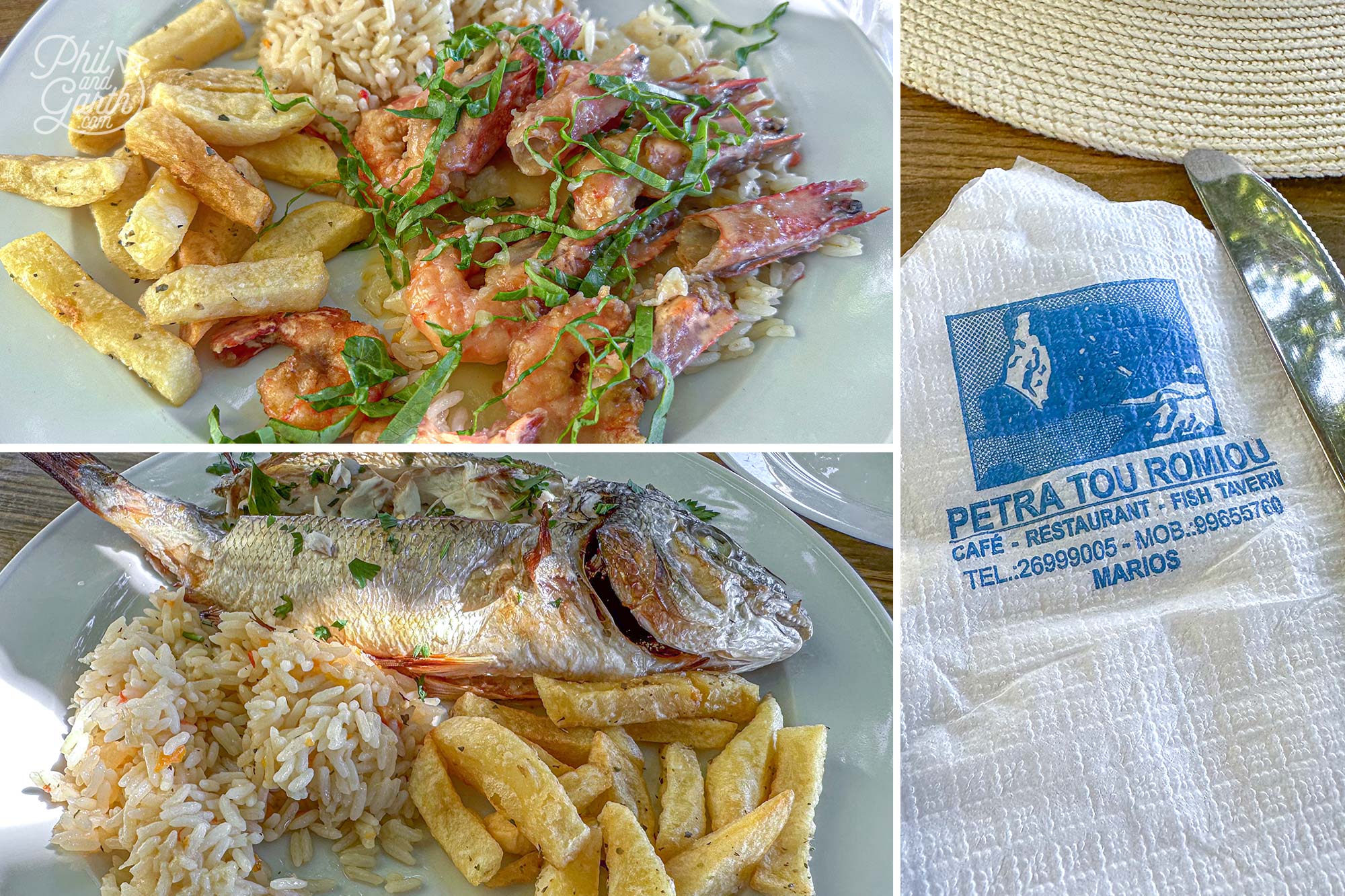
Fresh fish dishes at the Petra Tou Romiou Restaurant
5. Troodos Mountains Village Food & Wine Tour
We love a small group food tour, and wanted to try some authentic Cypriot food. So for Phil’s birthday Garth paid for an 8 hour tour with Cyprus Taste Tours to try traditional food and wine from artisan local suppliers in small villages high up in the Troodos Mountains. Cypriot food is a fusion of Greek, Venetian and Turkish influences.
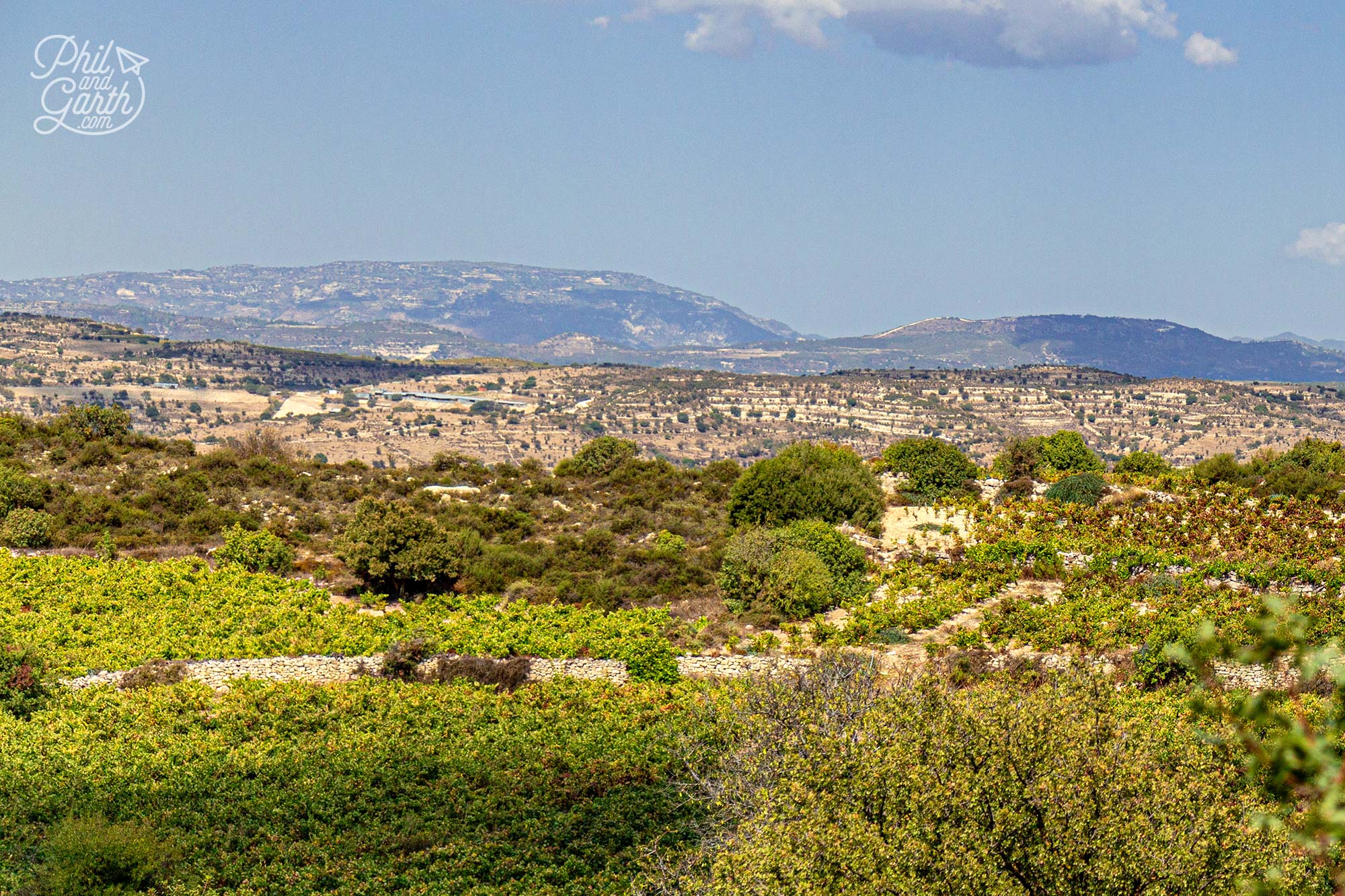
Troodos Mountains Village Food Tour Cyprus
Monastery of Timios Stavros, Anogyra
Elena our guide took us to our first stop – a quick visit to the ruins of the Monastery of Timios Stavros in the village of Anogyra. Built in the 15th Century over the foundations of an early Christian basilica.
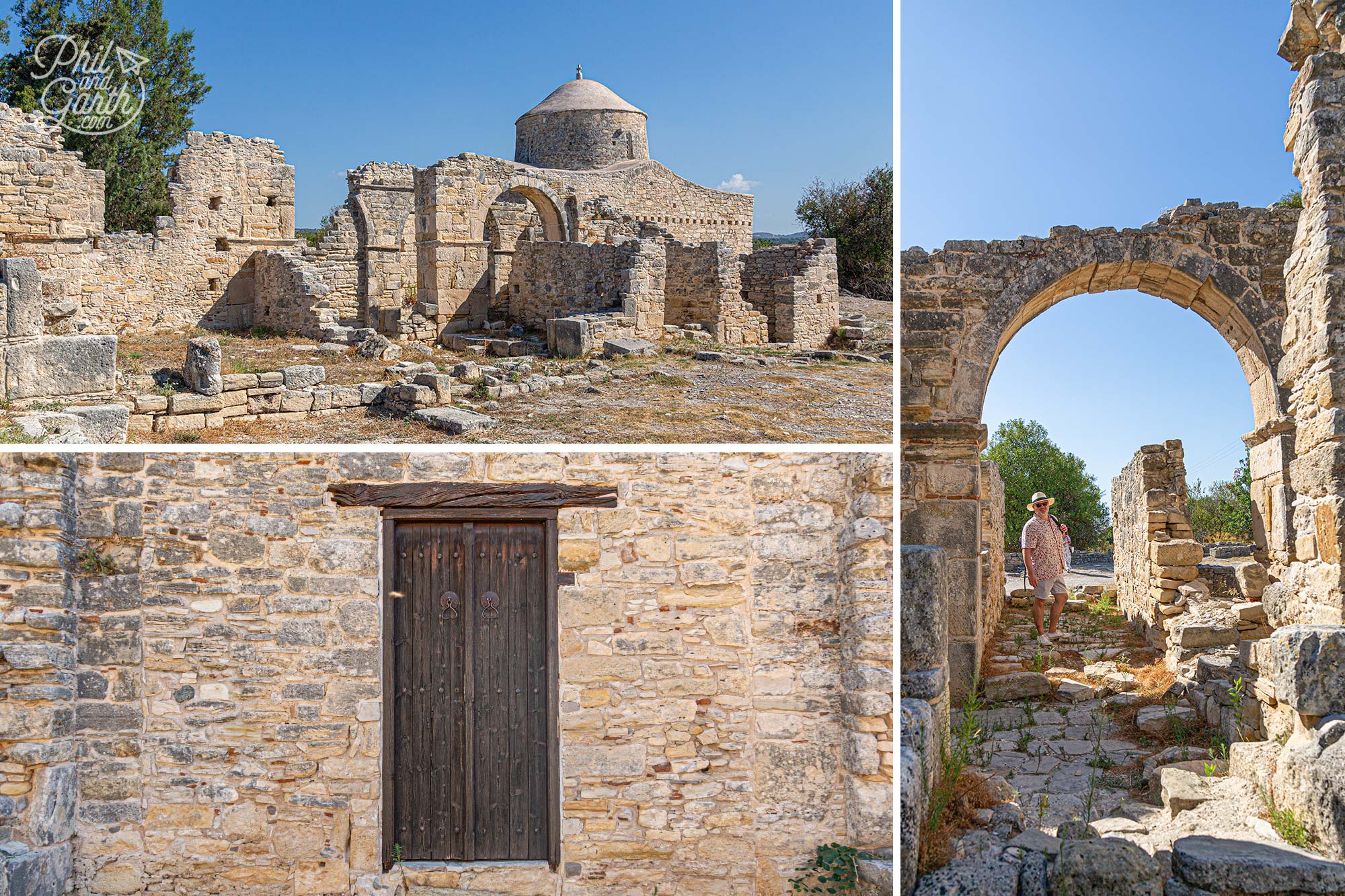
Monastery of Timios Stavros, Anogyra
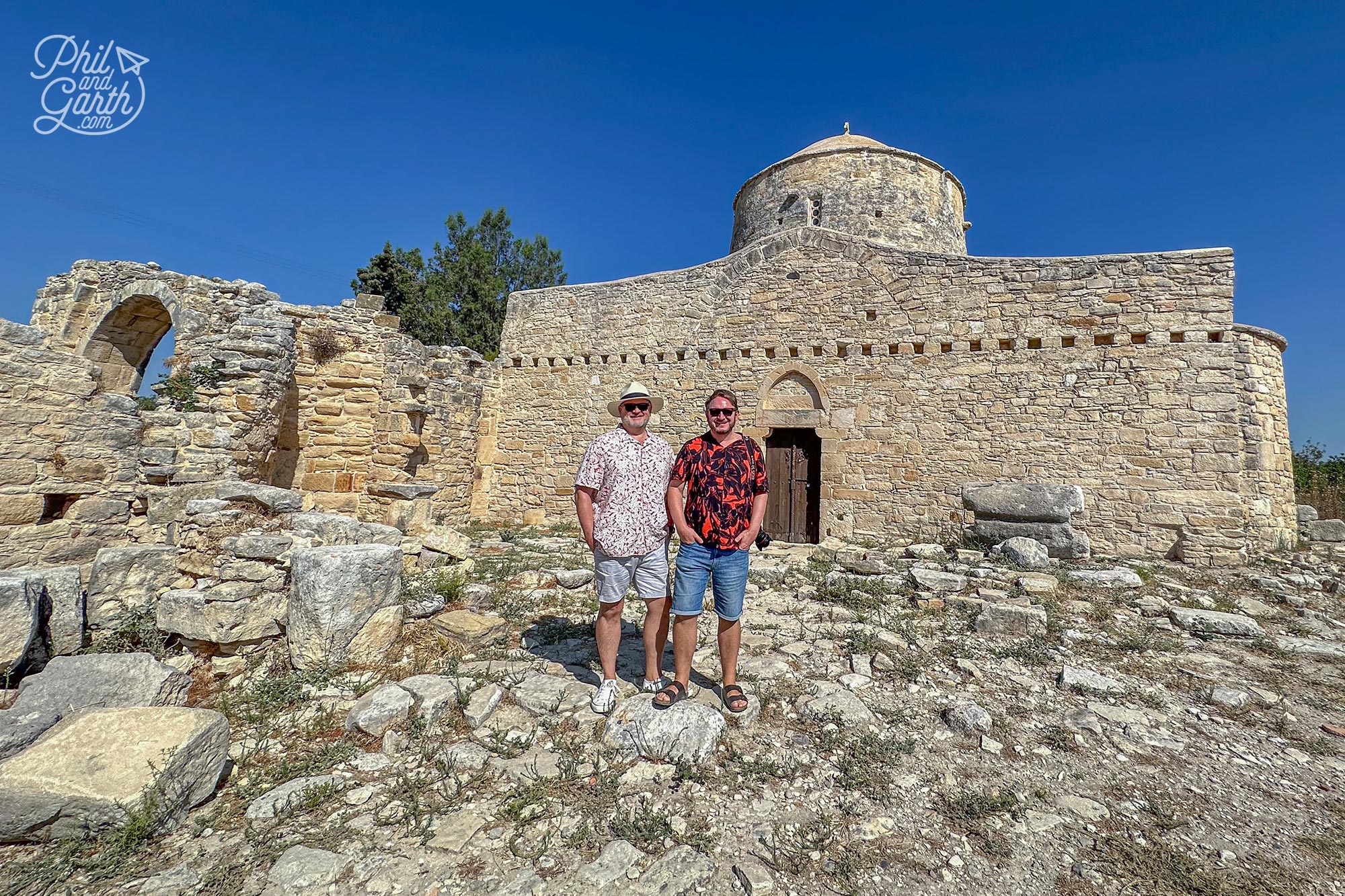
Phil and Garth at the Monastery of Timios Stavros
Carob Tree Syrup, Anogyra
Our second stop was to taste sweet Carob Tree syrup at a small museum/shop in the village of Anogyra. Carob trees are native to dry climate countries like Cyprus, Egypt and Malta. Dating back to Ancient Egypt when Carob was used as a common sweetener before sugarcane and sugar beet became available. Today Carob fruit is traditionally eaten on the Jewish holiday of Tu Bishvat, and Carob juice drinks are drunk during the Islamic month of Ramadan. In Cyprus this “black gold” syrup is widely exported as sweet syrup and a hard sweet candy, a bit like rock you get in the UK.
Fun Fact: In Roman times, a pure gold coin weighed the same as 24 carat seeds (Carat is the Latin word for Carob pod). This unit of measure is still used today.
We were given some samples with Greek yoghurt, Garth hated it! Phil thought it was an acquired taste.
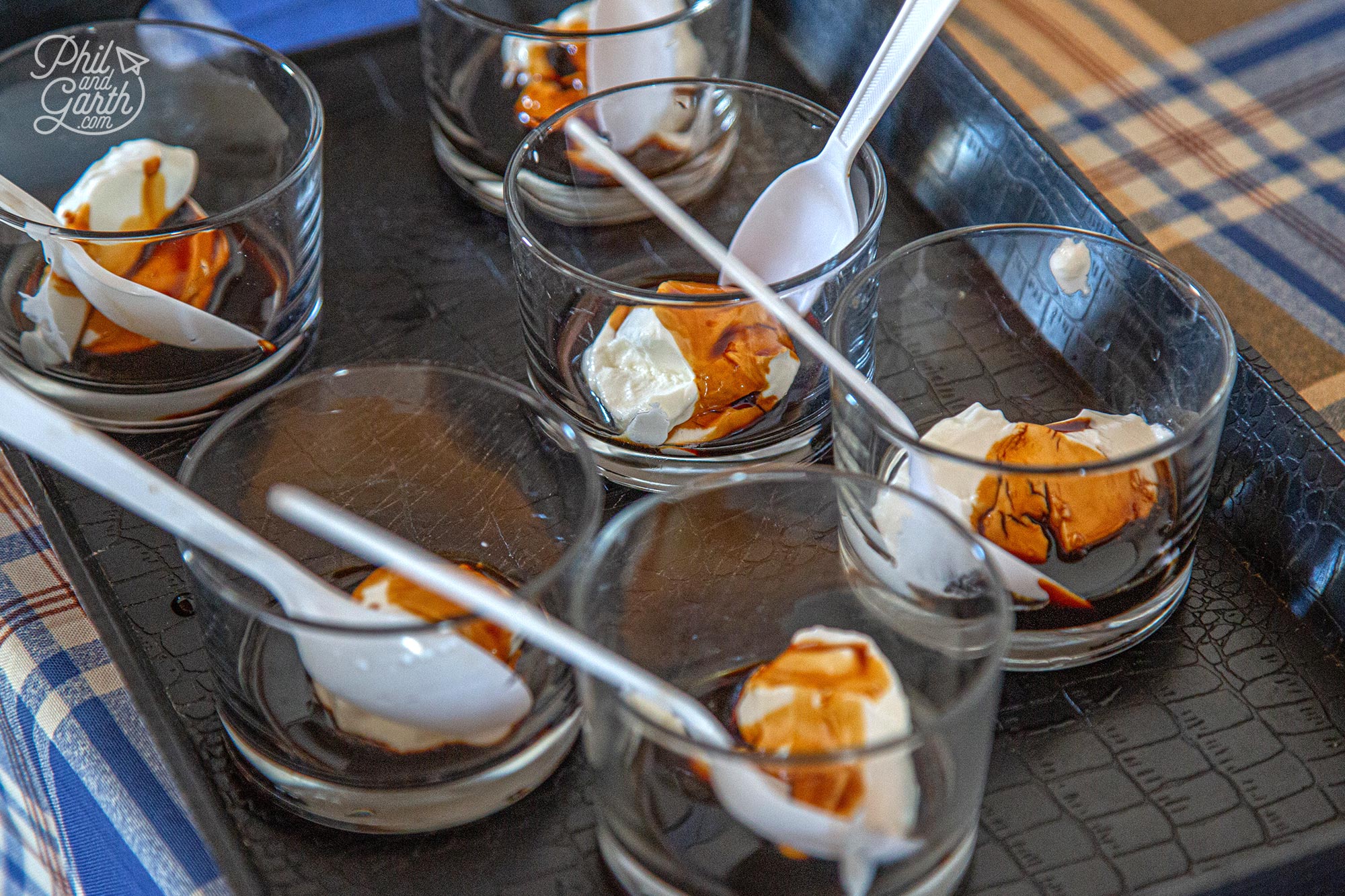
Carob tree syrup tasting session
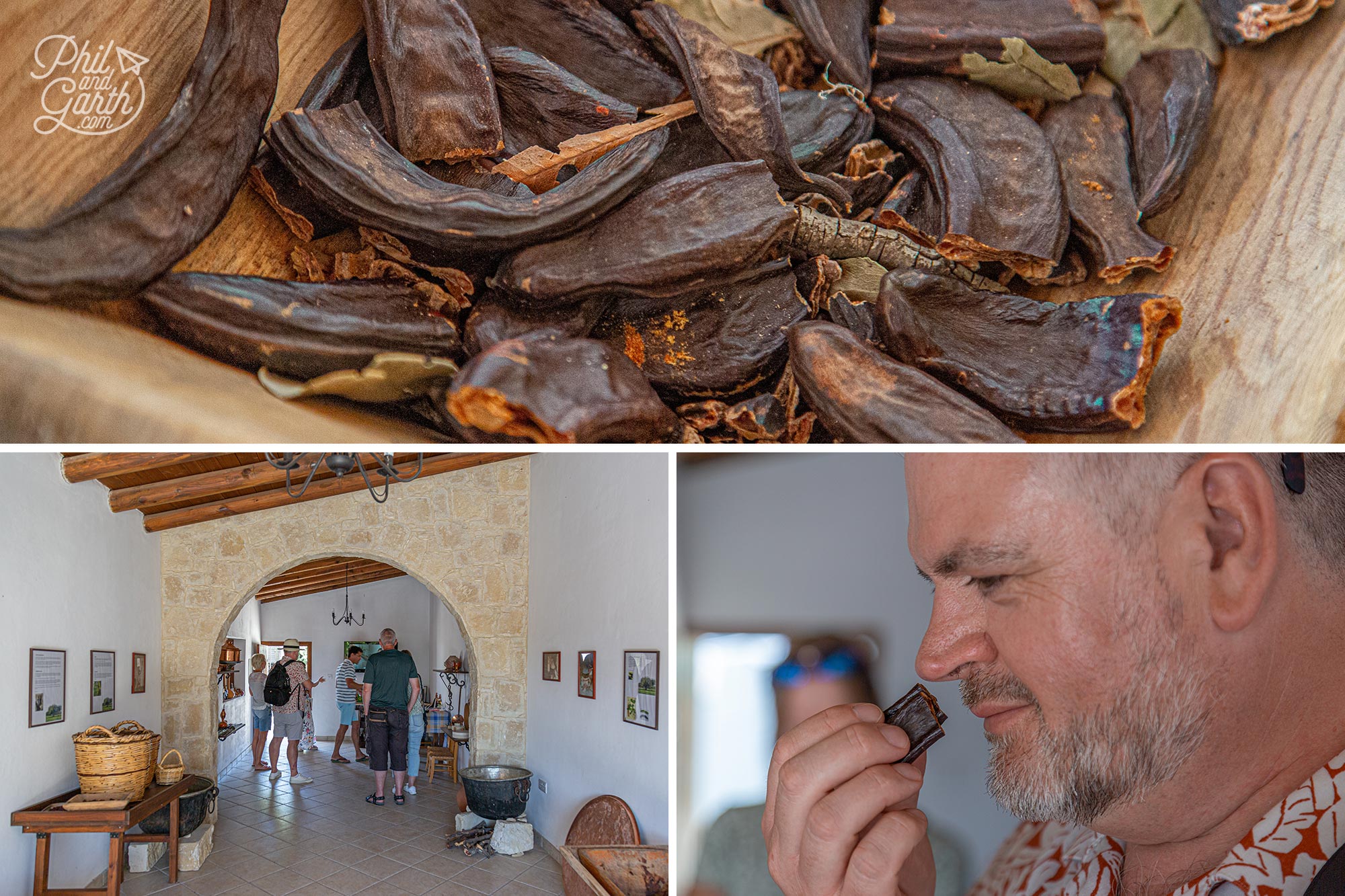
Carob pods
Halloumi Tasting, Anogyra
Our third stop was Stalies Farm – a small dairy producing the freshest halloumi we’ve ever tasted. They supply cheese under the local brand name ‘To Anoyrkatiko’. We checked out their herd of goats – young and old who supply milk for this distinct salty and ‘squeaky’ cheese. Halloumi was invented in Cyprus developed by rural farmers to preserve milk in the hot and arid climate.
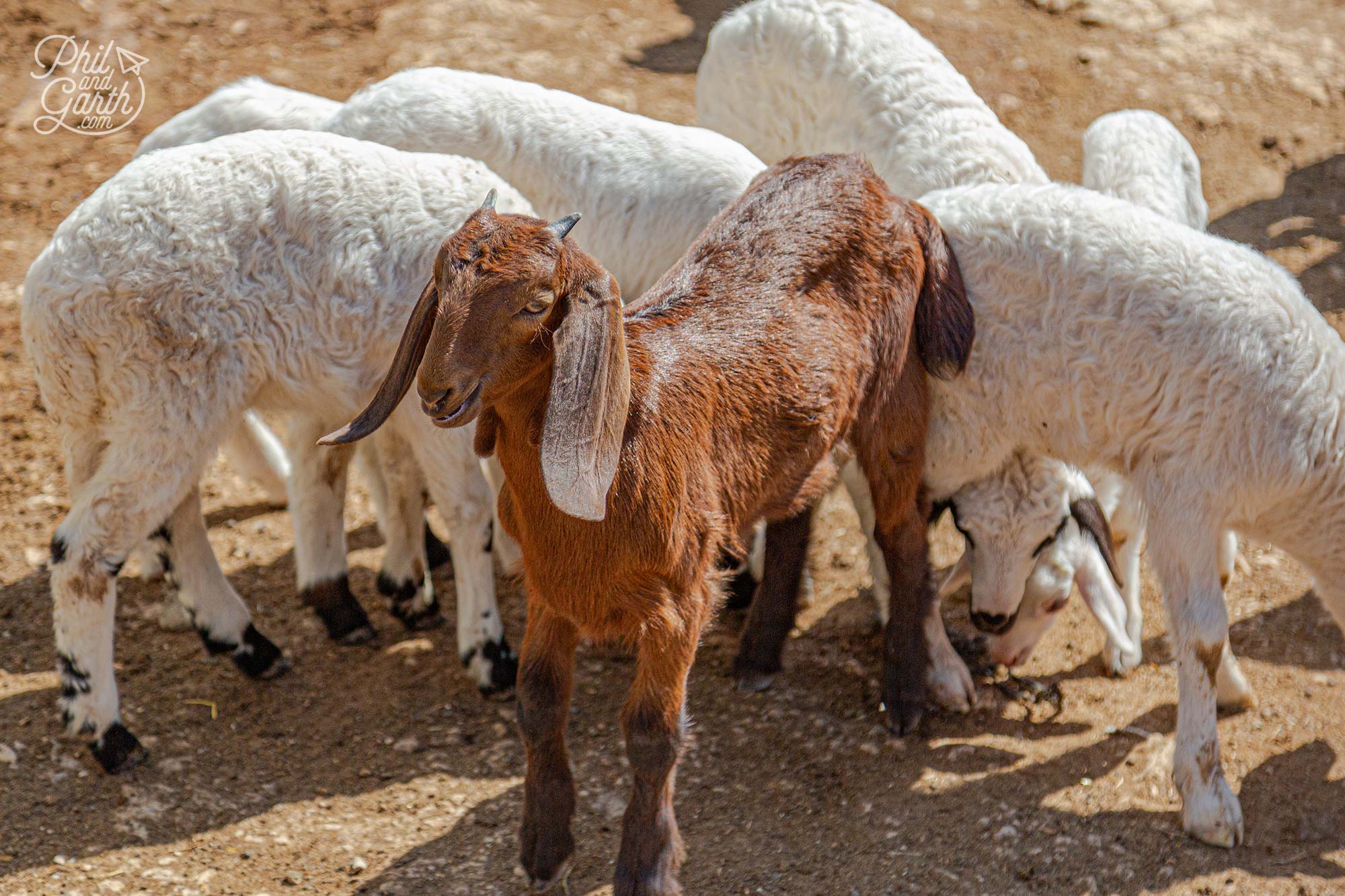
The cute kid goats on the farm
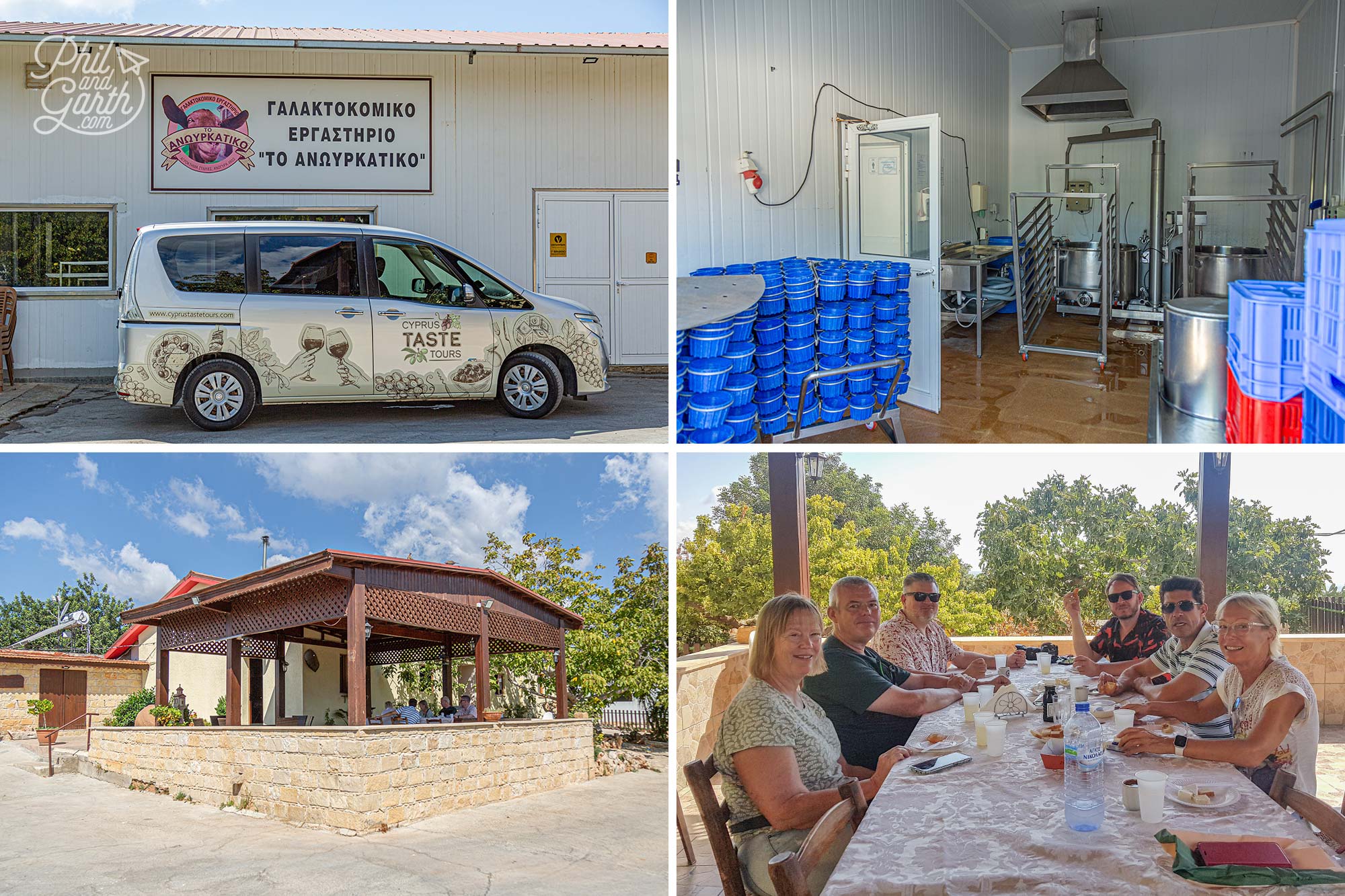
Tasting halloumi at Stalies Farm, Anogyra
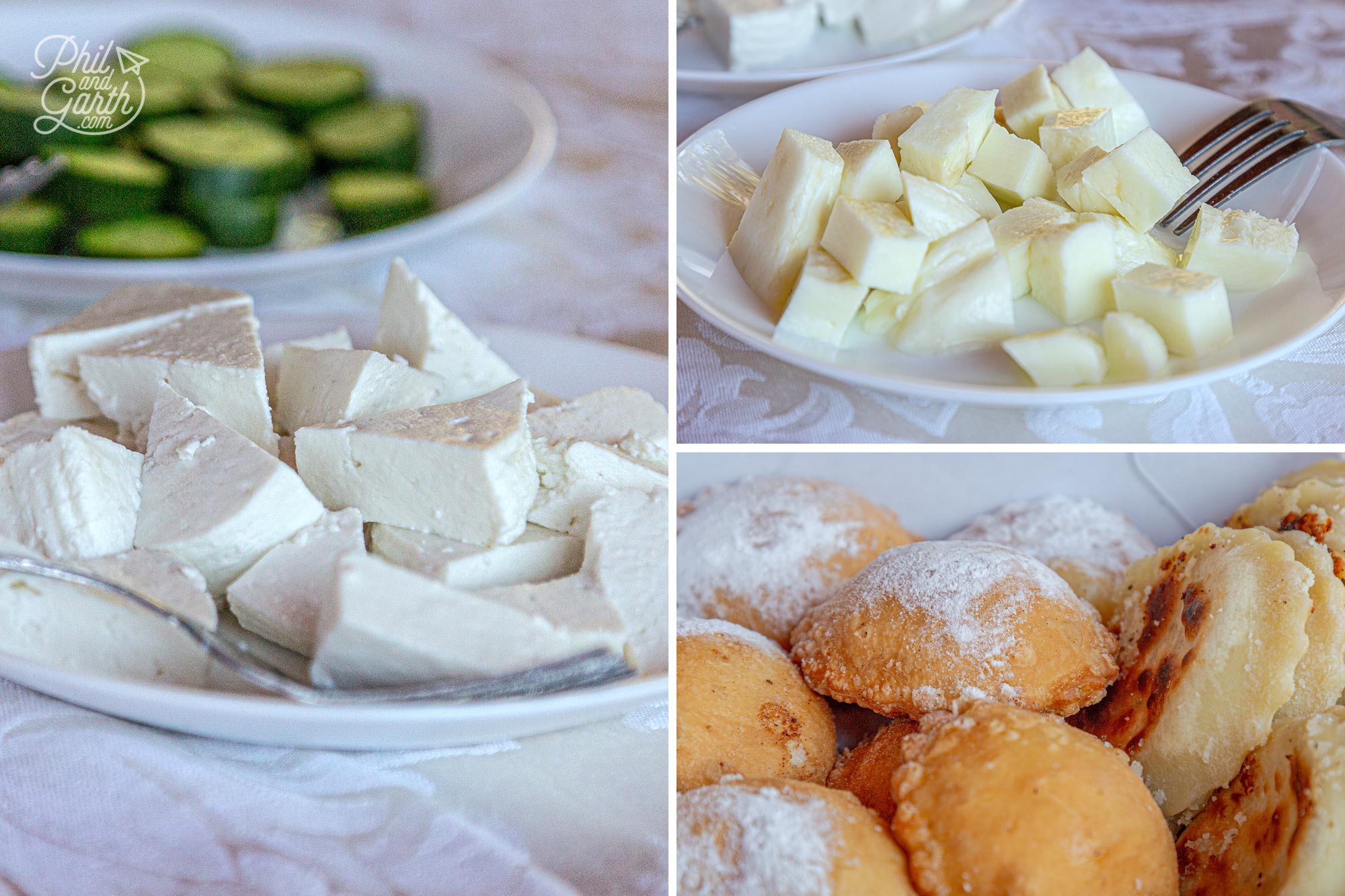
Halloumi cheese tasting
The tasting was so good, we tried three different kings of halloumi – soft, hard and a cream cheese. It tasted so smooth and creamy unlike shop bought halloumi in the UK. We both love it grilled when it goes especially squeaky. We then tried some sweet desserts made with halloumi dusted in icing sugar, which Garth loved.
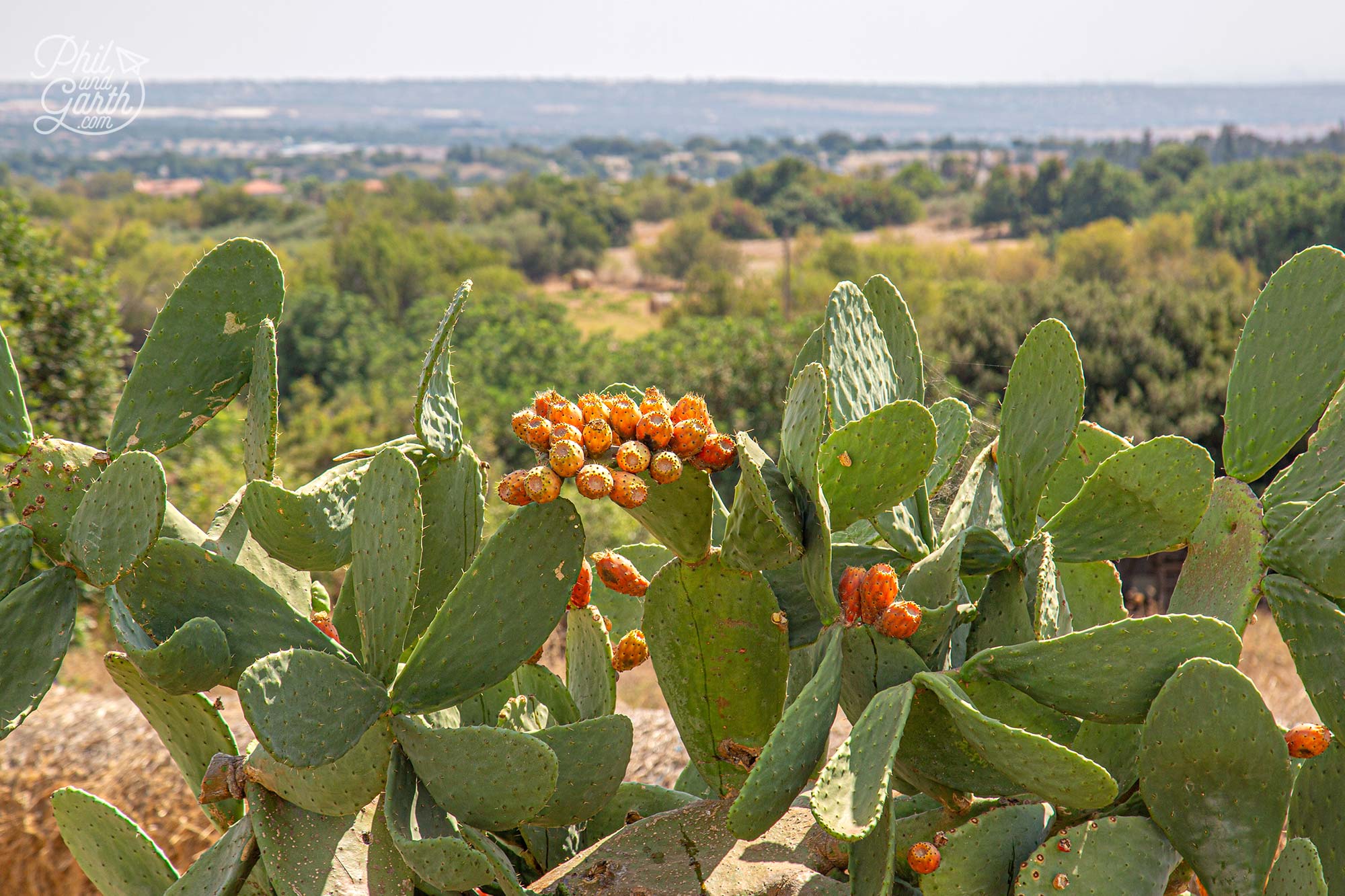
Some lovely rural views from the dairy
Meze Lunch at Omodos
Next Elena drove us past fields of vineyards to the popular mountain village of Omodos. This is a picturesque village, but be warned it’s a little bit of a tourist trap, however it’s still a lovely place to wander around. For our third tasting we tried the town’s signature honey glazed bread from George’s Bakery.
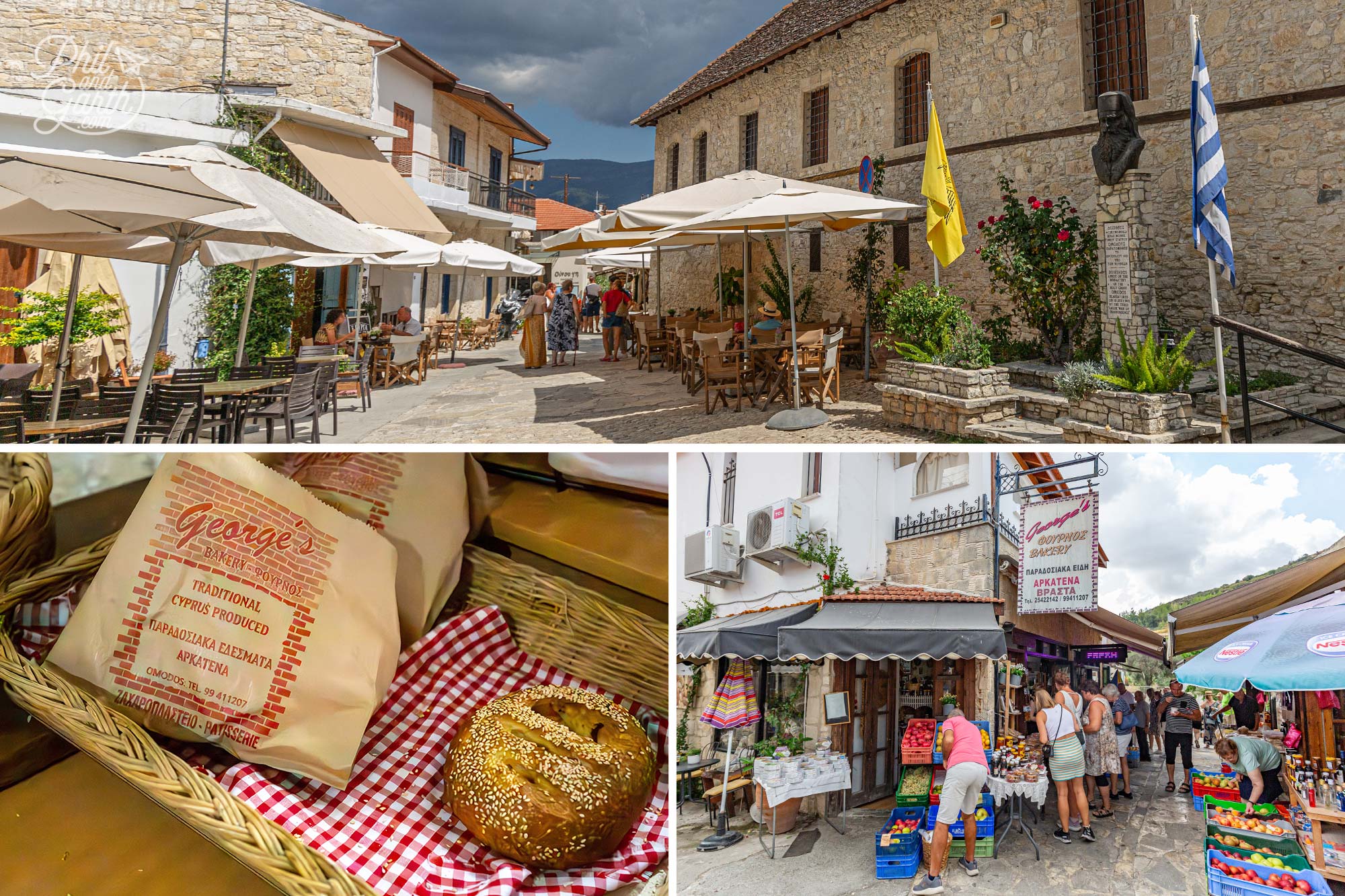
Tasting honey glazed bread in Omodos
After this we had 30 minutes to explore the artisan shops selling unique glassworks and lace. We opted instead for tacky fridge magnet for our collection! We next visited the local Timios Stavros Monastery (also known also as the Holy Cross Monastery) famous for displaying a piece of the robe Jesus war on the cross, located on the altar within a silver frame, you can even see his blood on the cloth.
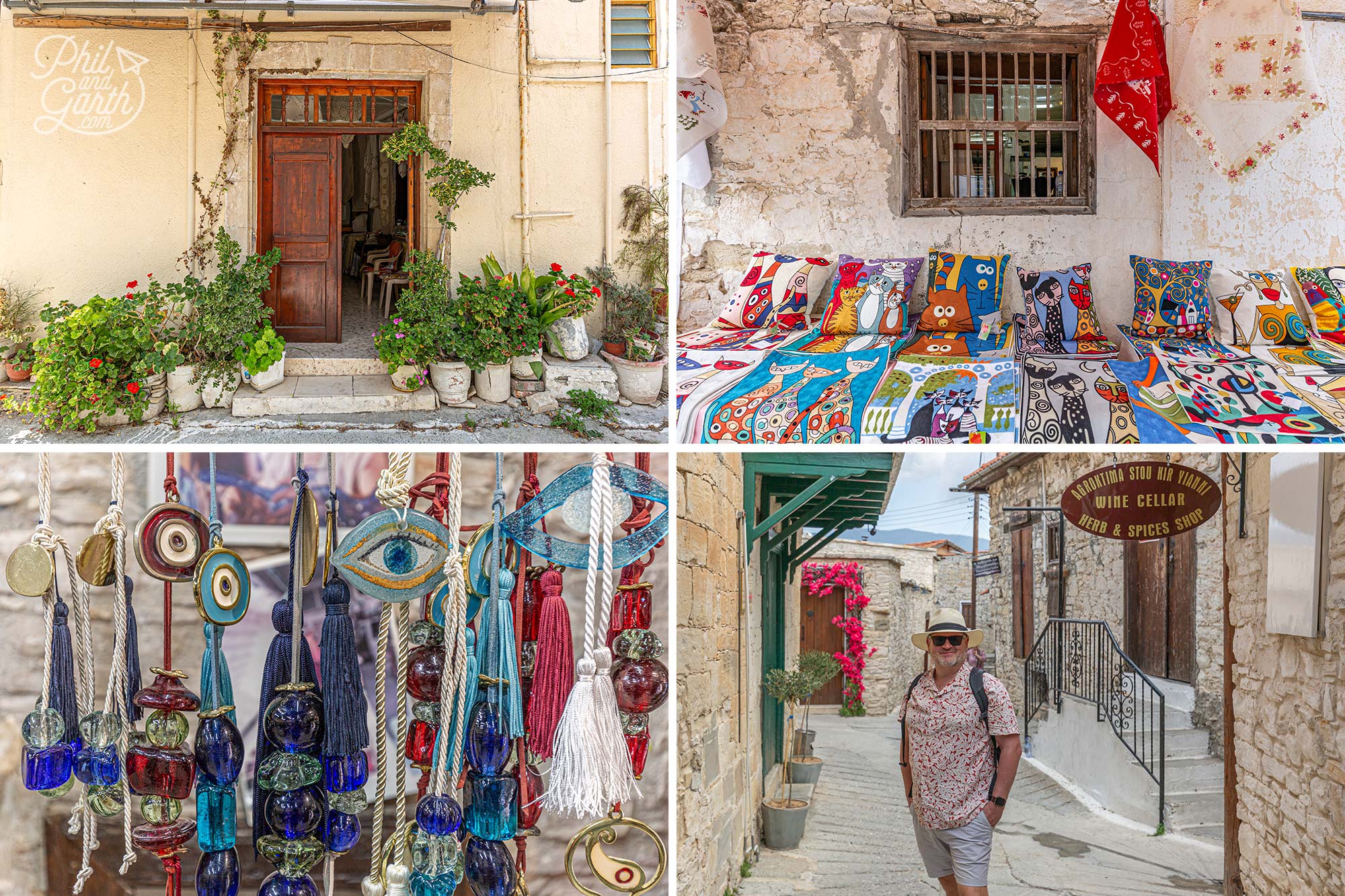
Wandering around the back streets of Omodos
Time for our fifth tasting and a huge Cypriot meze lunch at a taverna called The Black Geese (Μαύρες Χήνες). Tons of food so make sure you’re hungry. Phil loved the moussaka and Garth loved the grilled halloumi. It’s a lovely setting, be sure to check out the little cigar room downstairs.
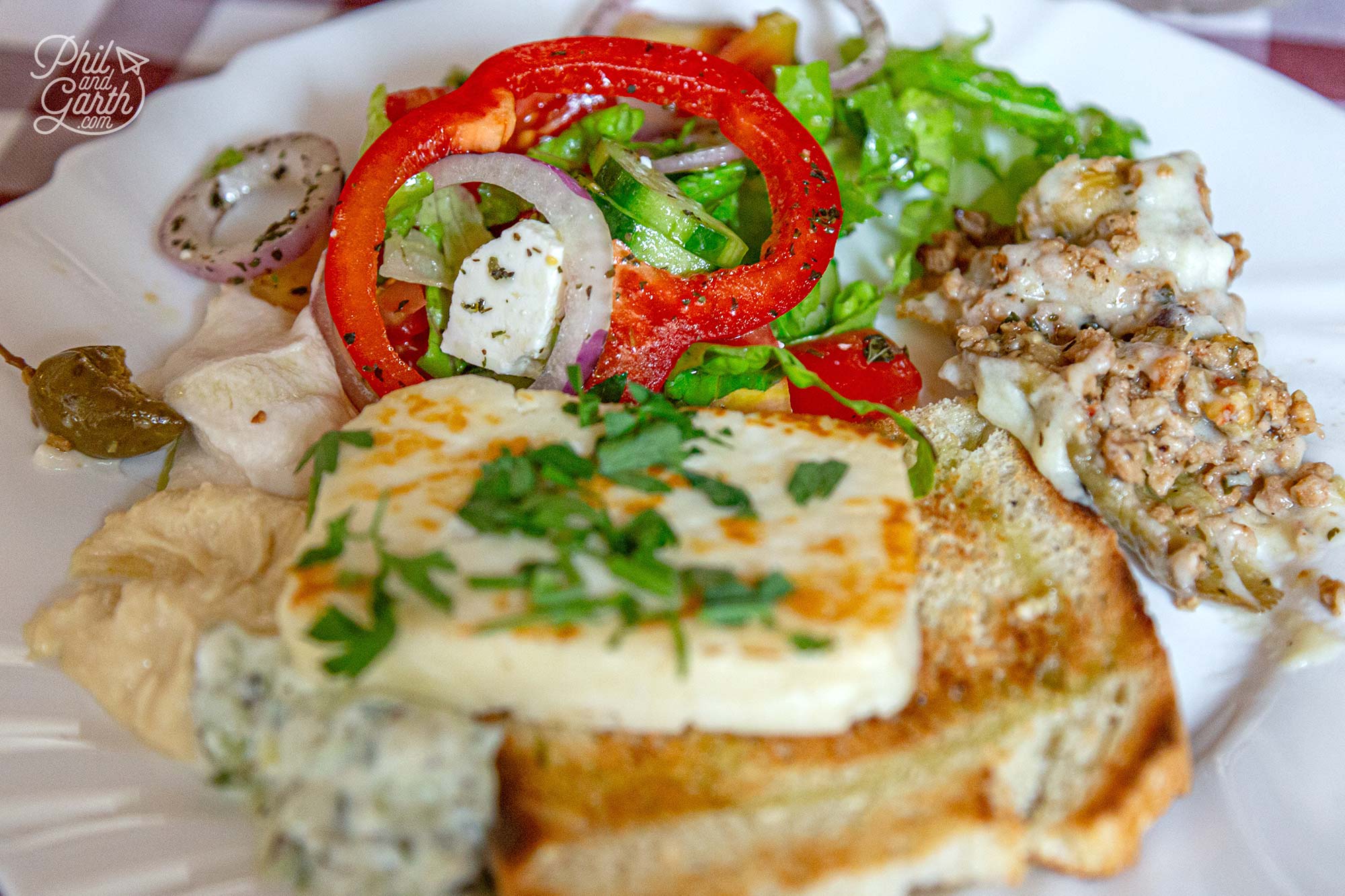
Very tasty meze lunch
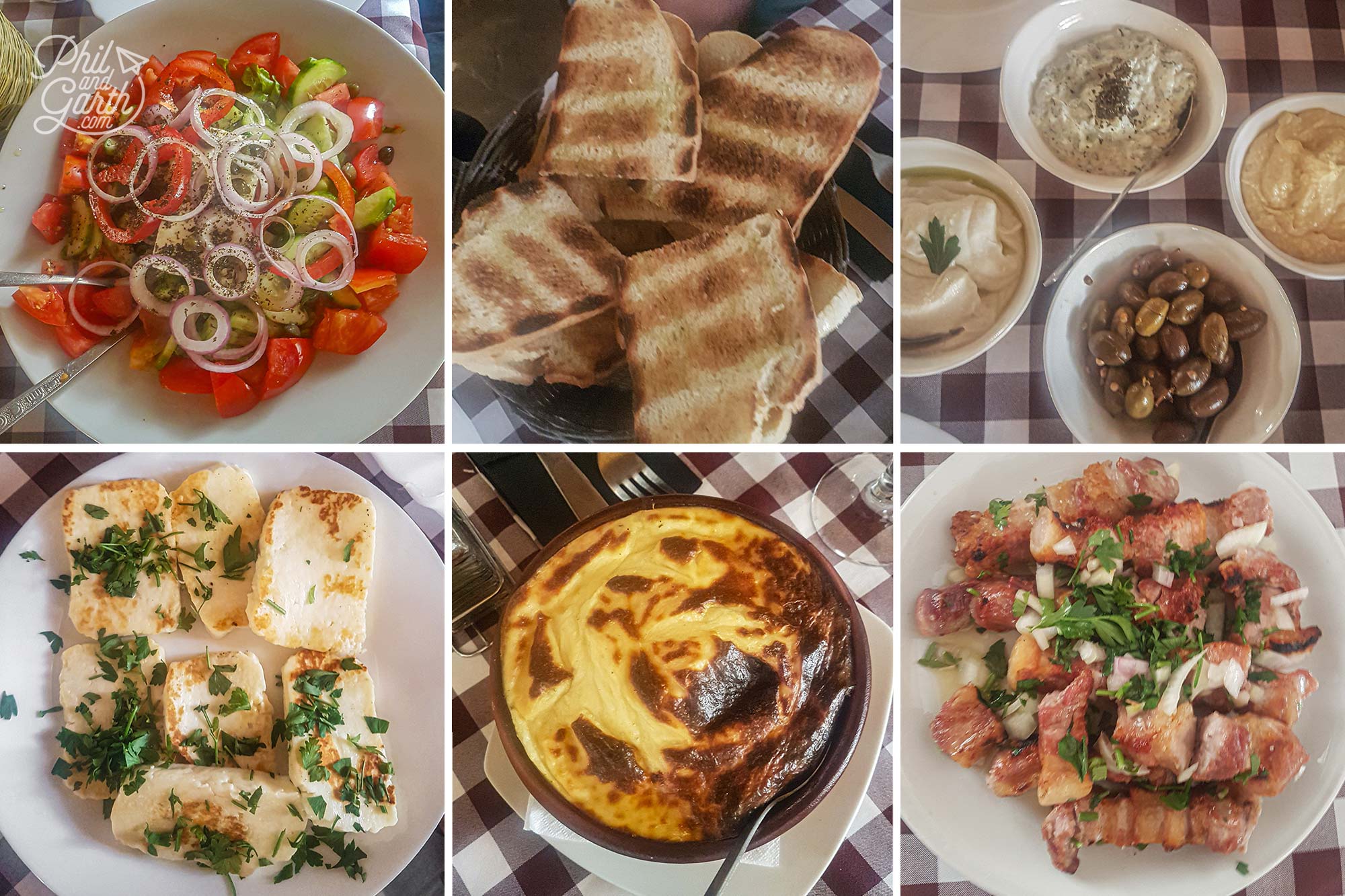
Cypriot meze lunch at The Black Geese
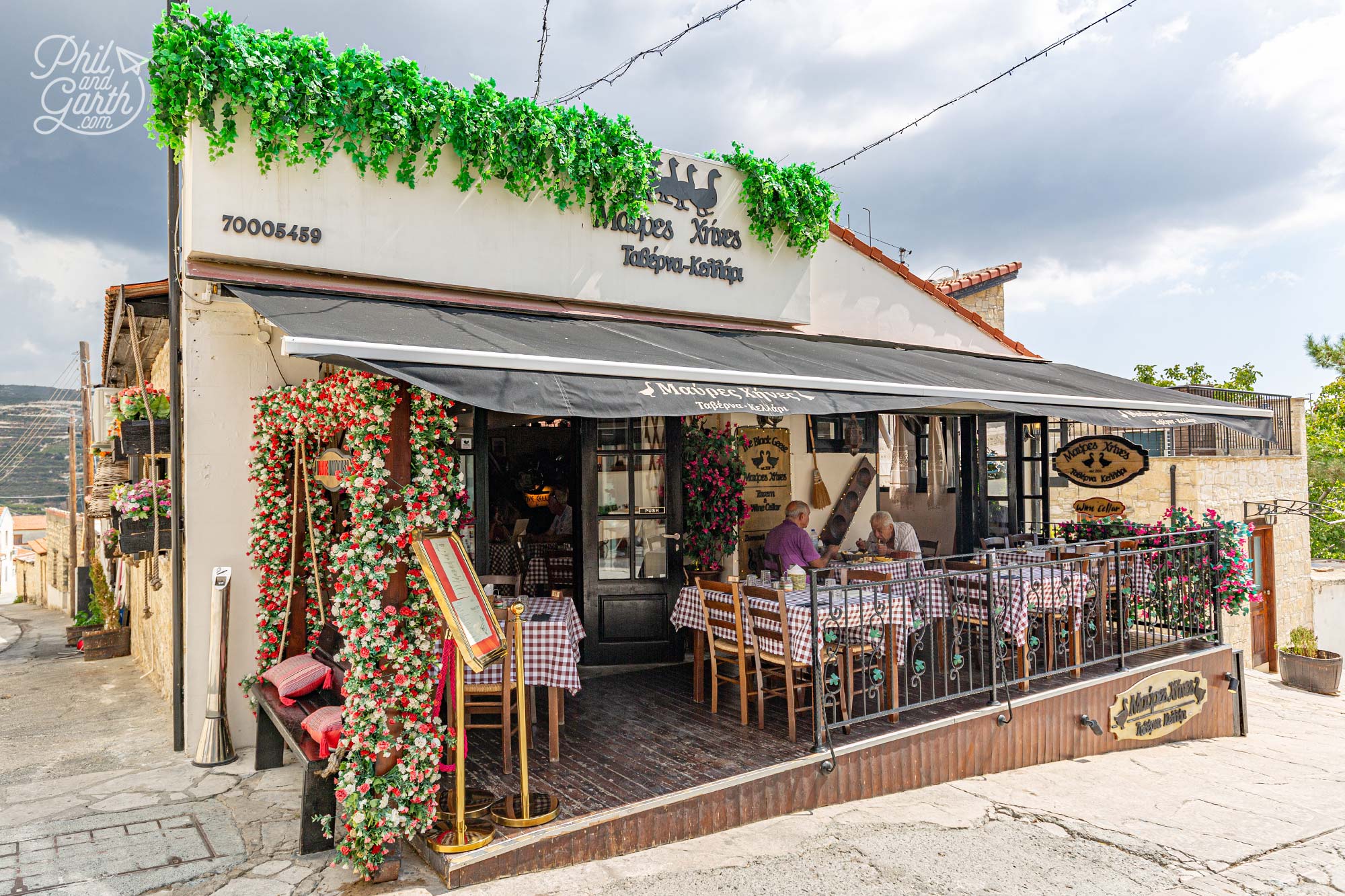
The Black Geese taverna, Omodos
Cyprus Chocolates, Platres
Our fifth stop, and sixth tasting was at a chocolate shop called Cyprus Chocolates in the remote mountainous village of Platres. The owner Sergei is the only Chocolate producer in Cyprus using cocoa beans from around the world. We took part in a tasting class where Sergei taught us how chocolate is produced around the world and how he produces chocolate in Cyprus. We loved his passion and enthusiasm. Garth liked the lavender and caramel flavoured chocolate, Phil isn’t a fan of flavoured chocolate and preferred the pure cocoa. Garth felt cheated learning that white chocolate has no chocolate content, as he loves white Toblerone. Before we left we were treated to a drink of melted hot chocolate.
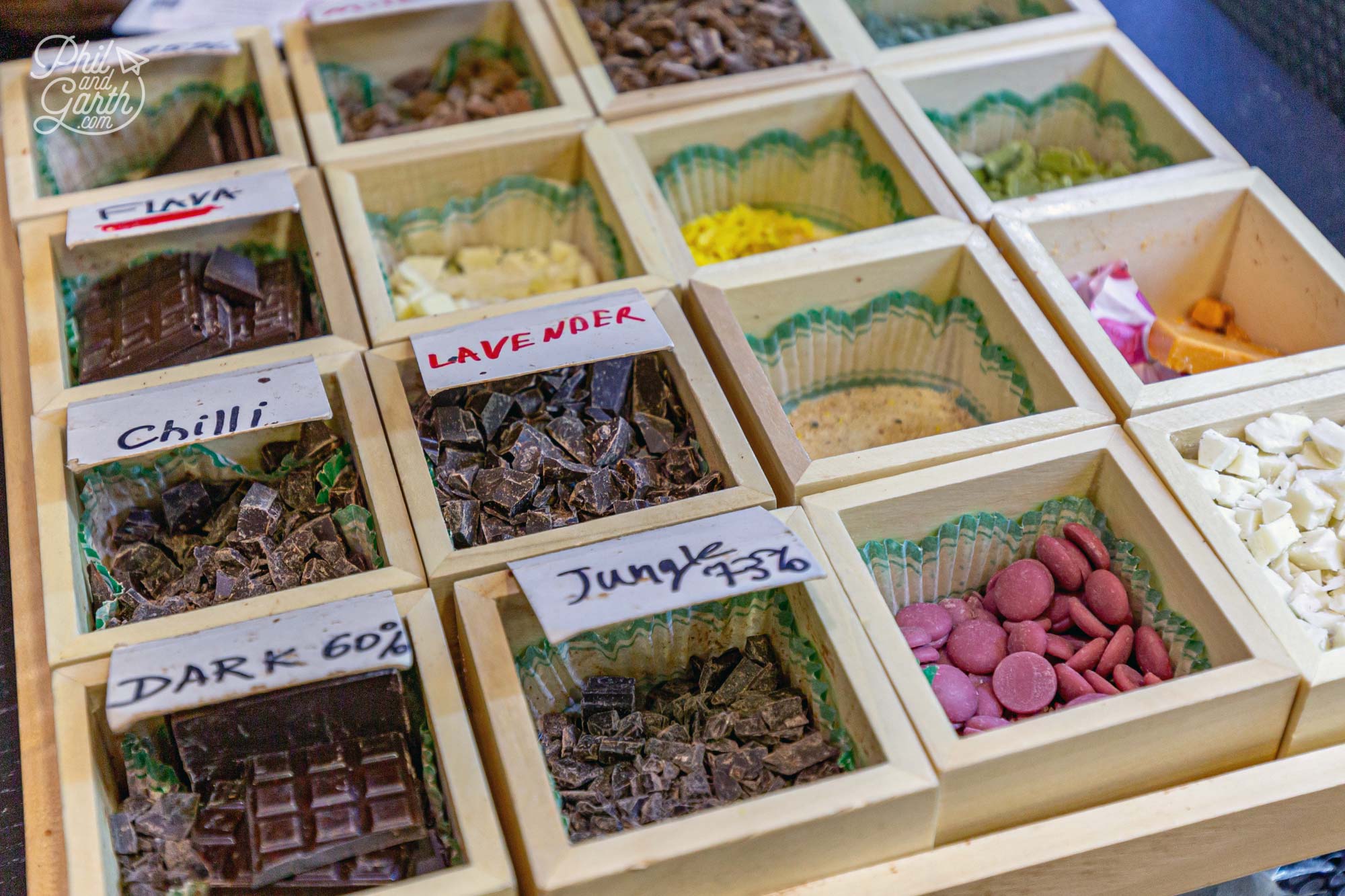
Chocolate tasting at Cyprus Chocolates
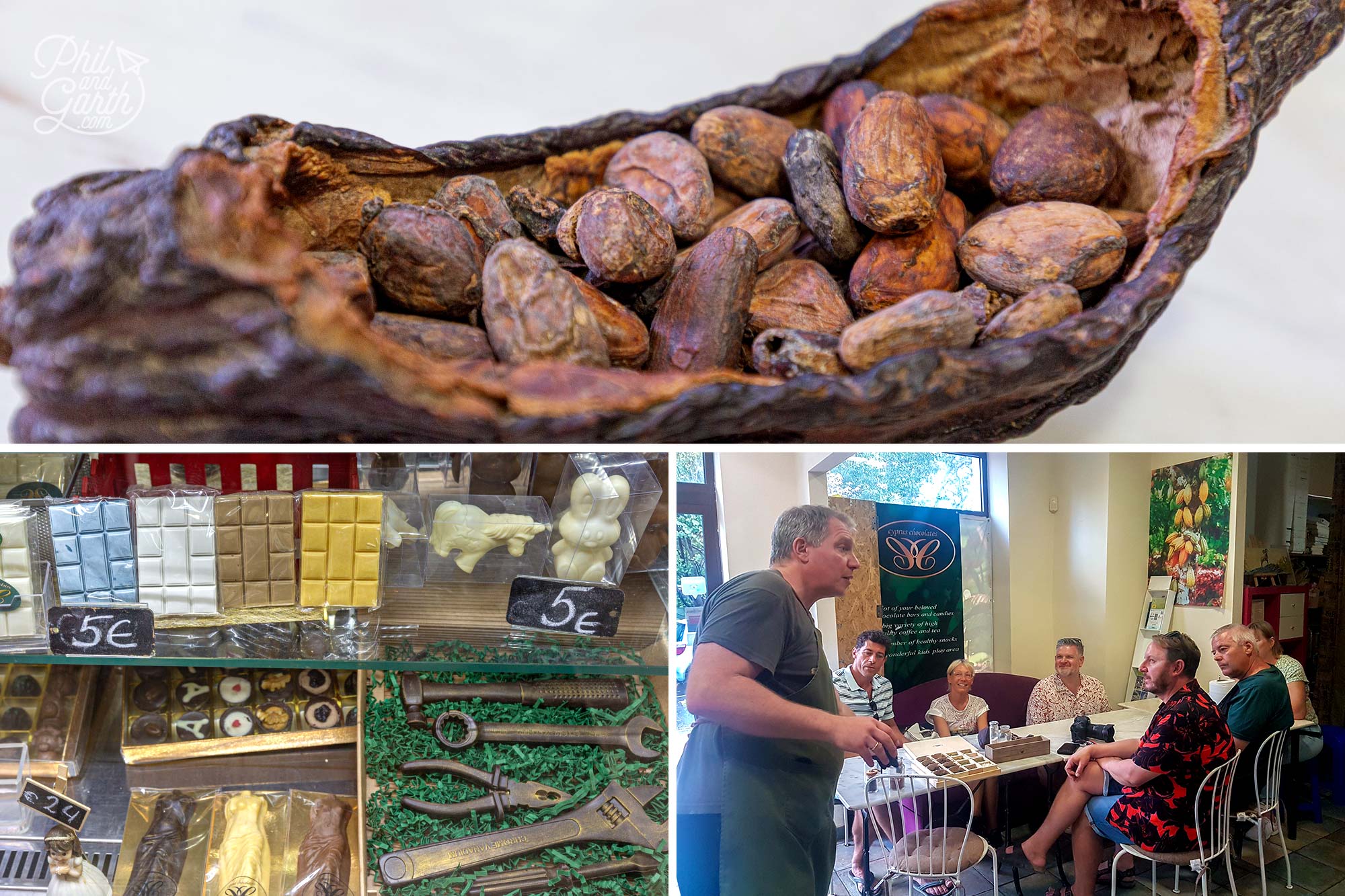
Cyprus Chocolates
Coming back down the mountains reminded us of Tenerife as we drive through the forest of pine trees.
Ayia Mavri Winery, Koilani
Our sixth and final stop was wine tasting at the Ayia Mavri Winery located in the charming village of Koilani in the foothills of the Troodos mountains. The altitude at 900 metres, climate and soil are perfect conditions for the production of wine. The village’s vine plantations date back hundreds of years, in the old days every house in the village housed a small winery. Ayia Mavri Winery was founded in 1983, and produce 50,000 bottles of wine every year. They use indigenous vines like Mavro, Xynisteri, Moscato and Lefkada.
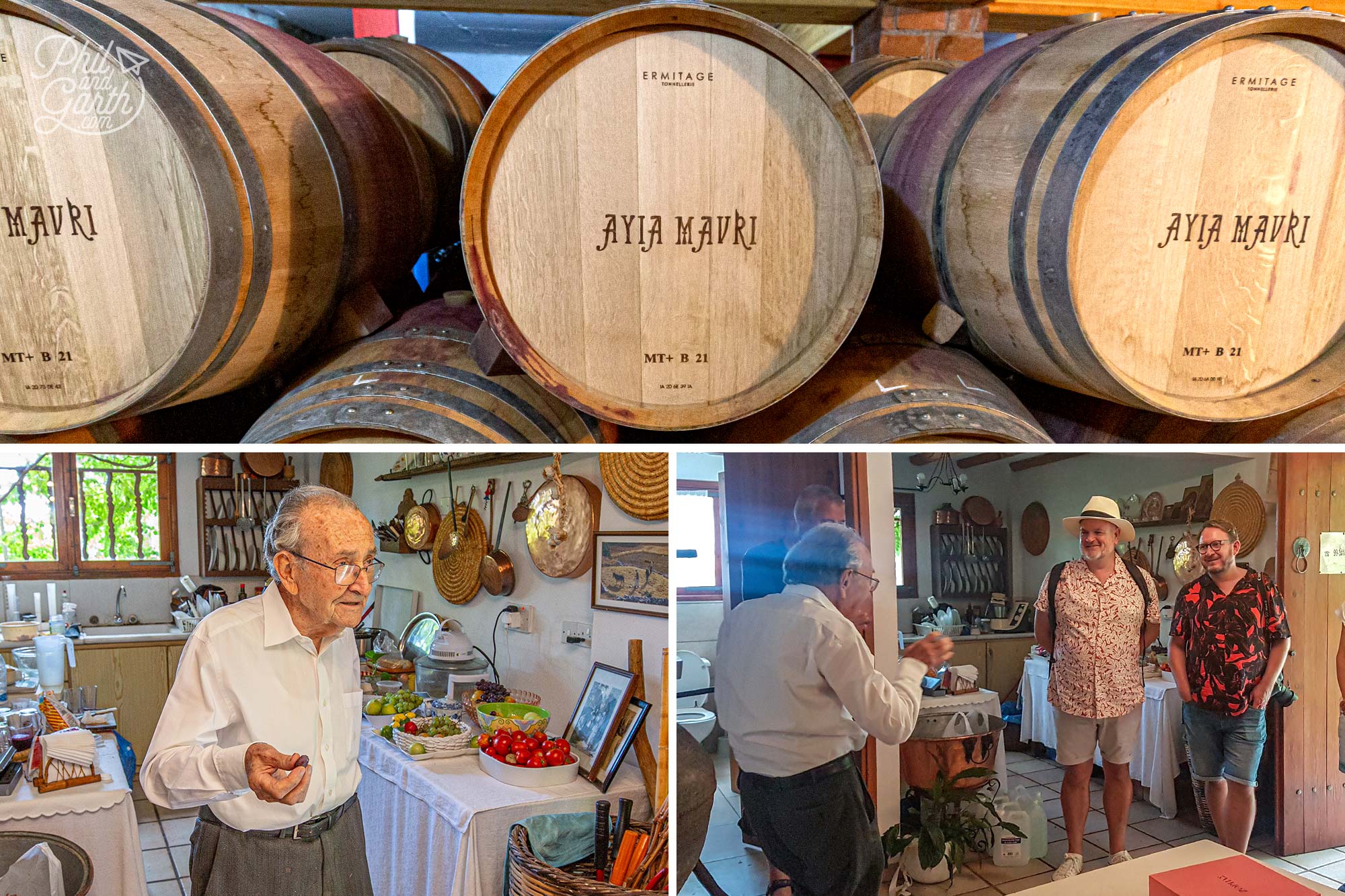
Owner Yiannis explains hows it’s done at Ayia Mavri Winery
This was our highlight of the tour and to be honest our visit to Cyprus. We met the original owner Yiannis and his wife, who were humble, hospitable and very welcoming. Yiannis started by explaining the alcohol contents of grapes and how they check if the grapes are ready to harvest using a special measuring tool. We loved Yiannis enthusiasm for storytelling, the winery is clearly a labour of love for him. We also loved the fact this tour was so authentic, as we’ve done wine tours in Stellenbosch, South Africa, but it was never with the owners.
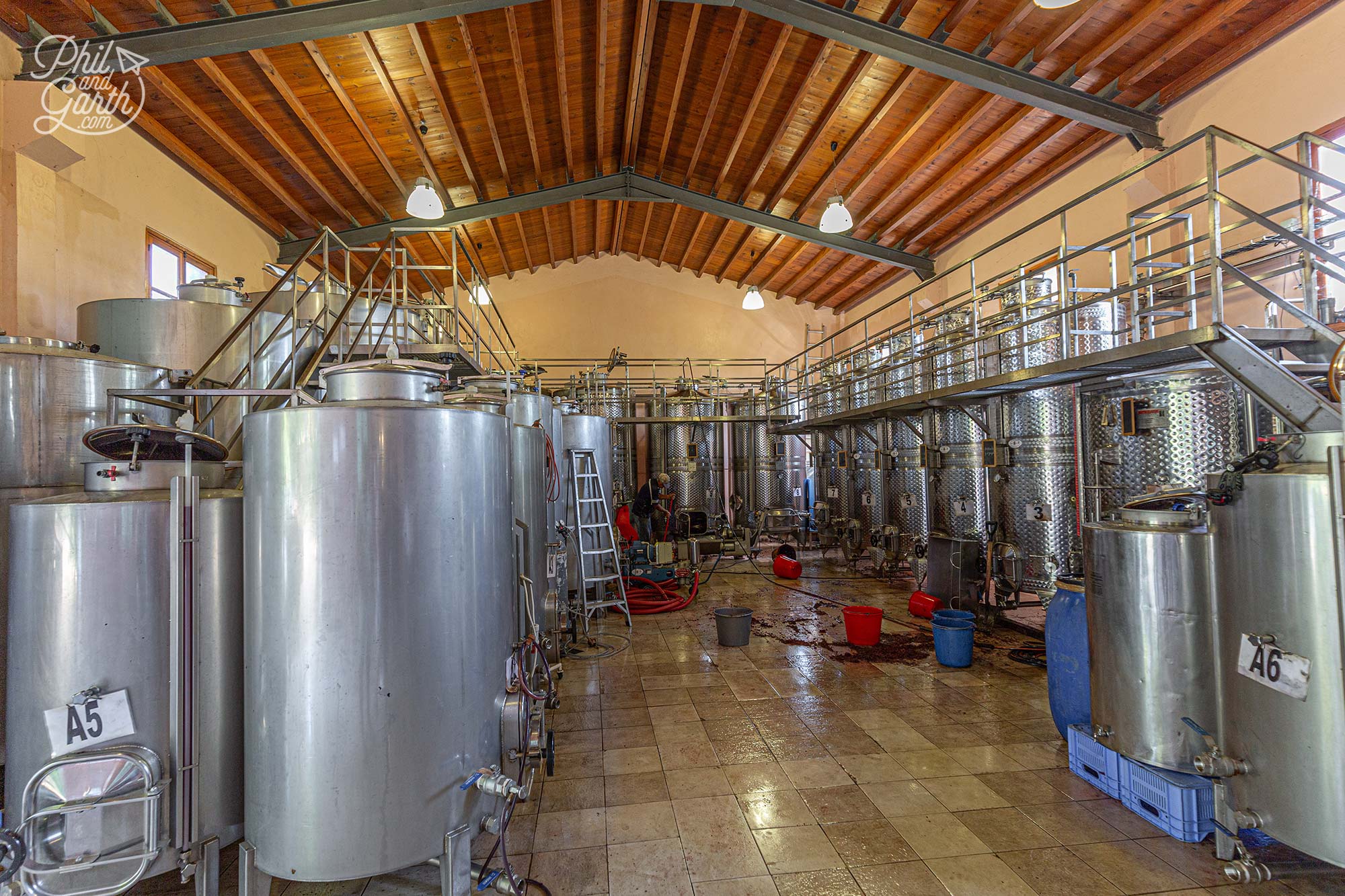
Heart of production at the Ayia Mavri Winery
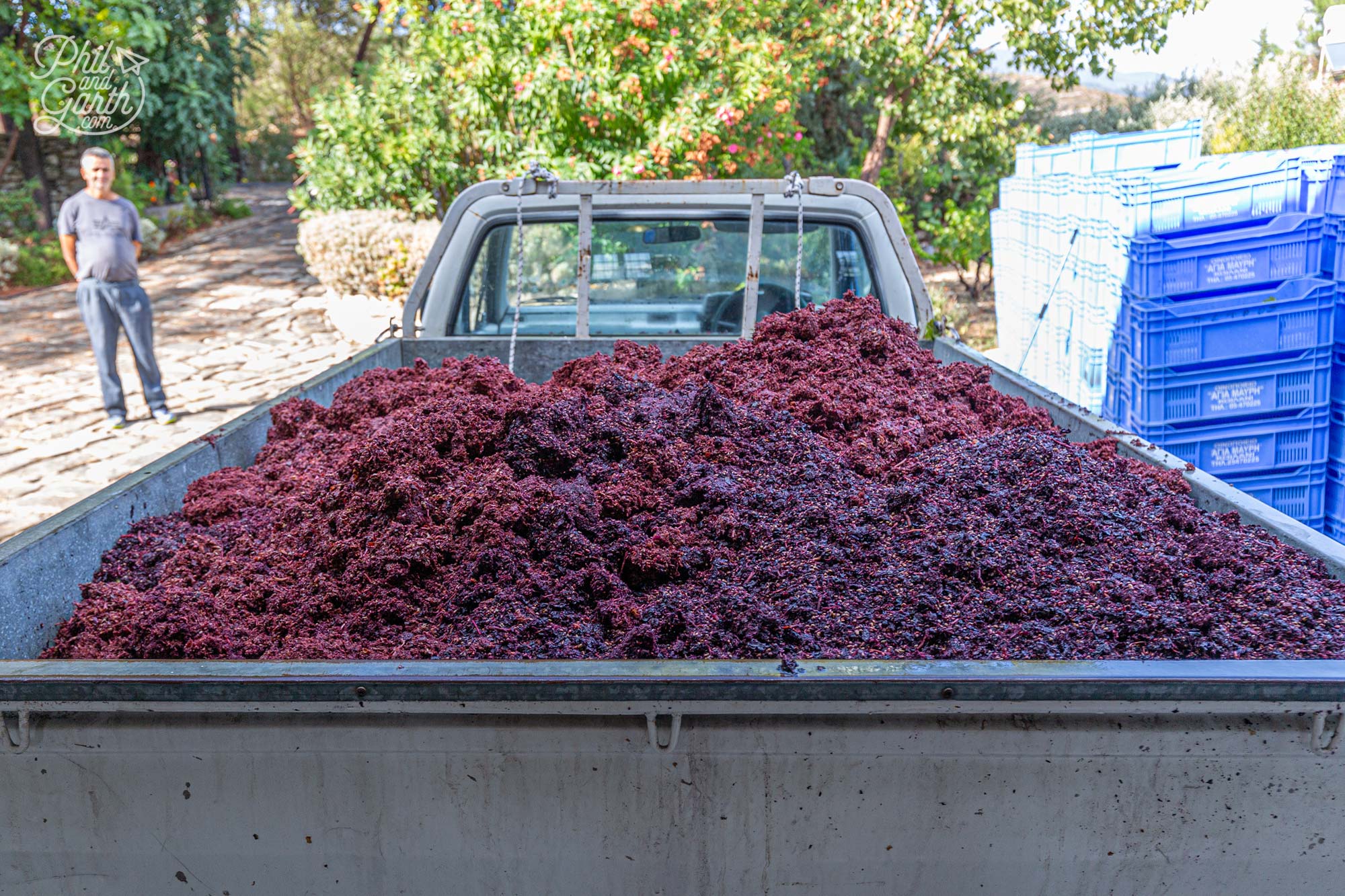
The waste grapes is used as fertiliser
We then visited the wine vaults with rows of bottle racks and Yiannis proudly showed off his wall of certificates and awards they’d won, it’s clearly quality over quantity. Then it was time for the best bit – tasting Cyprus wines! We tried about 10 different bottles, including a very special Shiraz hinted with chilli. Finished off with a small shot of schnapps. Phil really liked the Dry Muscat, Oymhses, so he bought two bottles to take back to our villa.
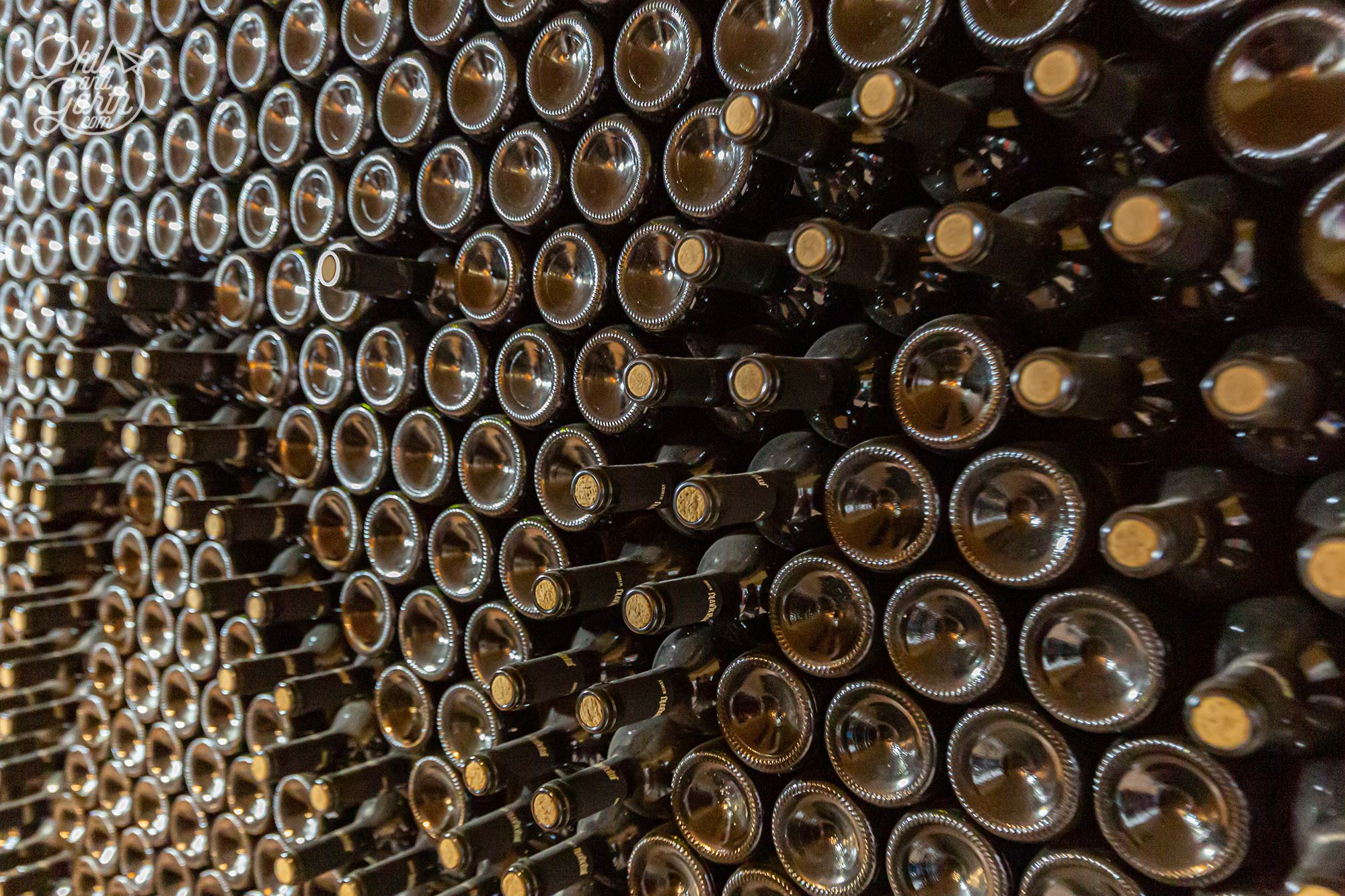
The wine cellar
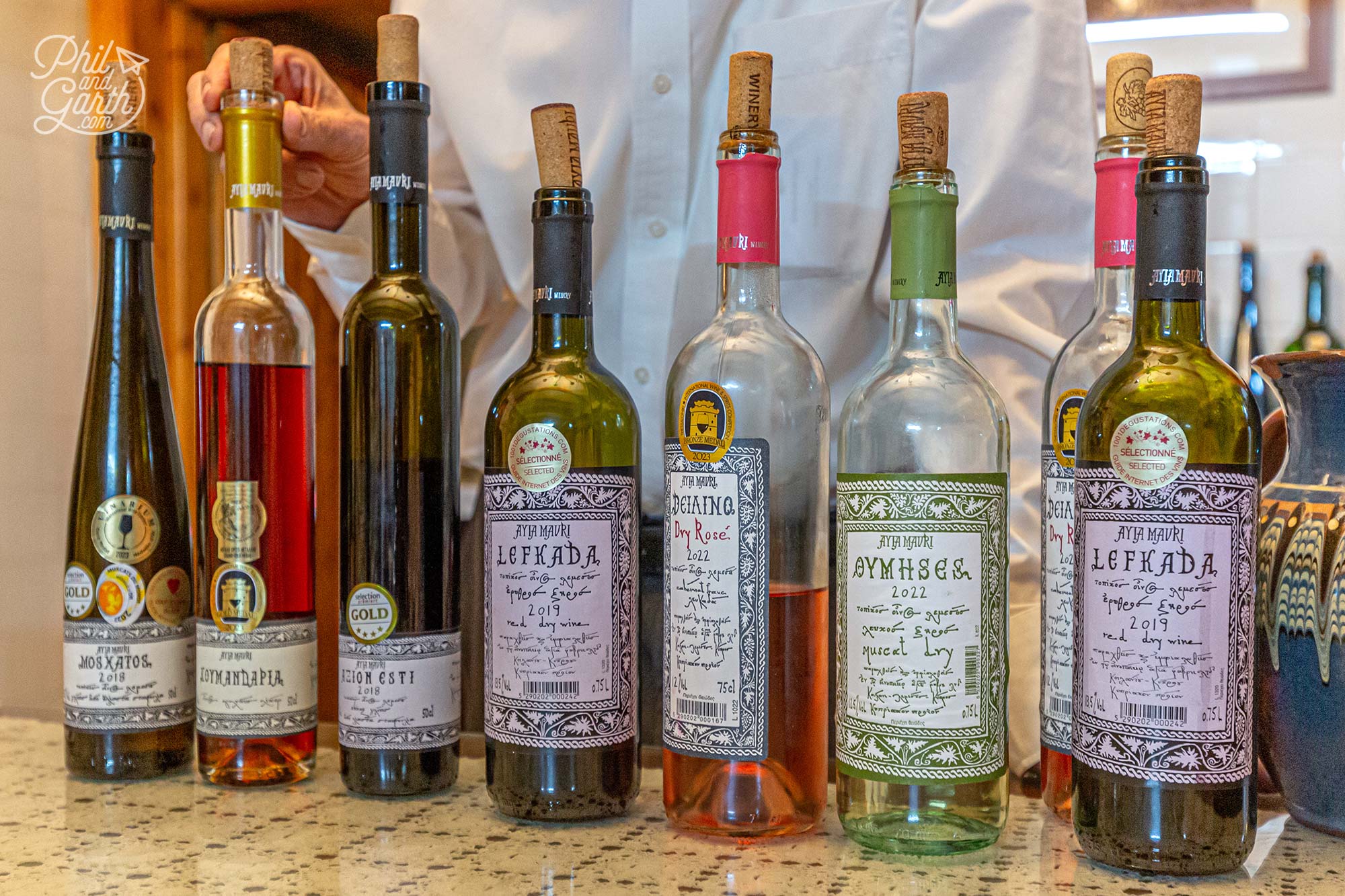
All the different wines we tasted
A fabulous experience and a great way to end our tour, can highly recommend visiting.
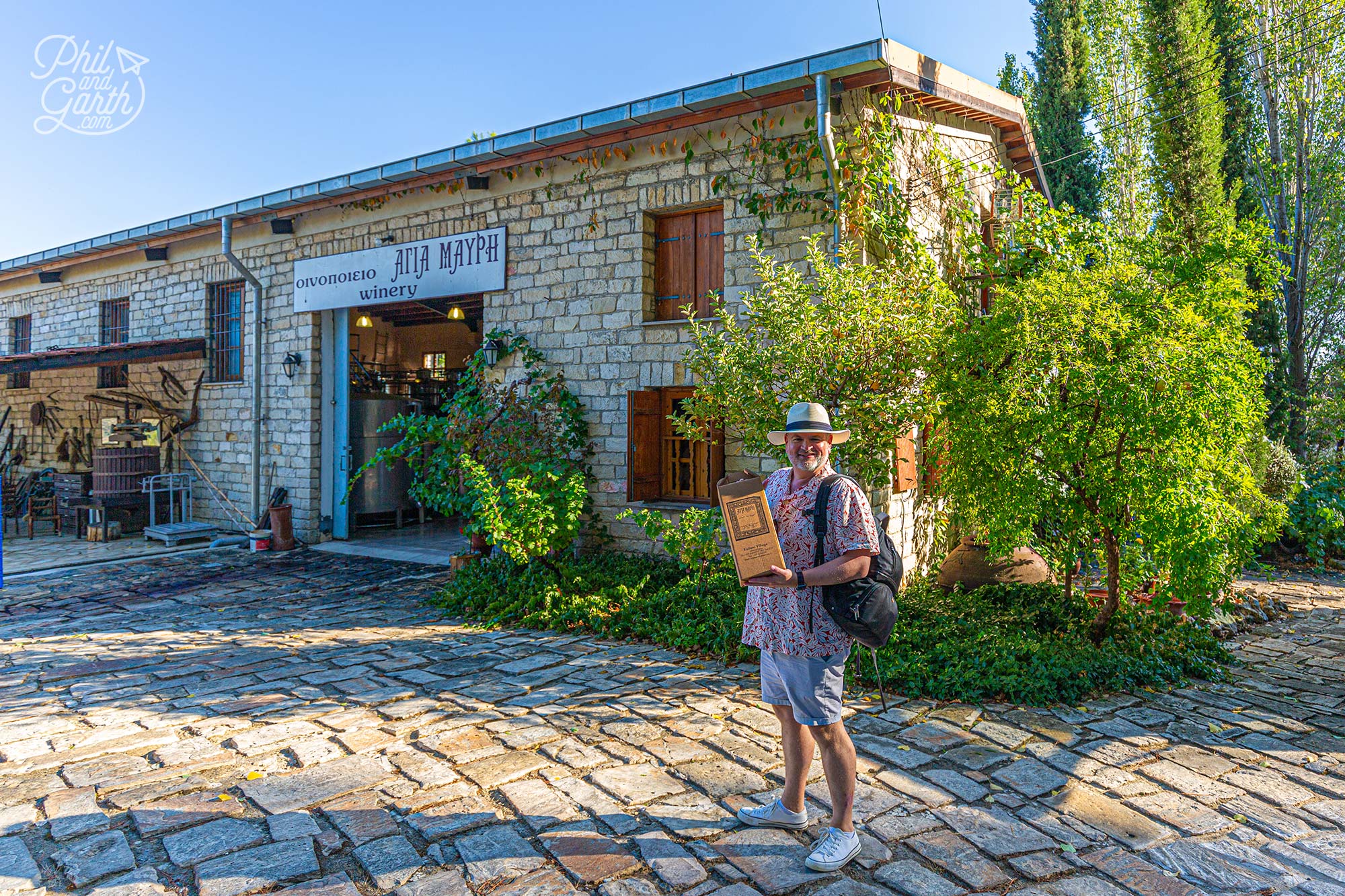
Phil with his purchase of 2 bottles of Dry Muscat
Paphos, Cyprus Practical Information and Useful Advice
Phil and Garth’s Top 5 Paphos Tips
- Tip #1: Avoid talking politics as the Greek/Turkish conflict is still contentious for most people.
- Tip #2: Take your passport to Nicosia if you want to cross to the Turkish side.
- Tip #3: Carry plenty of water with you when sightseeing in the summer.
- Tip #4: Avoid visiting the Kato Paphos Archaeological Park at midday its very hot.
- Tip #5: Visit the Ayia Mavri Winery.
Paphos, Cyprus FAQs
- What’s Cyprus airport called? Cyprus has 2 airports – Larnaca International (LCA) and Paphos International (PFO)
- What’s the flight time from UK to Cyprus? 4 hours 40 minutes.
- What side of the road do your drive on in Cyprus? The left hand side like the UK.
- What time zone is Cyprus? GMT+2. Cyprus is two hours ahead of GMT.
- Electricity – same 3 pin plugs as the UK.
- What language is spoken in Cyprus? Greek and Turkish however most Cypriots speak English.
- What currency is used in Paphos? Euro.
- What is Cyprus famous for? Halloumi cheese, beaches and ancient sights.
- What’s a fun fact about Cyprus? Halloumi cheese was invented on Cyprus. Made from a mixture of goat’s and sheep milk.
- When is the best time to visit Cyprus? Spring April to May and Autumn September to October. Temperatures can even reach 30ºC in November.
- When is the worst time to visit to Cyprus? Peak summer holiday season June – August because it’s very hot and resorts will be packed.
- What’s the best way to get around Cyprus? Hiring a car is the best way to explore, you drive on the left like the UK.
- What’s a Cyprus local food dish? Souvlaki is skewered meat, halloumi is Garth’s fav squeaky cheese, and dolmades stuffed vine leaves.
- What’s the best souvenir to buy in Cyprus? Lacework from a traditional village.
- Is Paphos worth visiting? Yes! definitely.
How We Did It
- We stayed for a week at the Aphrodite Hills Holiday Residences on a package holiday with Jet2 which included car hire with Aercar Rentals, pretty excellent value all round. The villa was just a 20 minute drive from the airport.
- We booked the food tour with Cyprus Taste Tours. It cost us £94 each including collection and drop off from our villa.


